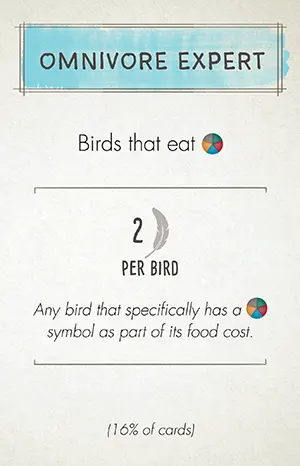What’s this about?
This is an official rules reference for Wingspan by Stonemaier Games.
It’s great for finding a specific rule quickly. It's also an excellent supplement to the rulebook included in the box, when watching a how-to-play video, or while teaching the game.
Dynamic Rules
This site automatically adjusts the rules to fit the expansions and variants you choose in settings .
Usage Tips
Back & Forward Nav: Think of each rule entry as a separate webpage. If you want to jump back, hit your Back button.
Check the Index : Don’t see what you're looking for? The Index has every term in the game.
Install it: This site is a (Progressive Web App). You can install it as a standalone app that is lightning fast, and works even when you're offline.
Link to a rule: Want to share a link to a particular rule? Just click its title!
Credits
Designed by Elizabeth Hargrave
Illustrated by Natalia Rojas, Ana María Martínez Jaramillo, and Beth Sobel
-
Bird information comes from the All About Birds website by the Cornell Lab of Ornithology (allaboutbirds.org), the Audubon Guide to North American Birds (www.audubon.org/bird-guide), and the Sibley Field Guides to Birds of Eastern North America and Western North America, by David Allen Sibley.
-
Tower Rex (towerrex.com) designed the birdfeeder dice tower.
-
Photographic sources for the birds come from Glenn Bartley, Alan Murphy, Roman T. Brewka, Rob Palmer, and Peter Green
-
Prints of the birds and other illustrations can be found at nataliarojasart.com and anammartinez.com
-
Typeface Cardenio Modern designed by Nils Cordes, nilscordes.com.
Turn Overview
Place an action cube on the leftmost exposed slot in row on your player mat to take 1 of the following 4 actions:
Play One Bird
Select 1 bird card from your hand to play.
Discard the number of eggs from bird cards equal to the number of shown in the column where you want to/will place the bird.
Discard the shown food tokens (if , then there is no food cost). Wild (
 ) means you may use any food. You may spend any 2 food tokens to use them as any 1 food token.
) means you may use any food. You may spend any 2 food tokens to use them as any 1 food token.Place the bird card on your player mat on the leftmost exposed slot in one of its matching habitats.
If the bird has a “when played” power, activate it (for that bird only). It may interact with the Automa.
Gain Food
Gain a number of food tokens equal to the number of
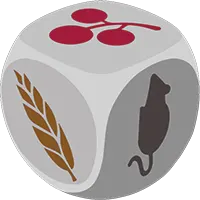 shown on your leftmost exposed forest slot by removing the food dice from the birdfeeder and gaining the matching food tokens (, , or means you may take either one).
shown on your leftmost exposed forest slot by removing the food dice from the birdfeeder and gaining the matching food tokens (, , or means you may take either one).If the leftmost exposed forest slot shows
 , you may discard 1 bird card from your hand to remove one additional die and take its corresponding food.
, you may discard 1 bird card from your hand to remove one additional die and take its corresponding food.Activate any brown forest bird powers you wish, right to left. They may interact with the Automa.
Lay Eggs
Gain a number of eggs equal to the number of shown on your leftmost exposed grassland slot. Place them on bird cards (up to the birds’ egg limits; any excess is lost).
If the leftmost exposed grassland slot shows
 , you may pay 1 food token to gain one additional egg.
, you may pay 1 food token to gain one additional egg.Activate any brown grassland bird powers you wish, right to left. They may interact with the Automa.
Draw Cards
Draw bird cards equal to the number of shown on your leftmost exposed wetland slot. Draw from the face-up cards or the top of the bird deck. Do not replace the face-up cards until end of turn.
If the leftmost exposed wetland slot shows , you may discard 1 egg to gain one additional card.
Activate any brown wetland bird powers you wish, right to left. They may interact with the Automa.
At any point during your turn, you can give exchange resources other players.
On Automa’s turn, she performs the actions on the Automa card for the current round.
Draw Cards
- Discard all 3 bird cards from bird tray. Automa draws 1 from the bird deck and keeps it, face-down.
- Place a token on the Duet map, based on the Duet tracker.
Play a Bird
- Take all bird cards that match bonus card. Automa keeps highest point value card, faceup, and discards any others.
- If none match, Automa draws 1 and keeps it, face-down.
- Place a token on the Duet Map based on the End-of-round Goal and the Duet Tracker
Lay Eggs
- Give Automa 1 egg for each egg icon shown.
 Gain Food
Gain Food
- If all dice show the same face, reroll all.
- Follow key, left to right, match first face type in birdfeeder and remove all of those dice.
Activate pink powers
- Activate all pink powers of bird cards on your player mat (the Automa does nothing).
Place End-of-round Cube
- Place 1 action cube on the current round’s goal tile.
Remove End-of-round Cube
- Remove 1 action cube from the current round’s goal tile, if possible.
Round Structure
Wingspan is played over 4 rounds. During each round, players take turns—proceeding clockwise—until each player has used all of their available action cubes.
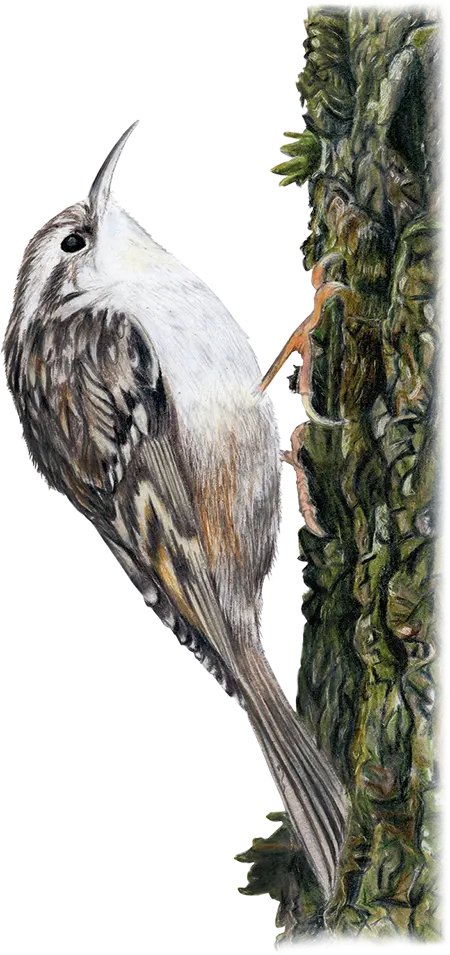
When all players have placed all of their action cubes, the round is over. Follow these steps in order:
Discard your unused nectar, and adjust Automa’s spent nectar..
Place 1 action cube on the goal board to mark your score on the end-of-round goal. Do the same for the Automa.
Score End-of-round goals for the Automa.
- Mark her rank on the goal board.
- Return her unused cubes to her supply.
- Advance her end-of-round goal scoring card.
-
If all players tied or beat Automarazzi for the end-of-round goal, each player gains from the supply to place on any bird on their player mat (egg limit rule applies).
Remove all action cubes from your player mat.
Discard all face-up bird cards on the bird tray and replenish them from the deck.
-
If Round 4 is over, go to game end & scoring. Otherwise, pass the first player token clockwise. Otherwise, pass the first player token clockwise, but Automarazzi still always goes last. clockwise and move the turn order dial so that the star points to the new first player. to the player who came in second on the end-of-round goal. If the players tied, then pass it to the other player.
-
Flip the current round tracker card so the next round shows in the banner at the top, and its arrow is pointing to the right.
Do the same for the Duet map tracker card, placing it immediately to its right of the current round tracker card.
Remove (and return to the box) the Automa card that specifies “Remove after round” for the round you just completed. Reshuffle the Automa deck and place it beside the tracker card(s).
You have fewer actions each round
Since you use 1 of your action cubes to mark your score on the end-of-round goal, you will have 1 fewer action cube to use each round:
- Round 1
- 8 turns per player
- Round 2
- 7 turns per player
- Round 3
- 6 turns per player
- Round 4
- 5 turns per player
Icons
-
Fish
-
Fruit
-
Rodent
-
Invertebrate
-
Seed
-
Nectar
-

Any food
-
No food
-


Food die
-
Invertebrate or Seed
-
Nectar or Seed
-
Nectar or Fruit
-
Play a
Bird Card -
Gain Food Forest
-
Lay Eggs Grassland
-
Draw Birds Wetland
-
Bowl nest
-
Cavity nest
-
Ground nest
-
Platform nest
-
Star (any nest)
-
Egg
-
Predator
-
Flocking
-
Bonus Cards
-
Egg Limit
-
Point Value
-
Wingspan
-
Played Bird
-
Bird Card
-
Reset Bird Tray
-
Reset Birdfeeder
-
Beak pointing left
-
Beak pointing right
-
Place Automa cube
-
Remove Automa cube
Components
Appendix: Bird Powers
- Abbott’s Booby
- Acorn Woodpecker
- American Bittern
- American Coot
- American Crow
- American Goldfinch
- American Kestrel
- American Oystercatcher
- American Redstart
- American Robin
- American White Pelican
- Anhinga
- Anna’s Hummingbird
- Atlantic Puffin
- Audouin’s Gull
- Australasian Pipit
- Australasian Shoveler
- Australian Ibis
- Australian Magpie
- Australian Owlet-Nightjar
- Australian Raven
- Australian Reed Warbler
- Australian Shelduck
- Australian Zebra Finch
- Azure Tit
- Bald Eagle
- Baltimore Oriole
- Barn Owl
- Barn Swallow
- Barred Owl
- Bell’s Vireo
- Belted Kingfisher
- Bewick’s Wren
- Black Noddy
- Black Skimmer
- Black Tern
- Black Vulture
- Black Woodpecker
- Black-Bellied Whistling-Duck
- Black-Billed Magpie
- Black-Chinned Hummingbird
- Black-Crowned Night-Heron
- Black-headed Gull
- Black-Necked Stilt
- Black-Shouldered Kite
- Black-tailed Godwit
- Black-throated Diver
- Blue Grosbeak
- Blue Jay
- Blue Rock-Thrush
- Blue-Gray Gnatcatcher
- Bluethroat
- Blyth’s Hornbill
- Bonelli’s Eagle
- Brahminy Kite
- Brambling
- Brant
- Broad-Winged Hawk
- Brolga
- Brown Falcon
- Brown Pelican
- Brown Shrike
- Budgerigar
- Bullfinch
- Burrowing Owl
- California Condor
- Canada Goose
- Canvasback
- Carolina Chickadee
- Carolina Wren
- Carrion Crow
- Cassin’s Finch
- Cedar Waxwing
- Cerulean Warbler
- Cetti’s Warbler
- Chestnut-Collared Longspur
- Chihuahuan Raven
- Chimney Swift
- Clark’s Grebe
- Clark’s Nutcracker
- Coal Tit
- Cockatiel
- Common Blackbird
- Common Buzzard
- Common Chaffinch
- Common Chiffchaff
- Common Green Magpie
- Common Kingfisher
- Common Little Bittern
- Common Loon
- Common Merganser
- Common Moorhen
- Common Myna
- Common Nighthawk
- Common Nightingale
- Common Raven
- Common Sandpiper
- Common Starling
- Common Swift
- Common Teal
- Common Yellowthroat
- Cooper’s Hawk
- Coppersmith Barbet
- Corsican Nuthatch
- Count Raggi’s Bird-of-Paradise
- Crested Ibis
- Crested Pigeon
- Crimson Chat
- Dark-Eyed Junco
- Desert Wheatear
- Double-Crested Cormorant
- Downy Woodpecker
- Eastern Bluebird
- Eastern Imperial Eagle
- Eastern Kingbird
- Eastern Phoebe
- Eastern Rosella
- Eastern Screech-Owl
- Eastern Whipbird
- Emu
- Eurasian Collared-Dove
- Eurasian Coot
- Eurasian Eagle-Owl
- Eurasian Golden Oriole
- Eurasian Green Woodpecker
- Eurasian Hobby
- Eurasian Hoopoe
- Eurasian Jay
- Eurasian Kestrel
- Eurasian Magpie
- Eurasian Marsh-Harrier
- Eurasian Nutcracker
- Eurasian Nuthatch
- Eurasian Sparrowhawk
- Eurasian Tree Sparrow
- Eurasian Treecreeper
- European Bee-eater
- European Goldfinch
- European Honey Buzzard
- European Robin
- European Roller
- European Turtle Dove
- Ferruginous Hawk
- Fish Crow
- Forest Owlet
- Forster’s Tern
- Franklin’s Gull
- Galah
- Goldcrest
- Golden Eagle
- Golden-Headed Cisticola
- Gould’s Finch
- Graceful Prinia
- Grandala
- Gray Catbird
- Gray Wagtail
- Great Blue Heron
- Great Cormorant
- Great Crested Flycatcher
- Great Crested Grebe
- Great Egret
- Great Hornbill
- Great Horned Owl
- Great Indian Bustard
- Great Spotted Woodpecker
- Great Tit
- Greater Adjutant
- Greater Flamingo
- Greater Prairie-Chicken
- Greater Roadrunner
- Green Bee-eater
- Green Heron
- Green Pygmy-Goose
- Grey Butcherbird
- Grey Heron
- Grey Shrikethrush
- Grey Teal
- Grey Warbler
- Grey-Headed Mannikin
- Greylag Goose
- Griffon Vulture
- Hawfinch
- Hermit Thrush
- Himalayan Monal
- Hooded Crow
- Hooded Merganser
- Horned Lark
- House Crow
- House Finch
- House Sparrow
- House Wren
- Ibisbill
- Indian Peafowl
- Indian Vulture
- Indigo Bunting
- Juniper Titmouse
- Kākāpō
- Kea
- Kelp Gull
- Kererū
- Killdeer
- King Rail
- Korimako
- Large-billed Crow
- Laughing Kookaburra
- Lesser Frigatebird
- Lewin’s Honeyeater
- Lincoln’s Sparrow
- Little Bustard
- Little Egret
- Little Grebe
- Little Owl
- Little Penguin
- Loggerhead Shrike
- Long-tailed Tit
- Magpie-Lark
- Major Mitchell’s Cockatoo
- Mallard
- Mandarin Duck
- Maned Duck
- Many-Colored Fruit-Dove
- Masked Lapwing
- Mississippi Kite
- Mistletoebird
- Moltoni’s Warbler
- Montagu’s Harrier
- Mountain Bluebird
- Mountain Chickadee
- Musk Duck
- Mute Swan
- New Holland Honeyeater
- Noisy Miner
- North Island Brown Kiwi
- Northern Cardinal
- Northern Flicker
- Northern Gannet
- Northern Goshawk
- Northern Harrier
- Northern Mockingbird
- Northern Shoveler
- Olive-backed Sunbird
- Oriental Bay-Owl
- Oriental Magpie-Robin
- Osprey
- Painted Bunting
- Painted Whitestart
- Parrot Crossbill
- Peregrine Falcon
- Pesquet’s Parrot
- Philippine Eagle
- Pied-Billed Grebe
- Pine Siskin
- Pink-Eared Duck
- Plains-Wanderer
- Plumbeous Redstart
- Purple Gallinule
- Purple Heron
- Purple Martin
- Pygmy Nuthatch
- Rainbow Lorikeet
- Red Avadavat
- Red Crossbill
- Red Kite
- Red Knot
- Red Wattlebird
- Red-backed Shrike
- Red-Bellied Woodpecker
- Red-Breasted Merganser
- Red-Breasted Nuthatch
- Red-Capped Robin
- Red-Cockaded Woodpecker
- Red-crowned Crane
- Red-Eyed Vireo
- Red-Headed Woodpecker
- Red-Necked Avocet
- Red-Shouldered Hawk
- Red-Tailed Hawk
- Red-Winged Parrot
- Regent Bowerbird
- Rhinoceros Auklet
- Ring-Billed Gull
- Rook
- Rose-Breasted Grosbeak
- Rose-ringed Parakeet
- Roseate Spoonbill
- Rosy Starling
- Royal Spoonbill
- Ruby-Crowned Kinglet
- Ruby-Throated Hummingbird
- Ruddy Duck
- Ruddy Shelduck
- Ruff
- Rufous Night-Heron
- Rufous Owl
- Rufous-Banded Honeyeater
- Sacred Kingfisher
- Sandhill Crane
- Sarus Crane
- Savannah Sparrow
- Savi’s Warbler
- Scaly-breasted Munia
- Scissor-Tailed Flycatcher
- Short-toed Treecreeper
- Silvereye
- Small Minivet
- Smew
- Snow Bunting
- Snowy Egret
- Snowy Owl
- Song Sparrow
- South Island Robin
- Southern Cassowary
- Spangled Drongo
- Spoon-billed Sandpiper
- Spotted Dove
- Spotted Owl
- Spotted Sandpiper
- Spotted Towhee
- Sprague’s Pipit
- Squacco Heron
- Sri Lanka Blue-Magpie
- Sri Lanka Frogmouth
- Steller’s Jay
- Stork-billed Kingfisher
- Sulphur-Crested Cockatoo
- Superb Lyrebird
- Swainson’s Hawk
- Tawny Frogmouth
- Tree Swallow
- Trumpeter Finch
- Tufted Titmouse
- Tūī
- Turkey Vulture
- Twite
- Vaux’s Swift
- Verditer Flycatcher
- Violet-Green Swallow
- Wedge-Tailed Eagle
- Welcome Swallow
- Western Tanager
- White Stork
- White Wagtail
- White-backed Woodpecker
- White-Bellied Sea-Eagle
- White-Breasted Nuthatch
- White-browed Tit-Warbler
- White-crested Laughingthrush
- White-Crowned Sparrow
- White-Faced Heron
- White-Faced Ibis
- White-headed Duck
- White-throated Dipper
- White-throated Kingfisher
- White-Throated Swift
- Whooping Crane
- Willet
- Willie-Wagtail
- Willow Tit
- Wilson’s Snipe
- Wilson’s Storm-Petrel
- Wood Duck
- Wood Stork
- Wrybill
- Yellow Bittern
- Yellow-Bellied Sapsucker
- Yellow-Breasted Chat
- Yellow-Rumped Warbler
- Yellowhammer
Appendix: End-of-Round Goals
-
in
Count the total number of birds you currently have in your forest habitat row.
-
in
Count the total number of birds you currently have in your grassland habitat row.
-
in
Count the total number of birds you currently have in your wetland habitat row.
-
with
Count the total number of birds with a bowl nest that have at least 1 egg. Each bird counts just once, regardless of how many eggs it has. Star nests count toward this goal.
-
with
Count the total number of birds with a cavity nest that have at least 1 egg. Each bird counts just once, regardless of how many eggs it has. Star nests count toward this goal.
-
with
Count the total number of birds with a ground nest that have at least 1 egg. Each bird counts just once, regardless of how many eggs it has. Star nests count toward this goal.
-
with
Count the total number of birds with a platform nest that have at least 1 egg. Each bird counts just once, regardless of how many eggs it has. Star nests count toward this goal.
-
in
Count the total number of eggs your birds have laid in your forest habitat row. Multiple eggs on one bird each count.
-
in
Count the total number of eggs your birds have laid in your grassland habitat row. Multiple eggs on one bird each count.
-
in
Count the total number of eggs your birds have laid in your wetland habitat row. Multiple eggs on one bird each count.
-
in
Count the total number of eggs on birds with a bowl nest. Multiple eggs on one bird each count. Star nests count toward this goal.
-
in
Count the total number of eggs on birds with a cavity nest. Multiple eggs on one bird each count. Star nests count toward this goal.
-
in
Count the total number of eggs on birds with a ground nest. Multiple eggs on one bird each count. Star nests count toward this goal.
-
in
Count the total number of eggs on birds with a platform nest. Multiple eggs on one bird each count. Star nests count toward this goal.
-
Sets of in
One set of eggs consists of 1 egg in the wetland row, 1 egg in the grassland row, and 1 egg in the forest row. Count the number of sets. For this goal you’re only counting the eggs in each habitat. It does not matter on which birds or columns the eggs are placed.
For example, Natalia has 3 eggs in her forest, 2 eggs in her grassland, and 4 eggs in her wetland habitats. For this end-of-round goal, Natalia has 2 sets of eggs.
-
Total
Count the total number of birds you have played.
-
in food cost of your birds
Count the number of the symbol(s) that are in the food costs of your bird cards. Do not count
 or .
or .
-
No Goal
Don’t score a goal at the end of this round. Keep your cube. All of the following rounds will have 1 more turn than they normally would.
-
Beak Pointing Left
This goal counts cards that show a bird whose beak is facing left. Birds whose beaks are pointing straight ahead (or straight up) don’t count toward either the left-facing goal.
-
Beak Pointing right
This goal counts cards that show a bird whose beak is facing right. Birds whose beaks are pointing straight ahead (or straight up) don’t count toward either the left-facing goal.
-
on “Play a Bird”
Count the number of cubes you placed on play a bird this round. Note that this goal requires you to keep your action cubes in the rows where you played them.
-
+ in food cost of your birds
Count the number of the food symbol(s) on this goal tile that are in the food costs of your bird cards. Look at the food cost in the upper left of the birds you have played onto your mat, and count all plus all . If a bird has a “/” cost (you paid a OR a to play the bird), it only counts as one food for this end round goal. Do not count
 or .
or .
-
+ in food cost of your birds
Count the number of the food symbol(s) on this goal tile that are in the food costs of your bird cards. Look at the food cost in the upper left of the birds you have played onto your mat, and count all plus all . If a bird has a “/” cost (you paid a OR a to play the bird), it only counts as one food for this end round goal. Do not count
 or .
or .
-
worth
The number of your played birds with a printed value of 3 or fewer points
-
 in personal supply
in personal supplyThe number of food tokens in your personal supply
-
worth
The number of your played birds with a printed value over 4 points
-
in one row
The number of your played birds in the habitat that has the most birds in it
-
Brown powers
The number of your played birds that have brown "when activated' powers on them
-
birds with tucked cards
The number of your played birds that have at least 1 card tucked behind them
-
filled columns
The number of columns in which all three bird spaces are filled
-
with no
The number of your played birds that have no eggs on them when this goal is scored
-
in hand
The number of bird cards in your hand
-
Food cost of played
Count the food cost on your birds, remembering to count only 1 food for birds that have a choice in their food cost
-
White & no powers
The number of your played birds that have either no power, or a “when played” power
-
 in
in Count the number of Duet tokens on the map in the forest. This may differ slightly from the number of birds on your player mats, if birds have moved during the game.
-
 in
in Count the number of Duet tokens on the map in the grassland. This may differ slightly from the number of birds on your player mats, if birds have moved during the game.
-
 in
in Count the number of Duet tokens on the map in the wetland. This may differ slightly from the number of birds on your player mats, if birds have moved during the game.
-
 in any one horizontal row
in any one horizontal rowEach player chooses the horizontal row on the map that is best for them and counts the number of their Duet tokens in that row. Tokens do not need to be in a contiguous group.
-
Horizontal rows with at least one of your

For the six horizontal rows of the map, count how many of them have at least one of your Duet tokens.
-
 not on edge of map
not on edge of mapEach edge of the map has 6 spaces on it: the sides each have 3 indented spaces that are still on the edge. This makes a total of 20 edge spaces and 16 interior spaces. For this goal, count how many tokens are in the interior.
-
 not on edge of map
not on edge of mapEach edge of the map has 6 spaces on it: the sides each have 3 indented spaces that are still on the edge. This makes a total of 20 edge spaces and 16 interior spaces. For this goal, count how many tokens are on the edge.
-
 on
on Count all Duet tokens on spaces that have any nest symbol ( ). Symbols may repeat (i.e., tokens on two different spaces both count).
-
 on
on Count all Duet tokens on spaces that have any food symbol ( ). Symbols may repeat (i.e., tokens on two different spaces both count).
-
 on pairs of matching symbols
on pairs of matching symbolsEach player counts how many of their Duet tokens are on a pair of matching spaces. Symbols must match exactly, such as two rodents or two 50+ cm wingspan spaces, but bonuses do not need to match. Each token only counts once.
-
Total
 on map
on mapCount the total number of Duet tokens on the map. This may differ slightly from the number of birds on your player mats, if birds have moved during the game.
-
Fewest
 on bonus spaces
on bonus spacesBonus spaces are the spaces that award
 // when you put a token on them. Count how many tokens you have on these 9 spaces, and award this goal to the player with the fewest tokens.
// when you put a token on them. Count how many tokens you have on these 9 spaces, and award this goal to the player with the fewest tokens.
Appendix: Bonus Cards
Some bonus cards benefit from additional clarification found in the printed appendices…
- Anatomist
- Avian Theriogenologist
- Backyard Birder
- Bird Counter
- Breeding Manager
- Cartographer
- Ecologist
- Enclosure Builder
- Endangered Species Protector
- Falconer
- Forest Data Analyst
- Forest Population Monitor
- Forest Ranger
- Forester
- Grassland Data Analyst
- Grassland Population Monitor
- Grassland Ranger
- Historian
- Large Bird Specialist
- Mechanical Engineer
- Nest Box Builder
- Omnivore Expert
- Oologist
- Passerine Specialist
- Pellet Dissector
- Photographer
- Platform Builder
- Prairie Manager
- Site Selection Expert
- Small Clutch Specialist
- Visionary Leader
- Wetland Data Analyst
- Wetland Population Monitor
- Wetland Ranger
- Wetland Scientist
- Wildlife Gardener
- Winter Feeder
Game End and Scoring

The game ends at the conclusion of Round 4. First activate your game-end bird powers (but not for the Automa’s birds), then uUse the scorepad to add together the following for your score:
Example: 3 points
- Points for each face-up bird card on your player mat (printed on the cards)
- Points for each bonus card (printed on the cards)
- Points for end-of-round goals (shown on goal board)
- 1 point for each:
- For each habitat:
- The player with the most nectar receives 5 points, and
- The player with the second-most nectar receives 2 points.
- Score 1 point for each Duet token in your largest contiguous group.
- Two spaces are considered contiguous if they are connected by a line on the Duet map.
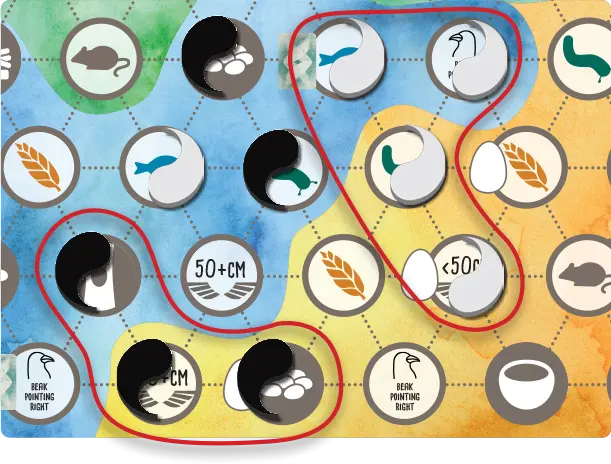
Example: In this board snippet, the white player receives 4 points and the black player receives 3 points.
The player who has the most points wins. In the case of a tie, the player with the most unused food tokens wins. If players are still tied, they share the victory.
Automa Scoring
Before calculating her final score, Automa gains 1 egg for every 3 4 5 cache hoard tokens she returns to the supply.
To calculate her final score, Automa gets:
- Points printed on each of her face-up bird cards.
- 5 4 3 points for each of her face-down bird cards.
- 1 point for each egg she collected.
- Points from the Duet map end-of-round goals as shown on the Duet map board, including points for her largest contiguous group of Duet tokens.
- Points from the end-of-round goals as shown on the goal board.
Note: Automa doesn’t gain points from her bonus card.
The player who has the most points wins. In the event of a tie, Automa wins if she has more remaining tokens than you have remaining food tokens.
Compare the average score of you and your teammates against Automarazzi’s score. If it is higher than Automarazzi’s score, you win!
Setup
Split the players into 2 groups at the same table (3+3 for a 6-player game or 3+4 for a 7-player game). These groups remain fixed for the entire game.
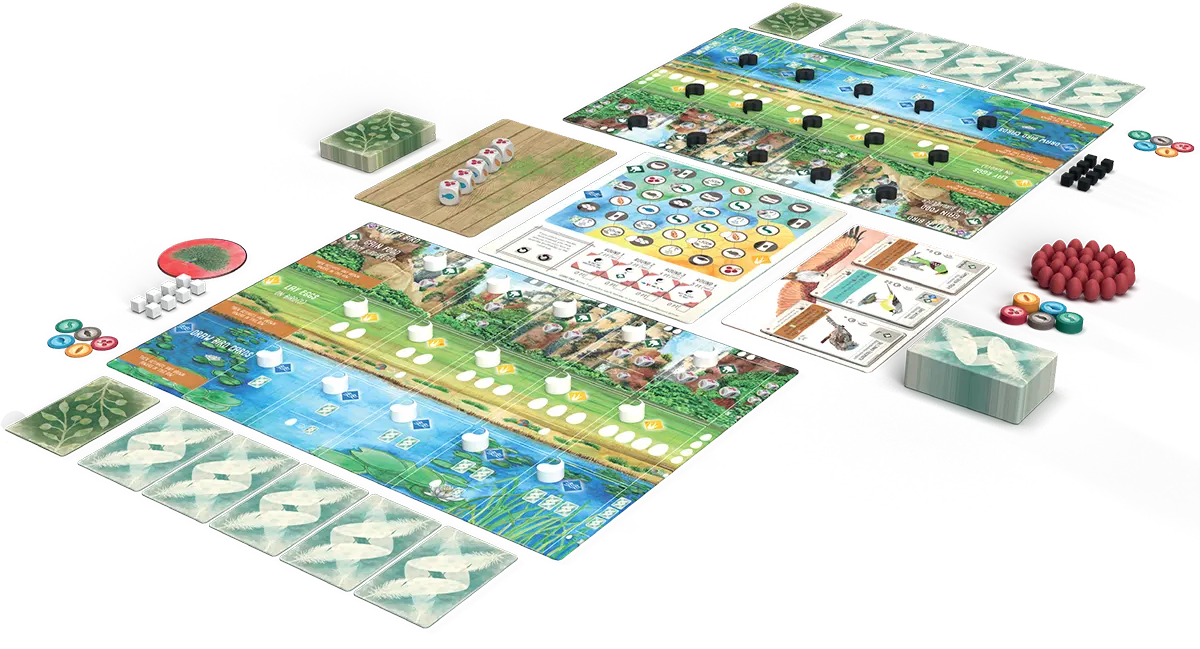
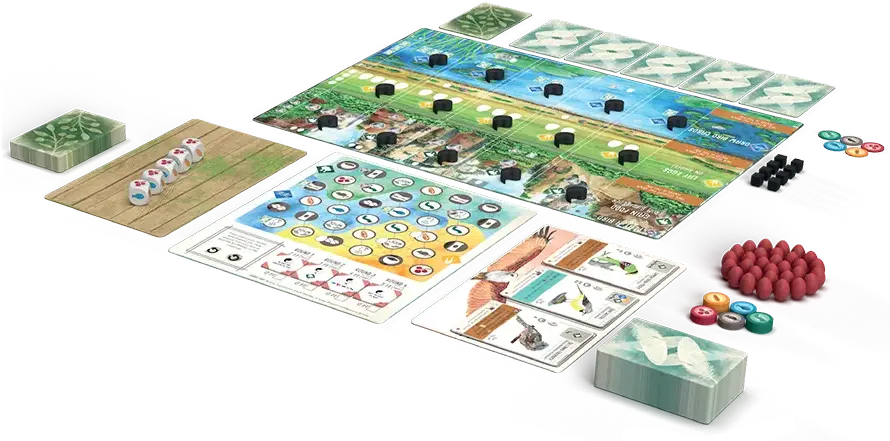
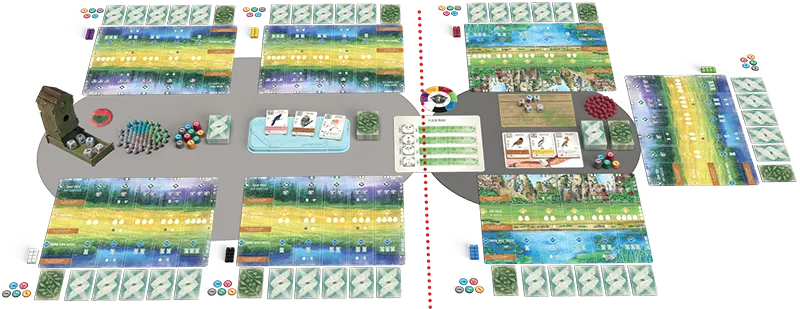
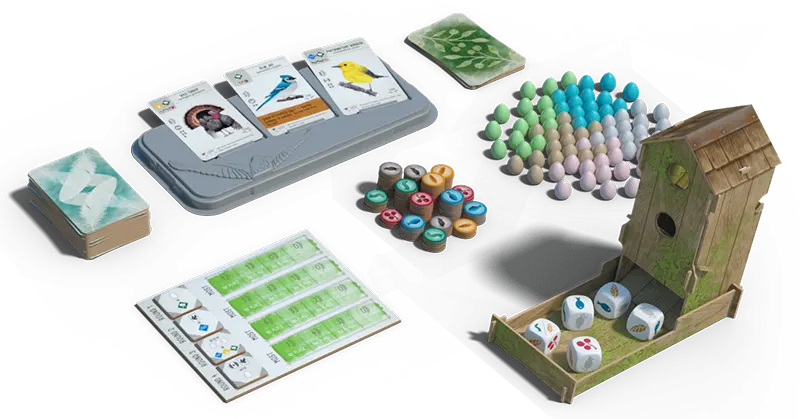
- Bird cards. Shuffle the bird cards into a deck. Place it next to the bird tray, then populate the tray with 3 face-up bird cards.
- Supply. Place all food and egg tokens in the supply. These are tokens accessible to all players.
- Birdfeeder. Toss the food dice into the birdfeeder dice tower.
- Bonus cards. Shuffle the bonus cards into a deck and place it on the table.
- Goal board. Choose which type of goals you will play with, and place the goal board on the table with that side facing up:
- Green: For a game with more direct competition for goals, choose the side that has 1st, 2nd, and 3rd place for each goal. This is the default.
- Blue: For a game with less direct competition between players, choose the side that awards 1 point for each targeted item. This is good for new players.
- Goal tiles. Shuffle the goal tiles without looking at them (they’re double-sided). Place 1 goal tile (random side up) on each of the four blank spaces on the goal board. Return extra goal tiles to the box.
- Duet map and Goal tiles. Use the Duet map and Duet end-of-round goal tiles. The goals are double-sided and marked with red corners. Choose 4 at random and put them in the 4 slots below the Duet map. Do not use the “
 on edge of map” or “
on edge of map” or “ not on edge of map” goals. Return extra goal tiles to the box.
not on edge of map” goals. Return extra goal tiles to the box.
- Turn-order dial. Place the turn-order dial in the middle of the table. The dial has two pieces; make sure that both pieces have the correct side facing up (6 or 7 players). Distribute the player action cubes to players around the table in exactly the same order as the colors on the dial (players may want to sit accordingly if they have a favorite color).
- Bird cards. Shuffle the bird cards into a deck; you will need to combine bird cards from the base game and/or another expansion to have enough for a 6-7 player game). Split the deck in half, place it next to a bird tray for each group, then populate each tray with 3 face-up bird cards.
- Supply. Place all food tokens and egg miniatures in the supply. These are accessible to all players.
- Birdfeeders. Each group has their own birdfeeder populated with 5 dice. If playing with the Oceania Expansion, each group uses 2 nectar dice and 3 regular food dice.
- Bonus cards. Shuffle all available bonus cards (except the Historian) into a single deck and place it on the table for both groups to share.
- Goal tiles. Use one set of goal tiles for the entire table (use standard goal tiles, not the Duet goal tiles with red corners). Shuffle the goal tiles without looking at them (they’re double-sided). Place 1 goal tile (random side up) on each of the 4 blank spaces on the new Flock mode goal board (on the back side of the Duet map). Return extra goal tiles to the box.

-
Each player receives:
- 1 player mat
- 8 action cubes of one color
- 2 random bonus cards
- 1 nectar token
- 5 random bird cards
- 5 food tokens (1 of each type: )
You may keep your hand of cards private or public throughout the game.
-
Keep up to 5 bird cards and discard the others. For each bird card you keep, you must discard 1 food token. You will probably want to keep food tokens shown in the upper left of the bird cards you selected. For example, you might keep 2 bird cards and 3 food, or you might keep 4 bird cards and 1 food.
-
Choose 1 bonus card to keep, and discard the other. You may look at your bonus cards while selecting which birds to keep (and vice versa).
- Place 1 Duet token in your player color on each of the 15 bird slots on your player mat. You will place a Duet token on the Duet map each time you play a bird.
-
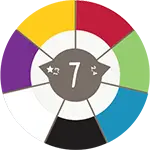
Randomly select the first player and give them the first-player token. Then rotate the turn-order dial so the star points to the player with the first-player token (purple in this 7-player example).
-
Randomly select the first player and give them the first-player token, but Automarazzi still goes last.
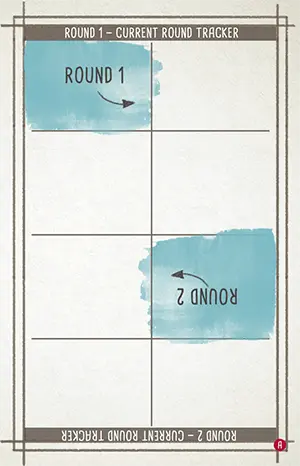
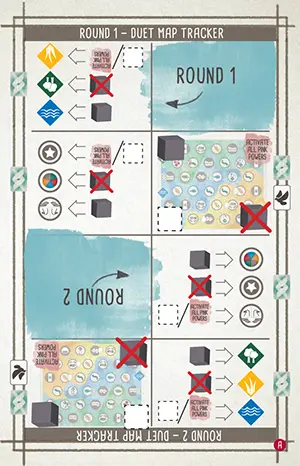

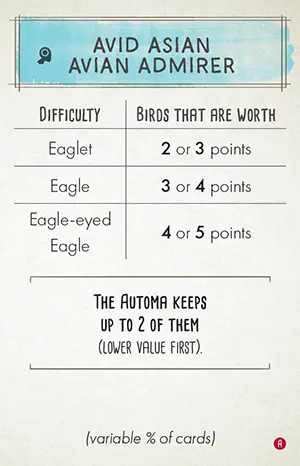
Automa needs a small area on your table for her things.
- Place the current round tracker card in the center of that area flipped and oriented to show “Round 1” in the banner at the top.
- Place the Duet map tracker card immediately to its right, also with “Round 1” at the top.
- Shuffle the Automa cards, along with at most 1 special Automa cardthe Automasian Alliance card, and place them face-down to the right of the tracker card(s). This is the Automa deck.
- Give Automa action cubes of an unused color.
- Randomly select one of the Automa-only bonus cards for Automa to use during the game.
Alternatively…
Automa can use any of the bonus cards that show (X% of cards) at the bottom of the card. Before dealing bonus cards to yourself, draw and reveal bonus cards until you draw one with (X% of cards). Give that bonus card to Automa to use during the game and reshuffle the bonus deck before continuing with setup. Note: For Pellet Dissector she takes birds that can cache food.
-
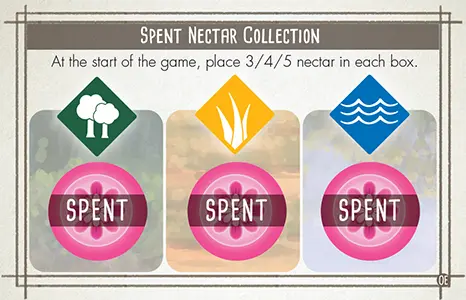 Place the Spent Nectar Collection card in the area you set up for Automa and place 5 4 3 in each habitat box.
Place the Spent Nectar Collection card in the area you set up for Automa and place 5 4 3 in each habitat box.
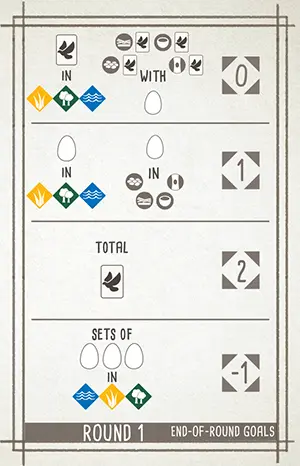
For the end-of-round goal tile for Round 1, place the corresponding end-of-round goal scoring card beside the goal mat, with “Round 1” facing up.
You always take the first turn of each round and Automa always takes the last.
Some bird powers refer to a player to your left or right. Before the game begins, if it isn’t clear from where you locate Automarazzi’s area, assign her a seat at the table so you will be able to resolve these powers.
Frequently Asked Questions
When I gain food from the birdfeeder, do I choose all of the dice at once, or one by one?
Choose dice one at a time. This creates the potential for you to reroll in between dice selections.
What about when drawing multiple cards? Can I draw a card from the deck, look at it, and then decide where to continue drawing birds?
Yes, when drawing multiple cards, you can draw a card from the deck, look at it, and then decide to continue drawing from the deck or draw from the face-up cards.
Can I activate pink (“Once Between Turns”) powers after my final turn?
Yes, your pink power can activate once after your last turn.
Can you discard birds from your player mat?
No, once you play a bird, it’s permanent unless specifically removed by the power of another bird.
Can I choose to lay fewer eggs, gain fewer food, or draw fewer eggs?
Yes, you can always decline a benefit (though you can never decline a cost). This applies to the basic actions as well as bird powers. But remember, activating a particular bird power is optional, so you can avoid a cost associated with a bird power by skipping that power entirely.
What are the birds with the grey triangles in the corners?
These birds are part of the Swift-Start Pack which is included in all current printings of Wingspan. This Swift-Start Pack helps new players learn how to play the game with the 10 bird cards marked with grey corners and 4 player guides. The birds can be shuffled into the deck to be used as regular cards and can quickly be recognized and pulled out of the deck to use with the player guides when teaching new players.
When a bird says that I can “repeat” another bird’s ability in the same habitat, how does that work?
You can choose any other “when activated” bird in that habitat and perform its power. The bird can be to the left or to the right of the “repeat” bird. The “repeat” bird does not copy the power for itself, but allows another bird to activate twice this turn.
When activating “migrating” birds that can move from one habitat to another, does the action cube move with them? Can they move even if they’re the only bird in the original habitat?
The action cube stays in the original row, as that is the action you chose for this turn. And yes, they can move if they’re the only bird in the row. These birds can migrate as long as there is no other card to their right.
Can I reroll the dice in the birdfeeder if gaining food from a bird’s power? What about when there are qualifying terms such as “if available” or “if there is one?”
Yes. Regular reroll rules apply whenever you have the opportunity to gain food from the birdfeeder.
Automa: Who goes first each round, you or the Automa?
For each of the 4 rounds, you always go first and the Automa always takes the last turn.
Is the percentage on the Omnivore Expert bonus card correct?
No, it should be 16%, not 10%.
What does the Photographer score for 4-5 birds with colors in their names?
This is a typo. Instead of 2-3, it should say 4-5.
Should the Spotted Sandpiper be worth 5 points, not 4?
Yes, 5 is correct.
The Automa
When playing against the Automa, you will always follow the multiplayer rules. The Automa, however, does not play by the rules.
- Automa will not get a player mat or a starting hand of birds and food.
- Automa will gather birds, eggs, and sometimes food, but they are only used for scoring.
- Automa does not need to ‘pay’ anything for the actions she takes.
- For anything you do that involves other players, Automa only participates as defined by these rules.
Automa Cards


Automa cards
Each Automa card is divided into 4 sections, one for each of the rounds. Only the section for the current round will be used. The other round sections are ignored.
Each section contains one or more icons representing the actions Automa will take during her turn.

Current Round Tracker
The current round tracker card is provided to help you remember the correct section to examine on the Automa card.

Duet map tracker card
When you place a Duet token for the Automa, the Duet map tracker card tells you how to navigate the Duet map. It also tells you where to place the token when the Automa takes the “draw cards” action.


Bonus cards
The Automa uses bonus cards to determine which bird cards she takes when she uses the “play a bird” action. You can use one of the special Automa-only bonus cards shown here, or any standard bonus card that show (X% of cards) at the bottom of the card.
The Automa does not score points for her bonus card at the end of the game.

End-of-round goal scoring cards
These cards tell you the base value when scoring Automa’s end-of-round goals.

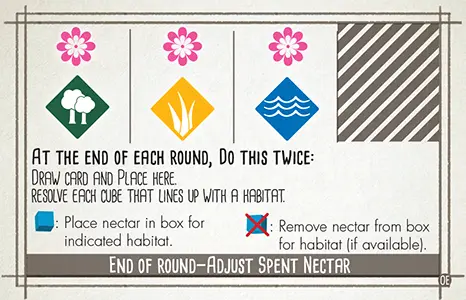
Nectar cards
These cards are used to keep track of how much nectar Automa has, and how much she gains or loses at the end of each round.
The Automa’s Turn
On Automa’s turn, draw a single card from the Automa deck and place it face up on top of any previously revealed Automa cards, covering half of the tracker cards and lined up against the arrows. The arrow points to the section you will use for the current round. Resolve each action icon in that section. The other three sections are ignored.




In this example, the Automa will perform the “Lay Eggs” action and then remove an action cube from the round 3 goal tile, if there is one.
In this Duet mode example it is round 1. Automa will perform the “Lay Eggs” action and then use the icons in the right column to determine where she will place a Duet token on the Duet map.
Automa Actions
Draw Cards
Discard all 3 face-up cards from the bird tray. Draw 1 card from the face-down bird deck and place it face-down in Automa’s supply. Face-down birds are worth 5 4 3 points at the end of the game (see Difficulty).
Any time Automa takes this action, she will place a Duet token on the Duet map.
Play a Bird
From the 3 face-up cards on the bird tray, pick up all that meet the requirement of Automa’s bonus card. Of these cards, Automa will keep 1 card with the highest point value. If there are multiple cards with the same highest point value, it makes no difference which one the Automa keeps. Place it faceup in Automa’s supply and discard the rest. Face-up birds are worth their stated point value at the end of the game.
For example, if Automa’s bonus card is Cartographer, which awards points for birds with geography terms in their names, she would pick up all bird cards that featured these names, place the one with the highest point value face-up in her supply, and discard the rest.
If no birds meet the requirement, draw 1 face-down bird card and place it face-down in Automa’s supply. Face-down birds are worth 5 4 3 points at the end of the game (see Difficulty).
Duet mode: Any time Automa takes this action, she will place a Duet token on the Duet map.
Lay Eggs
For each egg icon in the section for the current round on the Automa card, give the Automa 1 egg token from the supply.
 Gain Food
Gain Food
If all dice in the birdfeeder show the same face, remove the remaining dice and toss all 5 dice into the top of the birdfeeder to refill it.
Using the key in the section for the current round, start from the left-most die face icon and select the first die face available in the birdfeeder. Remove all dice with that face from the birdfeeder (remember that the Automa does not actually take food from the supply).
Activate pink powers
Activate all pink powers of bird cards on your player mat (the Automa does nothing).
Remember: pink powers may only be triggered once between your turns. When the Automa card shows ‘Activate all pink powers’ it doesn’t activate any that have triggered since your last turn.
Place End-of-round Cube
Place 1 of Automa’s action cubes on the current round’s goal tile of the goal board.
Remove End-of-round Cube
Remove 1 of Automa’s action cubes from the current round’s goal tile and return it to Automa’s supply. If there are no cubes on the tile, ignore this action.
Automa’s Cache
Automa will gain cache tokens whenever you trigger a white or brown power that should give her something. Food tokens are used to represent these for her; the type of food token has no significance.
When you trigger a white or brown power, if Automa is supposed to gain something, the following happens: If she must pay something to participate, give her one token for each thing she will gain. Otherwise, give her two tokens for each thing. For example:
- When played: Lay 2 on each other bird in this column.
- Automa gains 4 cache tokens.
- When activated: Each player may discard 1 to draw 1 from the deck.
- Automa gains 1 cache token.
Anything you give to Automa as a part of these powers is returned to the supply; she only gains the cache tokens, as described above. For example:
- When activated: Give 1 from your hand to another player. If you do, draw 2 .
- Discard the . Automa gains 2 cache tokens
Automa always fulfills any condition required to gain from your triggered power. For example:
- When activated: Draw 1 from the deck and add it to your hand. All other players draw 1 from the deck and keep it if the bird has a or in its food cost.
- Automa gains 2 cache tokens.
Automa Interaction on Your Turn
Automa does nothing during your turn except when you activate a “when played” (white) or “when activated” (brown) power that interacts with another player, and only as explained in this section.
Check if another player has something
To check if Automa has something, the number of icons on Automa’s current Automa card represents how many she has.
Note: This means that she never has anything on your first turn of each round, as she hasn’t drawn an Automa card yet.
Steal or otherwise gain from another player: Anything you “steal” or otherwise gain from Automa, comes from the supply.
Another player gains or may gain
When another player gains or may gain something, Automa gains cache hoard tokens instead. She always gains as many tokens as possible.
Note: This is true for other action words (cache, draw, tuck) that give another player something.
Use a power of another player’s bird
When you use a power of another player’s bird, use any power of that type from amongst the 3 face-up cards in the bird tray.
Use another player’s bonus cards
When you play a bird with a power that allows you to use another player’s bonus card, draw two bonus cards and place them face-up in the supply.
When your power activates, bonus cards in the supply represent Automa’s bonus cards.
Scoring Automa End-of-round Goals
Automa’s quantity of the targeted item for end-of-round goal scoring is calculated using a base value (shown on the end-of-round goal scoring card) plus any cubes on the current round’s goal tile. The base value represents the lowest quantity of the targeted item that Automa will have.
Using the end-of-round goal scoring card for the current round, match the current round’s goal tile to the symbols on the card to find the base value. To this value, add the number of action cubes Automa has on this goal tile (if any). As with you, Automa’s quantity must be greater than 0 to score points for the goal. Note: Automa cannot exceed 5 birds for the ‘birds in a specific habitat row’ goal.
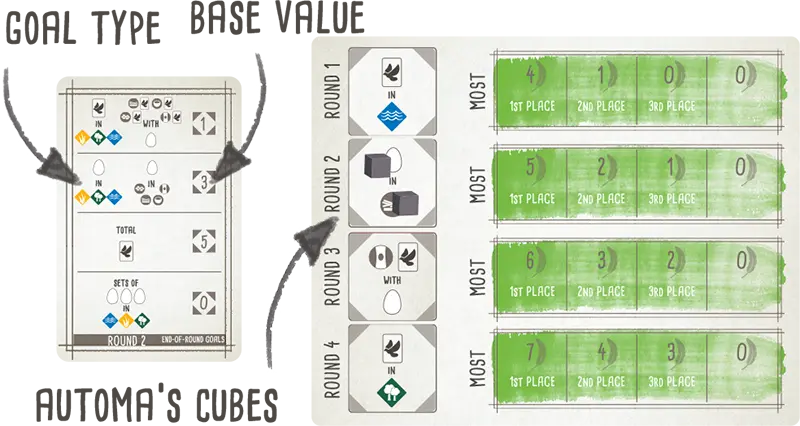
Use one of Automa’s action cubes to mark her rank on the goal board (or to mark her score when using the alternate side of the goal board). Return any action cubes on the goal tile to Automa’s supply.
Place the end-of-round goal scoring card for the next round beside the goal tile for the next round.
No goal: At the end of a round containing the “No goal” End-of-round goal, Automa gains in each habitat box on her Spent Nectar Collection card.
Automa Difficulty Levels
You can adjust Automa’s difficulty to suit your play style.
Setup: Starting spent nectar per habitat
- Eaglet
- 3 nectar tokens
- Eagle
- 4 nectar tokens
- Eagle-eyed Eagle
- 5 nectar tokens
Game-end: Automa’s Cache (or Hoard)
- Eaglet
- 1 egg/5 tokens
- Eagle
- 1 egg/4 tokens
- Eagle-eyed Eagle
- 1 egg/3 tokens
Game-end: Face-down bird cards
- Eaglet
- 3 points
- Eagle
- 4 points
- Eagle-eyed Eagle
- 5 points
Placing Automa Duet Tokens
When Automa takes the “Draw Cards” or “Play a Bird” action, she will place a Duet token on the Duet map. She ignores all restrictions regarding the bird card that was played and instead uses the icons along the right column of her Automa card along with the rules below.
Automa does not gain the bonus if she places a Duet token on a space with a bonus. She never places more than 1 Duet token per turn and will not place more than 15 Duet tokens per game.
 Navigate the Duet Map
Navigate the Duet Map
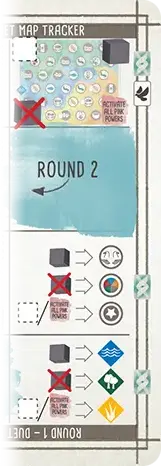
- Map
- Round
- Type
- Habitat
When deciding where to place a Duet token, the icon in the right column of the Automa card that aligns with the map section of the Duet map tracker determines the order to evaluate spaces on the Duet map. This is called navigating the Duet map.
Each of the four corners of the Duet map image shown on the Duet map tracker card contains one of the four possible icons (well, one possibility is no icon, but we’ll treat that as an icon too).
Starting from the corner of the map indicated, Automa will check each space in that row until reaching the other side of the map. Then, she will return to the side she started from, move to the next row (upwards or downwards, depending on whether she started from the top or bottom row of the map), and check each space in that row, continuing like this until she finds a spot to place her Duet token.
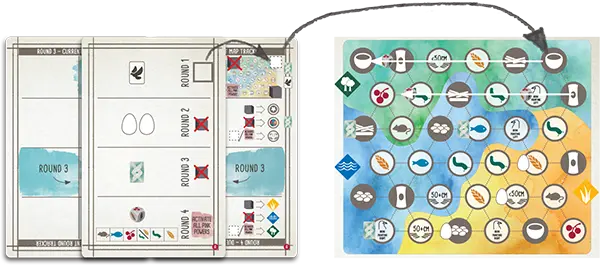
For example, there is no icon at the top of the Automa card. The Duet map tracker shows “No Icon” in the top right corner, therefore she will look for a valid space starting with the space in the upper right of the Duet map. From there she will look, right to left, along the top row. Then, returning to the rightmost space of the next row down, she will continue looking, right to left, along that row. This continues until she finds a valid space.
After play a bird
After completing the “Play a Bird” action, Automa will place a Duet token on the Duet map based on the current round goal tile.
Based on the map section of the Duet map tracker, she will navigate the Duet map until she finds an available space that improves her progress with the Duet map goal for the current round. Place one of her Duet tokens on that space.
Note: If no space improves her progress, she simply navigates to the first available space, ignoring the goal.
After draw cards
After completing the “Draw Cards” action, Automa will place a Duet Token on the Duet map based on the Duet map tracker.
Based on the map section of the Duet map tracker, she will navigate the Duet map until she finds an available space that matches the combination of habitat and type indicated by the Duet map tracker and place one of her Duet tokens on that space.
To determine the habitat and type, compare the icons along the right column of the Automa card to the Duet map tracker, as follows:
- Compare the icon that aligns with type section of the Duet map tracker to determine the type (nest, food, or other)
- Compare the icon that aligns with the habitat section of the Duet map tracker to determine the habitat (grassland, wetlands, or forest)
Only map spaces with the correct combination of type and habitat are available for her to place a Duet token.
Using the example, the icon that aligns with the type section is so, as shown on the Duet map tracker, she must choose a food space. Similarly, the icon that aligns with the habitat section is so she must choose a space in the forest. Therefore, only food spaces in the forest are valid.
If Automa fails to find a valid available space to place a Duet token, she doesn’t place one.
Variant–Automa’s Hoard
Automa’s Hoard can be played with any combination of expansions. However, its impact is smaller when playing with fewer birds that involve opponents gaining things on your turn.
Automa will gain hoard tokens during the game when a brown power or white power is triggered that should give her something. Food tokens are used to represent these for her; the type of food token has no significance.
Do not use Automa’s Cache when using the Automa’s Hoard variant.
Your Turn — Brown Powers and White Powers
Automa only participates in brown powers and white powers as described here. For each resource Automa would gain and any resources she would lose in exchange, do the following:
- For each
 or
or  Automa would gain, give her 1 hoard token from the supply. For each she would lose, return 1 hoard token to the supply.
Automa would gain, give her 1 hoard token from the supply. For each she would lose, return 1 hoard token to the supply. - For each Automa would gain, give her 2 hoard tokens from the supply. For each she would lose, return 1 hoard token to the supply.
- For each Automa would gain, give her 2 hoard tokens from the supply. For each she would lose, return 1 hoard token to the supply.
- For each Automa would gain, give her 3 hoard tokens from the supply. For each she would lose, return 2 hoard tokens to the supply.
- For each Automa would gain, give her 6 hoard tokens from the supply.
When you give something to Automa, it is returned to the supply and she gets hoard tokens instead.
When Automa gets to cache food or tuck a bird, give her 3 hoard tokens from the supply, instead. For example:
- When activated: All players may tuck a from their hand under a bird in their and/or cache 1 from their supply on a bird in their .
- Automa gains 6 tokens (3 for tuck and 3 for cache) and returns 2 tokens (1 for and 1 for ).
If Automa gets to choose the type of resource, she always chooses . For example:
- When played: Draw 2 and keep 1. Other players may discard any 2 resources (
 , , or ) to do the same.
, , or ) to do the same. - Automa gains 6 hoard tokens for the and returns 2 hoard tokens for the two .
Note: Automa will not participate in any power where she would lose more tokens than she would gain. For example:
- When activated: All players may discard 1 . Each player that discards an gains 1
 from the supply.
from the supply. - Automa does nothing because she would gain 1 token for the
 , but return 2 tokens for the .
, but return 2 tokens for the .
Nectar and the Oceania dice
Automa does not gain or use nectar. Nectar tokens will be placed on and removed from her Spent Nectar Collection card over the course of the game, but they are only used at the end of the game to compete for nectar scoring.

Spent Nectar Collection card
The Spent Nectar Collection card has 3 “spent” boxes to collect nectar tokens for each of the habitats.
Selecting Dice
Selecting dice from the birdfeeder works the same as in the base game with the following substitution on the key.
- When the key shows she takes .
- When the key shows she takes / .
End of the Round—Adjust Automa’s Spent Nectar

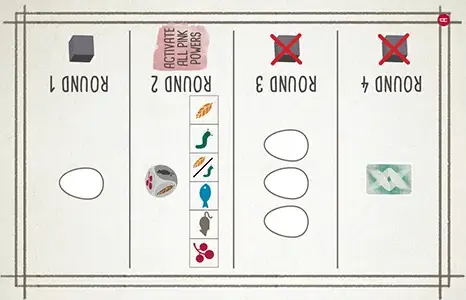
Adjust her collection of spent nectar at the end of each round. Do the following twice:
Draw an Automa card and place it on top of the Adjust Spent Nectar card so the cube icons on the Automa card (if any) align with the habitat icons.
-
Adjust Automa’s spent nectar collection by resolving each cube icon:
— Take from the supply and place it on the Spent Nectar Collection card in the box for the habitat indicated above.
— Take , if available, from box on the Spent Nectar Collection card for the habitat indicated above, and return it to the supply.
Automarazzi (2-4 Players Against Automa)
Automarazzi can be played using the base game or with any combination of expansions. You may also play using the Automa’s Hoard variant. Automarazzi is played open-handed.
In addtion to exchanging resources during your turn (see below), playing with Automarazzi affects setup, round structure, and end game scoring.
Give Bird Cards to Other Players
At any point during your turn, you can give bird cards from your hand to other players. There is no limit to how many bird cards you can give away and you may give them to any combination of other players. However, for each card you give you must first discard one  , , or . If you have nothing to discard, you cannot give a bird card. If you discard , it is returned to the supply.
, , or . If you have nothing to discard, you cannot give a bird card. If you discard , it is returned to the supply.
Take Eggs from Other Players
At any point during your turn, assuming the other player agrees, you may take 2 eggs from their player mat. Give 1 to Automarazzi and place 1 on any bird on your player mat (egg limit rule applies). There is no limit to how many times you can do this.
Give Food to Other Players
At any point during your turn, you can give  to other players. There is no limit to how many you can give away and you may give them to any combination of other players. Give Automarazzi 3 hoard tokens for each given and 2 hoard tokens for each other
to other players. There is no limit to how many you can give away and you may give them to any combination of other players. Give Automarazzi 3 hoard tokens for each given and 2 hoard tokens for each other  given.
given.
Action Cubes
Action cubes are used to:
Perform and record your actions during your turn.*
Mark your score on the goal board at the end of each round.
Beak Pointing Left/Right
Beak pointing left
Beak pointing right
These icons refer to the direction a bird’s beak is pointing. Birds whose beaks are pointing straight ahead (or straight up) don’t count toward either the left or right-facing goal.
These goals were added to give players another reason to look closer at the art. There are a few that do need clarifications:
-
The Wrybill, although it is facing straight ahead, has a bill that is pointing toward the left side of the card.
-
The Common Loon has 1 bird facing in each direction, so it qualifies for both goals.
-
The Little Grebe has 1 bird facing in each direction, so it qualifies for both goals.
-
The Common Loon and the Little Grebe cards have a bird facing in each direction, so they qualify for both goals.
-
The Great Crested Grebe card has 2 birds facing the same direction: it counts as a single card that has a bird facing left.
The following is a list of the birds that are not pointing left or right.
- Australian Owlet-Nightjar
- Barn Owl
- Barred Owl
- Bearded Reedling
- Burrowing Owl
- California Condor
- Eastern Screech-Owl
- Eurasian Eagle-Owl
- Forest Owlet
- Great Horned Owl
- Horned Lark
- Kākāpō
- Little Owl
- Oriental Bay-Owl
- Rufous Owl
- Short-Toed Treecreeper
- Snowy Owl
- Spoon-Billed Sandpiper
- Spotted Owl
- Sri Lanka Frogmouth
Bird Cards
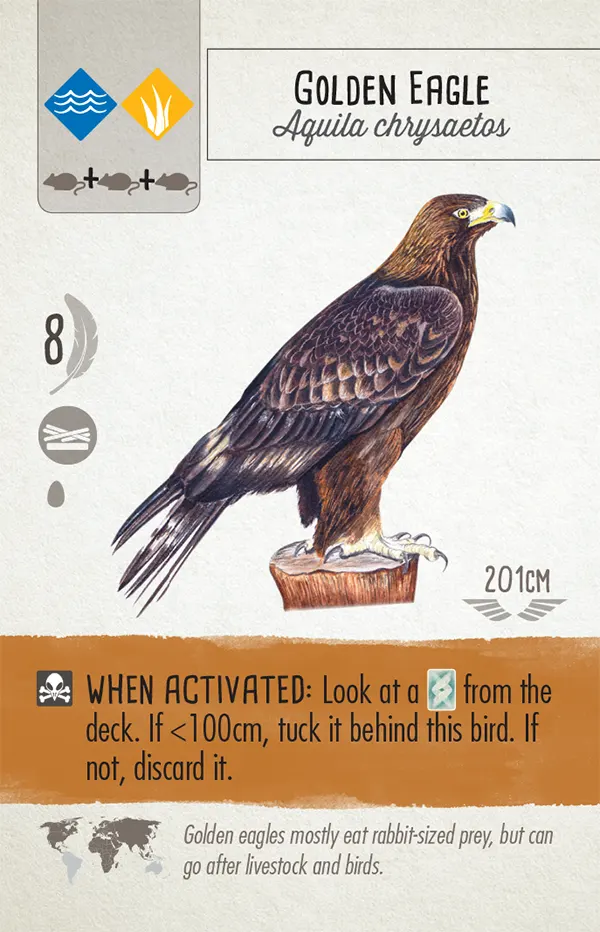
- Name
- Habitat
- Food cost
- Point value
- Nest type
- Egg limit
- Wingspan
- Bird power
- Power icon
- Range
- Factoid
Bird Powers
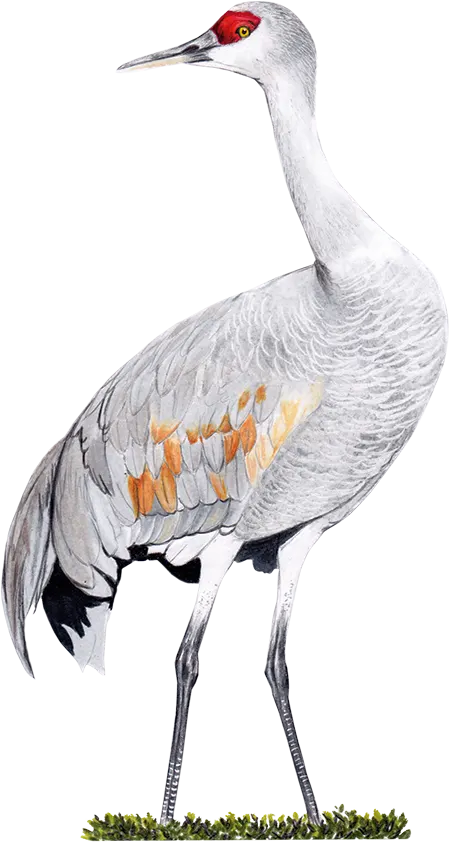
Powers on bird cards may include these icons:
-
This indicates that the bird is a predator.
-
This indicates that the bird’s power involves tucking other bird cards under it to represent the creation of a flock. Each of these tucked cards are worth 1 VP at end of game.
-
This indicates that the bird’s power involves drawing additional bonus cards.
The background of a bird power indicates when it occurs:
When Played (no color)
These powers may be activated only when a bird is played (never again after you play the bird).
When Activated (brown)
These powers may be activated from right to left whenever you use the corresponding habitat.
Once Between Turns (pink)
These powers may be triggered on opponents’ turns. You can only use a pink power once between each of your own turns (if an opponent triggers it). We recommend telling other players what the power is, and what activates it. Players should help each other notice when a bird with a pink power should be activated.
Round End (teal)
These powers are resolved when all turns in the round have been completed, but before scoring the goal for that round.
- Resolve them in player order, starting with the first player for the round.
- If you have more than one bird with round end powers, you may resolve your birds’ powers in any order.
- Round end powers do NOT activate “once between turns” (pink) powers.
Game End (yellow)
Some birds have yellow powers that activate only once, at the end of the game. Activate these powers after completing all end-of-round steps. If you have more than one bird with a “game end” power, you may activate them in any order. These birds do not trigger birds with pink “once between turns” powers.
The Birdfeeder

The birdfeeder has a tray to hold the 5 food dice. The dice removed from the birdfeeder when a player gained food will remain outside the tray until the birdfeeder is refilled.
If the birdfeeder tray is ever empty, throw all 5 dice back in.
If the dice in the tray all show the same face (including if there is only 1 die) and you are about to gain food for any reason, you may first throw all 5 dice back into the birdfeeder. (, , and each count as a unique facecounts as its own unique face.)
Bonus Cards
As described in Setup, each player starts the game with 1 bonus card (selected from 2 random cards).
There are also several birds with powers that allow you to gain additional bonus cards.
Bonus cards are all scored at end of game.
Cache
This refers to putting a food token on a bird (the bird is saving the food for later). You cannot spend that food token; instead, it’s worth 1 VP at end of game. If you run out of food tokens, you can cache cards instead (use discarded cards).
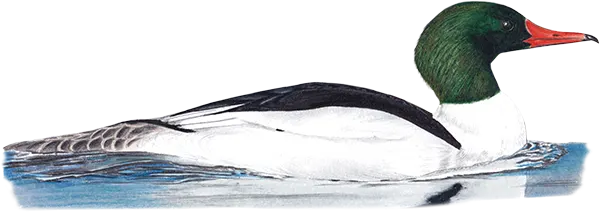
Draw Bird Cards and Activate Wetland Bird Powers

The cards available for you to draw are the 3 face-up cards on the bird tray and the top card of the bird deck.
When you choose to draw cards, do the following:

-
Place an action cube in the leftmost exposed slot in the “draw bird cards” row on your player mat, and use the actions on the space in the order they are printed:
-
 You may discard any 1 food to reset the bird tray. This is optional.
You may discard any 1 food to reset the bird tray. This is optional.
-
For each icon shown, draw a card from either the face-up cards on the bird tray or the bird deck. There is no hand limit.
-
/ You may discard at most 1 egg from a bird on your mat or 1 nectar, to draw an additional card. This is optional.
-
-
Activate any brown powers on your wetland birds, from right to left. All powers are optional. End your turn by placing your action cube on the left side of the “draw bird cards” row.
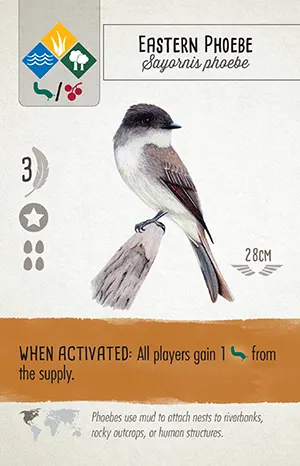
Example: Draw 1 bird card, then you may discard 1 egg to draw another card. Next, you may activate the power on the bird card.
Example: You may discard any 1 food to reset the bird tray, then draw 2 bird cards. Next, you may activate the power on the bird card.
Managing the bird deck
As you draw face-up cards, they are not immediately refilled. Instead, wait until the end of your turn before refilling empty spaces on the bird tray. If the face-down deck is ever emptied during the game, reshuffle all discarded bird cards to form a new deck.
At the end of each round, discard any remaining face-up cards and replenish them with 3 new bird cards.
Duet Mode
Wingspan Asia includes a Duet mode for exactly 2 players.

Gameplay example
When you play a bird onto your player mat, place the Duet token from that spot onto an unclaimed space on the Duet map that matches the bird you played.
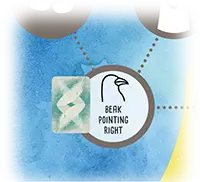
Bonus: Some spaces on the Duet map have bonuses. If the space that you use has an egg, card, or food die on it, you gain the item shown.
“Matching the bird” means:
- The space must be in the region of the Duet map that corresponds to the habitat where you played the bird.
- The symbol on the space must correspond to the bird you played:
- To use a nest space, the bird must have that nest symbol.
- Star nests are wild and can match any nest symbol on the Duet map.
- To use a food space, you must have spent that food.
- If you use the 2-for-1 food rule to play a bird, treat it as if you converted those two foods into the food you needed for the bird. Thus, you can use a space for the required food, not the 2 foods you spent to get that required food.
- The 50+ cm and <50 cm spaces correspond to the bird’s wingspan.
- To use a nest space, the bird must have that nest symbol.
- Note that it is not enough for a bird to have the correct habitat or food on the card; you must have played the bird in that habitat and used that food when playing the bird.
Do I place a token?
- Place a token on the map whenever you play a bird. This will usually occur through taking the “play a bird” action, but bird powers that allow you to play a bird (e.g., “play another bird in this habitat”) also count.
- Remember, the Duet tokens on each space of your player mat are only there as a reminder to use them, not a requirement for play. For example:
- Bird powers that move a bird do not cause a new Duet token to be placed on the Duet map.
- Some birds in other expansions allow you to play a bird on top of another bird. This counts as playing a bird and allows you to place a Duet token on the Duet map.
- In the unlikely event that you play more than 15 birds in a game (using all the Duet tokens), use a substitute.
Only one player can use each space.
If you cannot place a Duet token in a matching space or do not wish to, you may place your Duet token in the reset space on the lower left of the board instead. On a later turn, at any time on your turn, you may remove that Duet token to reset the bird tray or the birdfeeder.
Duet gameplay example

The Brown Shrike was played above in the grassland habitat of the player mat, so the player may place their Duet token on an unoccupied space in the grassland region with any of the following symbols: invertebrate, rodent, bowl nest, <50 cm, or left facing beak. In this example the white player placed their Duet token on a bowl nest symbol in the grassland region.
Eggs
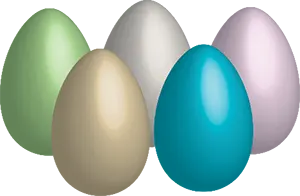
Eggs are part of the cost of playing bird cards in columns 2–5. Also, each egg on the bird cards on your player mat is worth 1 point at the end of the game.
There is no limit to the egg supply. In the unlikely event that no eggs remain in the supply, use a temporary substitute.
First Player
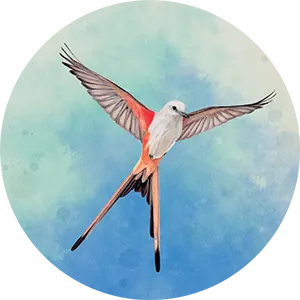
During setup, choose a first player and give them the first-player token.
At the end of each round, pass the first player token to the left. That person takes the first turn in the following round.
Flock Mode
Flock mode requires 2 simultaneous active players to speed up gameplay. You are still competing as individuals, just as you do in the base game. You will be assigned to a group that has its own bird tray and birdfeeder, and you will only use that group’s resources throughout the game. You will interact across groups in other ways, though: the whole table shares end-of-round goals, pink “Once Between Turns” powers, and any bird powers that affect other players.
Group Notes
- Other than assigning players to a certain set of dice and cards, the groups do not have any meaning in the game.
- Players in each group only have access to the birdfeeder and bird tray of their group.
- If a bird power refers to “any die,” you only have access to your group’s dice.
Gameplay

The 2 players that the turnorder dial points to are the active players. They take their turns simultaneously.
When both active players have completed their turns, rotate the turn-order dial clockwise. There are now 2 new active players who take their turns.
- To avoid confusion, be sure to wait for both active players to finish their turns before moving the turn-order dial. To help with this, active players should announce when they are done with their turns.
Continue until all players have completed their turns.
Special circumstances for 7-player games
In rounds 2 and 4, everyone has an odd number of turns. This will cause the person to the right of the first-player token to have 1 cube left at the end of the round when everyone else has finished their turns. They take 1 last turn alone at this point.
The 2 players on the edges of the 4-player group will be active players on the same turn for half of their turns, which might cause issues if they are both interacting with the dice or the bird tray. On these turns, the active players should resolve their turns one after the other, instead of simultaneously.
- Rounds 1 and 3: the star points to the first active player (marked “1,3” on dial)
- Rounds 2 and 4: the non-star is the first active player (marked “2,4” on dial)
On these turns, if the first active player draws cards, the bird tray refills at the end of their turn, before the second active player takes their turn.
Interactions with the Oceania Expansion
Nectar: All players need access to nectar as a resource. Split the dice from the Oceania Expansion between the two birdfeeders (2 nectar dice and 3 regular dice per birdfeeder). Score nectar with friendly ties, like the end-of-round goals: more than one player can be in first place, and second place is still awarded to the player(s) who have the next-highest amount of nectar.
Emu: Gain all the seed from your group’s birdfeeder. When you distribute seed, you may distribute it to anyone at the table.
Flocking
The birds with this power are known for gathering in large single-species flocks. As described on these cards, you can build a flock of a certain species by tucking cards face-down under that bird card. Each tucked card is worth 1 point at end of game.
Food
-

Fish token
-

Fruit token
-

Rodent token
-

Invertebrate token
-
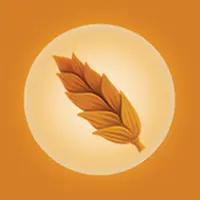
Seed token
-

Nectar token
Food is primarily used to play bird cards, but some birds cache food that is worth VP at end of game.
There is no limit on how many food tokens you can have by your mat or on your birds, nor is there a limit on food tokens in the supply. In the unlikely event that any type of food token is unavailable in the supply, use a temporary substitute.
Gain Food and Activate Forest Bird Powers

Food is primarily used to play bird cards. Your options for which food to gain are shown on the dice in the birdfeeder, which will repeatedly get depleted and refilled throughout the game.
When you choose to gain food, do the following:
-
Place an action cube in the leftmost exposed slot in the “gain food” row on your player mat, and use the actions on the space in the order they are printed:
-
 You may discard any 1 food to reset the birdfeeder. This is optional.
You may discard any 1 food to reset the birdfeeder. This is optional.
-

 For each icon shown, gain food from dice you select from the birdfeeder. For each food that you gain:
For each icon shown, gain food from dice you select from the birdfeeder. For each food that you gain:
- Remove a die from the birdfeeder and put it on the table.
- Gain a food token matching the icon on the die and place it next to your player mat. Your food tokens are public information.
You always gain 1 food token per die. With thea die face that shows , , or , gain 1 token of either type (not 2 tokens).
-
 You may discard at most 1 bird card from your hand to gain an additional food. This is optional. When you gain this extra food, you must choose among the dice that are remaining in the birdfeeder.
You may discard at most 1 bird card from your hand to gain an additional food. This is optional. When you gain this extra food, you must choose among the dice that are remaining in the birdfeeder.
-
-
Activate any brown powers on your forest birds, from right to left. All powers are optional. End your turn by placing your action cube on the left side of the “gain food” row.

Example: Gain 1 food token from a die, then you may discard 1 bird card to gain another food token from a die. Next, you may activate the power on the bird card.
Example: You may discard any 1 food token to reset the birdfeeder, then gain 2 food from the birdfeeder. Next, you may activate the power on the bird card.
Lay Eggs and Activate Grassland Bird Powers
Eggs are part of the cost of playing bird cards in columns 2–5. Also, each egg on the bird cards on your player mat is worth 1 point at the end of the game.
When you choose to lay eggs, do the following:
-
Place an action cube in the leftmost exposed slot in the “lay eggs” row on your player mat, and use the actions on the space in the order they are printed:
-
Lay an egg for each icon shown.
To lay an egg, gain an egg token from the supply (color doesn’t matter) and place it on a bird card that has space for it, according to its egg limit. The egg will stay there for the rest of the game, unless discarded.
Example: five egg limit
You can lay eggs on any combination of birds (including all on 1 bird), but each bird has an egg limit. A bird’s egg limit is shown by the egg icons. A bird card can never hold more than this number of eggs.
It is possible that you will have more capacity to lay eggs (based on your player mat) than you have spaces on your birds. Any excess beyond your egg limit is lost.
-
/
 You may discard at most 1 bird card, or pay at most 1 food token to lay an additional egg. This is optional.
You may discard at most 1 bird card, or pay at most 1 food token to lay an additional egg. This is optional.
-
-
Activate any brown powers on your grassland birds, from right to left. All powers are optional. End your turn by placing your action cube on the left side of the “lay eggs” row.

Example: Lay 2 eggs, then you may pay 1 food to lay another egg. Next, you may activate the power on the bird card.
Nectar

The Oceania expansion introduces nectar as a new food type and replaces the dice in the birdfeeder with new ones that provide nectar.
When paying food to play a bird, use an “any food” bird power, or upgrade an action, nectar is a wild food.
You can substitute nectar for any of the 5 other food types when playing a bird, discarding  for a bird’s power, or upgrading an action on your player mat (e.g., discarding a food to lay an extra egg:
for a bird’s power, or upgrading an action on your player mat (e.g., discarding a food to lay an extra egg:  ).
).
Some birds have nectar as a food cost. The normal rule that you can spend 2 food tokens as if they are any 1 food token also applies to nectar.
The
 symbol always includes nectar. If you find that this rule makes the Chihuahuan Raven and Common Raven in the base game too powerful, remove those two birds from the deck while playing with the Oceania Expansion.
symbol always includes nectar. If you find that this rule makes the Chihuahuan Raven and Common Raven in the base game too powerful, remove those two birds from the deck while playing with the Oceania Expansion.
When bird powers refer to a specific food type, nectar is not a wild food.
If a bird’s power looks for rodents in the birdfeeder, for example, do not also count the nectar there.
Any nectar remaining in your personal food supply at the end of the round is discarded.
You cannot carry over any nectar from round to round.
Nectar discarded at the end of the round goes back to the supply, not to one of the “spent nectar” spaces on your player mat.
This rule only applies to unspent nectar in your personal food supply. Do not discard the nectar on your “spent nectar” spaces or cached on your birds.
When spending nectar to play birds, use an “any food” bird power, or upgrade an action, put it onto the “spent nectar” space for that habitat.
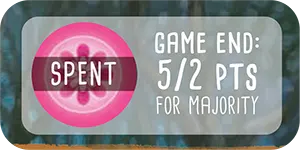
You can put nectar onto your mat when:
you spend nectar as part of a bird’s food cost (nectar costs paid with an

 = are not placed on the “spent nectar” space. The nectar never enters your supply.)
= are not placed on the “spent nectar” space. The nectar never enters your supply.)you spend nectar on a bird power that has the
 icon. (Remember, if the bird power lists a specific food, you must use that food. Nectar is not wild for bird powers.)
icon. (Remember, if the bird power lists a specific food, you must use that food. Nectar is not wild for bird powers.)you spend nectar to pay for one of the action upgrades printed on your player mat (such as resetting the birdfeeder or card tray, or gaining more eggs or cards).
You must put it on the same row where you spent it: when playing a bird, put it in the row where you played the bird. Otherwise, put it in the row that you activated that turn.
You may not trade away nectar in the 
 =
=  conversion. Nectar is already wild.
conversion. Nectar is already wild.
At game end, count who has the most nectar tokens in the “spent nectar” space of each habitat. Award points as shown on the player mat. In each habitat:
- The player with the most nectar receives 5 points, and
- The player with the second-most nectar receives 2 points.
As with the end-of-round goals, you must have at least 1 nectar token in a habitat to qualify for the nectar points for that habitat. If two or more players are tied, add the points and divide them evenly, rounded down. For example, two players tied for most nectar would each receive 3 points. Two players tied for second most nectar would each receive 1 point.
Nests
Each bird has a nest icon beneath its score. These nest icons can be important for end-of-round goals and bonus cards. The 4 types of nests are:
-
Bowl
-
Cavity
-
Ground
-
Platform
-
Star nests are wild. (These birds build unusual nests that don’t fit into the four standard types.) These can be powerful, because they can match any other nest type for goals, bonus cards, and bird powers.
Play a Bird from Your Hand

Before choosing to play a bird from your hand, consider its habitat, food requirements, and egg cost. Each bird has habitat and food requirements, shown in the upper left-hand corner of the card. Additionally, there may be an egg cost shown at the top of the column in which you’re playing the bird (there is no egg cost for the first column). If you cannot afford to pay the full cost, you cannot play the bird.
When you choose to play a bird, do the following:
-
Select a bird card in hand to play and place an action cube at the top of the column in which you will play the bird. Pay the corresponding egg cost (if any) by discarding eggs from any birds on your player mat. To play a bird in column 2 or 3, you must discard 1 egg to the egg supply. In columns 4 or 5, you must discard 2 eggs.
-
Pay the bird’s food cost. Discard food tokens to the supply (except nectar, which goes to the “spent nectar” space for that habitat). These tokens must be from next to your player mat, not food tokens cached on bird cards. The types of food are:
-
Fish
-
Fruit
-
Rodent
-
Invertebrate
-
Seed
-
Nectar
-

Wild: If a bird’s food requirement includes a wild icon, you can use any of the 5 types of food for it.
-
No Food: A crossed-out circle means a bird does not have a food cost.
-
Or: This icon in bird costs and other places in Wingspan means “or” (e.g., pay 1 fish or 1 fruit).

 =
=  When playing birds, you may spend any 2 food tokens as if they are any 1 food token. This exchange cannot be used during other parts of the game. For example, if you need 1 fish, you could use any other 2 food tokens instead.
When playing birds, you may spend any 2 food tokens as if they are any 1 food token. This exchange cannot be used during other parts of the game. For example, if you need 1 fish, you could use any other 2 food tokens instead.
Some birds have an * in the cost; this is to indicate that they have an alternative cost noted in text on the card.
-
-
Place the bird card on the leftmost exposed slot in its corresponding habitat and move your action cube to the left side of the “play a bird” row. The three habitats are:
If multiple habitat symbols are shown on the bird card, you can choose which habitat (row) to place it in. Your player mat limits you to a maximum of 5 birds in each habitat.
-
If the bird has a power that reads, “when played”, you may use that power. Other powers (with a color background) are not used when the bird is played. Playing a bird is the only action that does not activate a row of birds.
Player Mat
Your player mat has four rows where you take actions on your turn. Three of the rows are habitats where your birds will live.
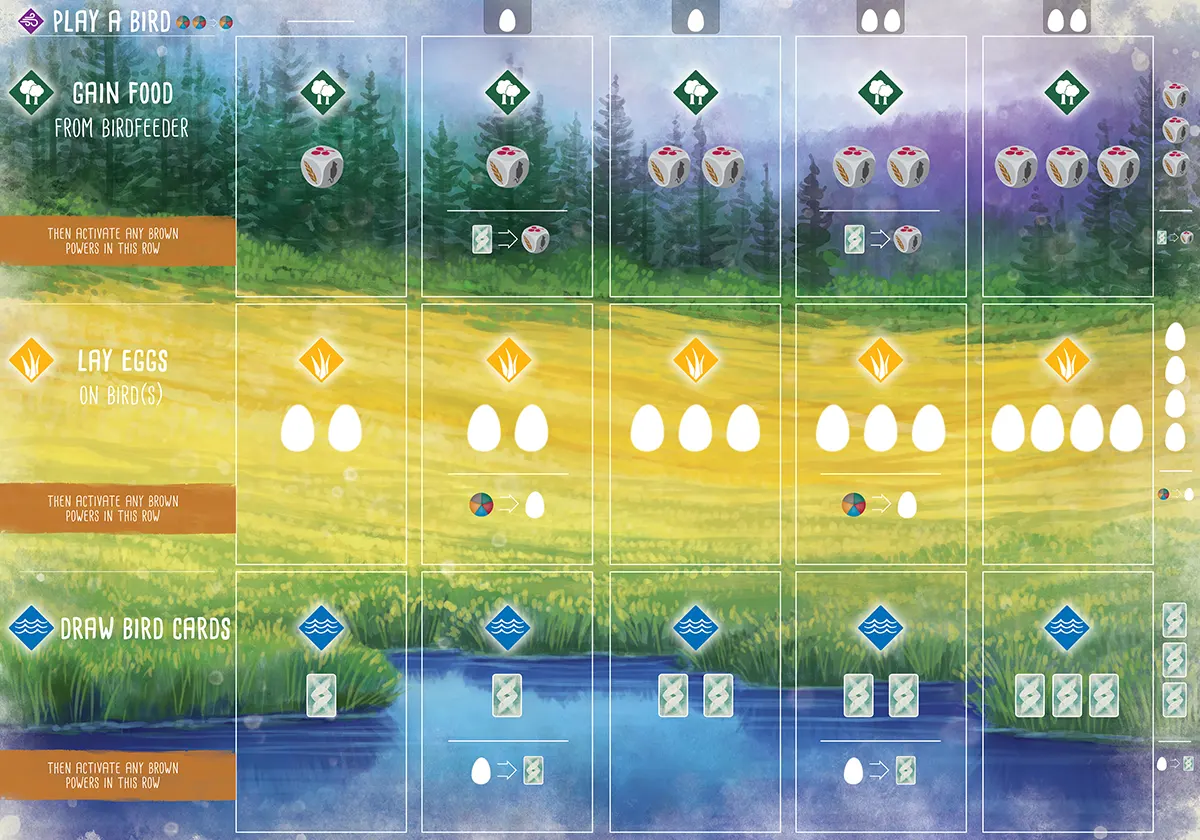
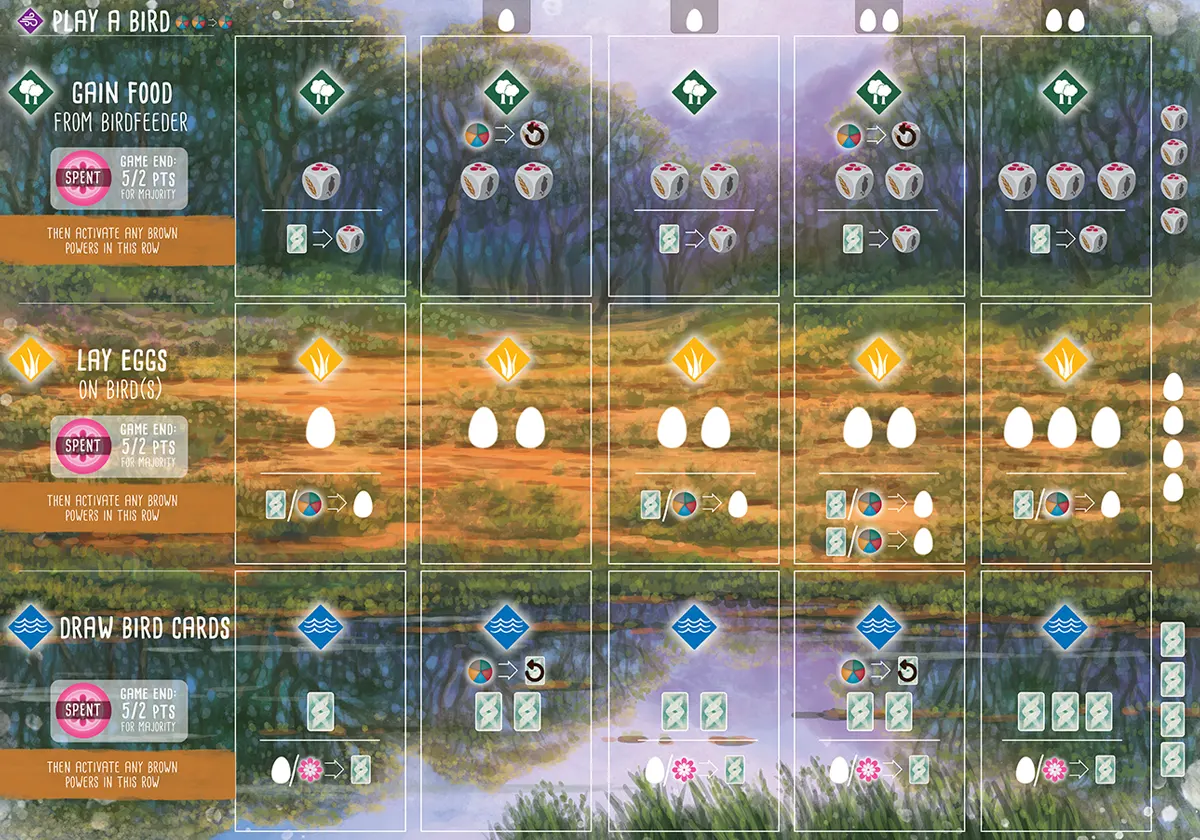
-
Play a Bird

 =
=  Reminder: You may spend any 2 food tokens as if they are any 1 food token.
Reminder: You may spend any 2 food tokens as if they are any 1 food token.Additional egg cost when playing a bird in this column.
-
Forest Habitat — Gain Food
 You may discard any 1 food to reset the birdfeeder.
You may discard any 1 food to reset the birdfeeder.
 Gain a food from the birdfeeder.
Gain a food from the birdfeeder.
 You may discard a bird card to gain an extra food from the birdfeeder.
You may discard a bird card to gain an extra food from the birdfeeder.
-
Grassland Habitat — Lay Eggs
/
 You may discard a bird card or any food token to lay an additional egg.
You may discard a bird card or any food token to lay an additional egg.
-
Wetland Habitat — Draw Bird Cards
 You may discard any 1 food to reset the bird tray.
You may discard any 1 food to reset the bird tray.
Draw a bird card from the deck or bird tray.
/ You may discard an egg token or a nectar token, to draw an additional bird card.
Use the actions on each space in the order they are printed: Reset if you are going to, then take food or cards.
Adjacency
If a card refers to adjacent birds, it’s referring to orthogonal adjacency (birds immediately to the left or right, and those immediately above or below the given bird).
Predator
With these powers, birds go hunting for a smaller bird, a rodent, or a fish. If they find one, they keep it, and it counts as a point at the end of the game.
Reset
-
When you reset the bird tray, discard the cards in the bird tray and refill it with three new cards from the bird deck.
-
When you reset the birdfeeder, re-roll all five food dice.
Scoring End-of-Round Goals

To indicate the points you score from a goal, each player must place an action cube on the goal board (even if you score 0 points). The board has 2 sides, each using a different scoring method. Green is the default, but blue is good for new players. Points are only awarded to the player who contributes the most to each end-of-round goal:
Green: Majority of the targeted item
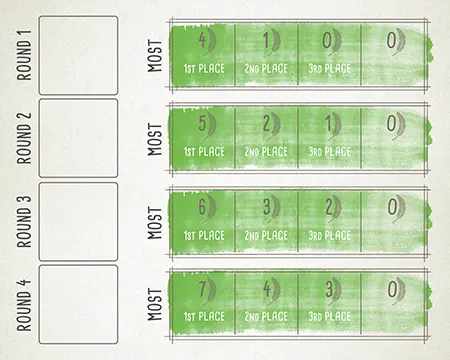
This method uses the side of the goal board that has spaces for 1st, 2nd, and 3rd place.
At the end of the round, count your quantity of the targeted item. Players compare their results and place their action cubes based on their rank order.
If players tie, place both cubes on the tied place, and do not award the next place. At game end, you will add the points for that place and the next place(s), then divide by the number of players who tied and round down (4th place scores 0 points).
For example, when using the goal that scores 5, 2, or 1 points, if two players tie for 1st place, each gets 3 points (5 + 2 divided by 2 players, rounded down). Do not award 2nd place to another player.
You must have at least 1 of the targeted items to score points for a goal. For example, you must have at least 1 grassland bird to score points for the “most birds in the grassland habitat” goal.
If you finish in 4th or 5th place, you must still place an action cube on the goal board in the space marked 0.
Blue: One point per targeted item
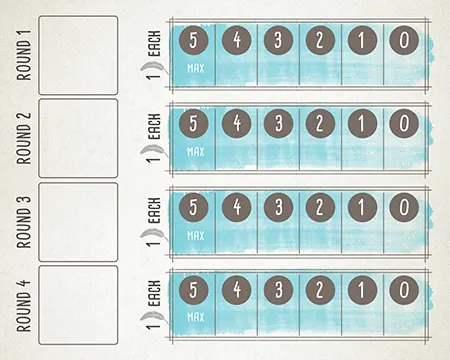
This method uses the side of the goal board that has spaces labeled 5–4–3–2–1–0 next to the space for each goal.
At the end of the round, count your quantity of the targeted item. Score 1 point per item, with a maximum of 5 points. Use an action cube to mark your score on the goal. If you do not have any of that item, you must still place an action cube on the goal board in the space marked 0.
- The player who comes first on the goal places a cube in the space marked above the goal tile and gets the points marked there.
- The player who comes second on the goal places their cube below the tile and gets zero points.
- The player who comes second on the goal also gets the first-player token for the next round.
- Ties are friendly: Both players get the points. In the case of a tie, the first-player token goes to the player who did not have it this round.
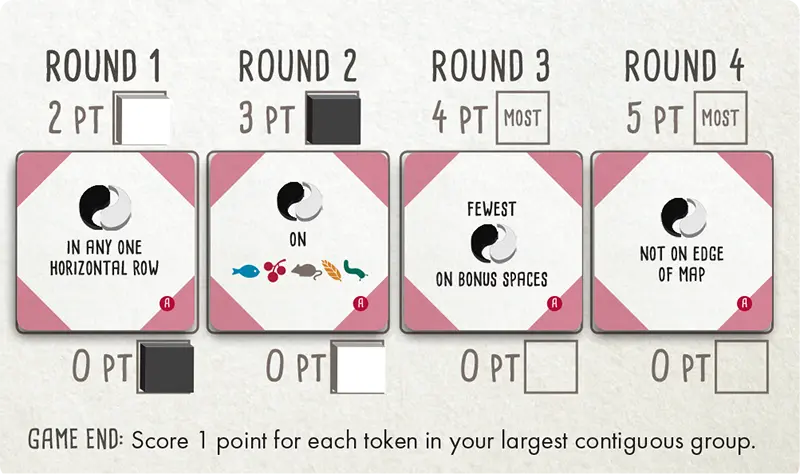
Example: Scoring Duet goals
Flock Mode Goal Board
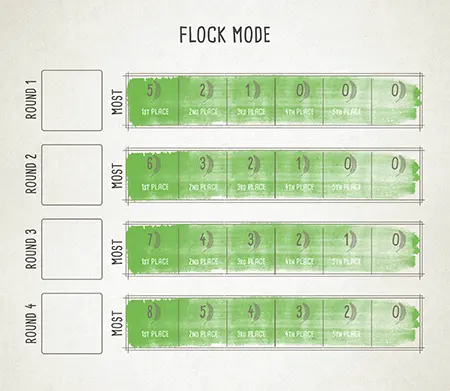
At the end of the round, count your quantity of the targeted item. Players compare their results and place their action cubes based on their rank order.
In Flock mode, ties are friendly: For example, if 2 players are tied for first place, they both get full points, and second place is still available.
You must have at least 1 of the targeted items to score points for a goal. For example, you must have at least 1 grassland bird to score points for the “most birds in the grassland habitat” goal.
Tucked Cards
Flocking bird powers and some predator powers allow you to tuck a card.
To tuck a card, place it face-down under a played bird card.
Each of these tucked cards are worth 1 VP at end of game.
Turn Structure
During each round, players take turns—proceeding clockwise—until each player has used all of their available action cubes.
On your turn, you will take 1 of 4 actions, as shown on the left side of your player mat:
-
Play a bird from your hand
-
Gain food and activate forest bird powers
-
Lay eggs and activate grassland bird powers
-
Draw bird cards and activate wetland bird powers
Using Action Cubes
To place a bird from your hand onto a habitat, place an action cube on the Play a Bird spot above where you will play the bird. Pay the bird’s food and egg cost, then place the bird on your mat, only triggering that bird’s “when played” power (if any).
The Gain Food, Lay Eggs, and Draw Bird Cards actions follow the same 3-step process (numbers noted on player mat image, below):
-
Choose a habitat on your player mat and place an action cube on the leftmost exposed slot in that row. Gain the benefit of that slot.
-
Move your action cube from right to left, activating any birds with a brown “when activated” power in that row. Each power is optional.
-
When the action cube reaches the far left, leave it there. Your turn is over.



Wingspan
Example: a 30 centimeter wingspan
The wingspan of each bird is used for comparison for some bird powers.
Flightless Birds
A few birds in the deck have a * symbol for their wingspan. These are flightless birds, and some have only vestigial wings. For any bird power or bonus card that contains a condition on wingspan, flightless birds function as wild cards. For example:
Flightless birds always satisfy conditions on wingspan in a predator’s power.
Flightless birds can be treated as having any value for bonus cards that give points for birds with wingspans in ascending or descending order.
Anatomist
Birds with body parts in their names
Count the birds you have played that have one of the following anatomical terms in their names. Different versions of these words (such as “bellied”) all count.
- back
- beak
- belly
- bill
- breast
- brow
- cap
- chin
- collar
- crest
- crown
- ear
- eye
- face
- foot
- head
- leg
- mouth
- nape
- neck
- rump
- shoulder
- tail
- throat
- toe
- vent
- wattle
- wing
Avian Theriogenologist
Birds with completely full nests
Count the number of birds that have the maximum possible number of eggs on them, according to their egg limit.
Birds with no egg capacity do not count towards this card—they do not have a full nest.
Backyard Birder
Birds worth less than 4 points
Count the birds you played that have a face value of 0, 1, 2, or 3 points.
Bird Counter
Birds with a power.
Count the birds you played that have the flocking symbol. The symbol should be on the left-hand side of the bird’s brown power.
Breeding Manager
Birds with at least 4 eggs laid on them
Count only bird cards that have 4 egg tokens sitting on them at game end.
Cartographer
Birds with geography terms in their names
Count the birds you have played that have one of the following geographical terms in their names. Different versions of these words (such as “Canadian”) all count:
- America
- Asia
- Atlantic
- Australasia
- Australia
- Baltimore
- California
- Canada
- Carolina
- Chihuahua
- Corsica
- desert
- East
- Eurasia
- Europe
- forest
- Himalaya
- Inca
- India
- island
- jungle
- mallee
- marsh
- Mississippi
- moor
- mountain
- New Holland
- North
- Orient
- Pacific
- Philippine
- plains
- prairie
- sandhill
- Savannah
- scrub
- sea
- South
- Sri Lanka
- West
Ecologist
Birds in your habitat with the fewest birds
Count the number of birds you played, in the habitat where you played the fewest birds. If you have two habitats tied for fewest birds, you may still score this bonus. For example, if all of your habitats have 3 birds in them, your habitat with the fewest birds has 3 birds in it.
Enclosure Builder
Birds that have a nest symbol
Count the number of birds you played that have the ground nest symbol shown on the card.
Star nests are wild. Birds with star nests count toward this bonus.
Endangered Species Protector
Birds that allow you to score or draw more bonus cards
Count how many birds you have that have the symbol shown—birds whose power allows you to draw a new bonus card. In this deck, these birds are:
- Indian Vulture
- Philippine Eagle
- White-headed Duck
- Spoon-billed Sandpiper
- Greater Adjutant
- Red-crowned Crane
- Crested Ibis
In addition, there is one bird—the Great Indian Bustard—that allows you to score a bonus card and keep it. That bird also counts for this bonus card.
Falconer
Birds with a power
Count the birds you played that have the predator symbol. The symbol should be on the left-hand side of the bird’s brown power.
Forest Data Analyst
Consecutive birds in with ascending or descending wingspans
This bonus card grants points for a long enough sequence of consecutive birds with wingspans in ascending or descending order in your forest habitat. The sequence need not consist of all birds in the habitat, and it need not start or end with the first or last bird in the habitat. A sequence may include two or more birds with the same wingspan.
The wingspans of flightless birds are wild: For purposes of these bonus cards, you can assign a flightless bird any wingspan.
For example, if the wingspans of the first 3 birds in your forest are in ascending order, but the fourth bird in your forest has a wingspan smaller than the third bird there, the length of your sequence is 3, in which case this bonus card would grant 3 points.
Forest Population Monitor
Different nest types in
For the birds that you played into the forest, count how many different nest types you have.
You may count each star nest as any other type or as a fifth type. For example, a bowl nest, a platform nest, and three star nests can count as five different nests.
Birds with no nest do not count as having a nest type.
Forest Ranger
Consecutive birds in with ascending or descending scores
Within the forest, this bonus card grants points for a sequence of birds that is in ascending or descending order by their point value.
- The birds in the sequence must be in a continuous line on the board. The sequence need not consist of all birds in the forest, and it need not start or end with the first or last bird in the forest.
- Numbers need not be consecutive, as long as they are ascending or descending.
Forester
Birds that can only live in the habitat
Count the number of birds you played that only have the forest habitat symbol. If a bird has the option to live in more than one type of habitat, it cannot count toward this bonus.
Grassland Data Analyst
Consecutive birds in with ascending or descending wingspans
This bonus card grants points for a long enough sequence of consecutive birds with wingspans in ascending or descending order in your grassland habitat. The sequence need not consist of all birds in the habitat, and it need not start or end with the first or last bird in the habitat. A sequence may include two or more birds with the same wingspan.
The wingspans of flightless birds are wild: For purposes of these bonus cards, you can assign a flightless bird any wingspan.
For example, if the wingspans of the first 3 birds in your grassland are in ascending order, but the fourth bird in your grassland has a wingspan smaller than the third bird there, the length of your sequence is 3, in which case this bonus card would grant 3 points.
Grassland Population Monitor
Different nest types in
For the birds that you played into the grassland, count how many different nest types you have.
You may count each star nest as any other type or as a fifth type. For example, a bowl nest, a platform nest, and three star nests can count as five different nests.
Birds with no nest do not count as having a nest type.
Grassland Ranger
Consecutive birds in with ascending or descending scores
Within the grassland, this bonus card grants points for a sequence of birds that is in ascending or descending order by their point value.
- The birds in the sequence must be in a continuous line on the board. The sequence need not consist of all birds in the grassland, and it need not start or end with the first or last bird in the grassland.
- Numbers need not be consecutive, as long as they are ascending or descending.
Historian
Birds named after a person
Count the birds you have played that have a ‘s in their name. Names include:
- Anna’s
- Baird’s
- Barrow’s
- Bell’s
- Bewick’s
- Brewer’s
- Cassin’s
- Clark’s
- Cooper’s
- Forster’s
- Franklin’s
- Lincoln’s
- Say’s
- Sprague’s
- Steller’s
- Swainson’s
- Wilson’s
Omnivore Expert
Birds that eat 
The the percentage of birds that apply to this card should be 16%, not 10%.
Large Bird Specialist
Birds with wingspans over 65cm
Count the birds you played that have wingspans over 65cm. Wingspans of exactly 65cm do not count toward this bonus.
Mechanical Engineer
Sets of the 4 nest types
This card is looking for sets of the four nest types among all of your birds. The order and location of the nests do not matter; it only matters that each set includes all four nest types.
Each star nest can be substituted for one nest of any type in one set. For example:
- a cavity nest, a platform nest, and two stars would be a complete set.
- two cavity nests, two platform nests, a bowl nest, a ground nest, and two stars would be two complete sets.
- two bowl nests, two cavity nests, two platform nests, and one star nest count as one set, not two, because the star nest can only be a member of one set.
Nest Box Builder
Birds that have a nest symbol
Count the number of birds you played that have the cavity nest symbol shown on the card.
Star nests are wild. Birds with star nests count toward this bonus.
Oologist
Birds that have at least 1 egg laid on them
Count only bird cards that have at least 1 egg token sitting on them at game end.
Passerine Specialist
Birds with wingspans 30cm or less
Count the birds you played that have wingspans 30cm or less. Wingspans of exactly 30cm count toward this bonus.
Pellet Dissector
and tokens cached on birds
Count how many fish and rodent tokens you have cached on your bird cards.
Photographer
Birds with colors in their names
Count the birds you have played that have one of the following words in their name. Each bird counts just once, even if it has multiple colors in its name. Different versions of these words (such as “rosy”) all count. Colors include:
- ash
- azure
- bay
- black
- blue
- bronze
- brown
- cerulean
- chestnut
- coal
- crimson
- emerald
- ferruginous
- fire
- gold
- gray
- green
- indigo
- lazuli
- olive
- orange
- pink
- plumbeous
- purple
- red
- rose
- ruby
- ruddy
- rufous
- silver
- snow
- sulphur
- tawny
- teal
- verditer
- violet
- white
- yellow
Platform Builder
Birds that have a nest symbol
Count the number of birds you played that have the platform nest symbol shown on the card.
Star nests are wild. Birds with star nests count toward this bonus.
Prairie Manager
Birds that can only live in the habitat
Count the number of birds you played that only have the grassland habitat symbol. If a bird has the option to live in more than one type of habitat, it cannot count toward this bonus.
Site Selection Expert
Columns with a matching pair or trio of nests
This bonus card grants points for each column that contains more than one nest of some type. A column is worth 0, 1, or 3 points, according to whether it has 0, 2, or 3 matching nests in that column, respectively. Different columns may (but need not) score using different nest types.
Star nests are wild. A single star nest counts only once; it cannot be used to match 2 different kinds of nests in the same column.
Small Clutch Specialist
Birds with an egg limit of 2 or less
Look at the egg limit printed on each bird card, and count the number of birds whose egg limit is 2 or less. You may include birds that do not have an egg limit—their egg limit is zero (less than 2).
For this card, it does not matter whether the birds have eggs on them.
Visionary Leader
Birds in your hand at end of game
Count the bird cards still in your hand at the end of the game.
Wetland Data Analyst
Consecutive birds in with ascending or descending wingspans
This bonus card grants points for a long enough sequence of consecutive birds with wingspans in ascending or descending order in your wetland habitat. The sequence need not consist of all birds in the habitat, and it need not start or end with the first or last bird in the habitat. A sequence may include two or more birds with the same wingspan.
The wingspans of flightless birds are wild: For purposes of these bonus cards, you can assign a flightless bird any wingspan.
For example, if the wingspans of the first 3 birds in your wetland are in ascending order, but the fourth bird in your wetland has a wingspan smaller than the third bird there, the length of your sequence is 3, in which case this bonus card would grant 3 points.
Wetland Population Monitor
Different nest types in
For the birds that you played into the wetland, count how many different nest types you have.
You may count each star nest as any other type or as a fifth type. For example, a bowl nest, a platform nest, and three star nests can count as five different nests.
Birds with no nest do not count as having a nest type.
Wetland Ranger
Consecutive birds in with ascending or descending scores
Within the wetland, this bonus card grants points for a sequence of birds that is in ascending or descending order by their point value.
- The birds in the sequence must be in a continuous line on the board. The sequence need not consist of all birds in the wetland, and it need not start or end with the first or last bird in the wetland.
- Numbers need not be consecutive, as long as they are ascending or descending.
Wetland Scientist
Birds that can only live in the habitat
Count the number of birds you played that only have the wetland habitat symbol. If a bird has the option to live in more than one type of habitat, it cannot count toward this bonus.
Wildlife Gardener
Birds that have a nest symbol
Count the number of birds you played that have the bowl nest symbol shown on the card.
Star nests are wild. Birds with star nests count toward this bonus.
Winter Feeder
Food remaining in your supply at game end
Count how many unspent food tokens you have at the end of the game. Food cached on birds does not count as part of your supply.
Australasian Pipit
Game end: Tuck 1 from the deck behind each bird in your , including this one.
Australian Magpie
Game end: Discard 1 from each bird in this row and column that has an on it, excluding this bird. For each discarded , cache 2 from the supply on this bird.
Australian Raven
Game end: Cache up to 5  from your supply on this bird.
from your supply on this bird.
Black Swan
Game end: Lay 1 on each of your birds with a wingspan over 100cm, including this one.
Flightless birds count as wild for wingspan requirements, so eggs may be laid on them for each of these bird powers, even though they are contradictory.
Eggs are laid after scoring the round-end goal for Round 4.
Crested Pigeon
Game end: Cache up to 8 from your supply on this bird.
Gould’s Finch
Game end: Play a bird. Pay its normal food and egg cost. If it has a “when played” or “game end” power, you may use it.
The bird’s normal cost includes the egg cost of the column that you play it into.
As usual, you cannot activate other types of bird powers (such as “round end” powers) when you play a bird with this action.
Grey-Headed Mannikin
Game end: Play a bird. Pay its normal food cost, but ignore 1 in its egg cost. If it has a “when played” or “game end” power, you may use it.
As usual, you cannot activate other types of bird powers (such as “round end” powers) when you play a bird with this action.
You will have already discarded nectar when the Grey-Headed Mannikin is activated, so if you want to use it to play a bird with a nectar cost, you will need to use the 2:1 food conversion to obtain the nectar.
Kākāpō
Game end: Draw 4 bonus cards, keep 1, and discard the other 3.
Little Pied Cormorant
Game end: Lay 1 on each of your birds with a nest, including this one.
You may count star nests as wild and include them when you lay eggs.
Eggs are laid after scoring the round-end goal for Round 4.
Magpie-Lark
Game end: Discard 2 from your . If you do, play 1 bird in your at its normal food cost (ignore its egg cost). If it has a “when played” or “game end” power, you may use it.
Malleefowl
Game end: Lay 1 on each of your birds with a nest, including this one.
You may count star nests as wild and include them when you lay eggs.
Eggs are laid after scoring the round-end goal for Round 4.
Orange-Footed Scrubfowl
Game end: Lay 1 on each of your birds with a nest, including this one.
You may count star nests as wild and include them when you lay eggs.
Eggs are laid after scoring the round-end goal for Round 4.
Pacific Black Duck
Game end: For every 2 in your , lay 1 on this bird.
The egg limit of this bird still applies. For example, if you have 6 eggs in your wetland but only space for 1 more egg on this bird, you lay 1 egg.
Round down (i.e., if you have 5 eggs in your wetland, lay 2 eggs).
Eggs are laid after scoring the round-end goal for Round 4.
Red-Backed Fairywren
Game end: Lay 1 on each of your birds with a nest, including this one.
This bird lays eggs only on birds with the star nest icon.
Eggs are laid after scoring the round-end goal for Round 4.
Splendid Fairywren
Game end: Lay 1 on each of your birds with a wingspan less than 30cm, including this one.
Flightless birds count as wild for wingspan requirements, so eggs may be laid on them for each of these bird powers, even though they are contradictory.
Eggs are laid after scoring the round-end goal for Round 4.
Spotless Crake
Game end: Lay 1 on each bird in your , including this one.
Eggs are laid after scoring the round-end goal for Round 4.
American Avocet
Once between turns: When another player takes the “lay eggs” action, this bird lays 1 on another bird with a nest.
This bird is a nest parasite in the wild: it lays eggs in other birds’ nests.
When another player uses the grassland action to lay eggs, you may lay 1 egg. You may do this only once between your turns, no matter how many other players lay eggs. This bird can lay eggs on star nests.
Australian Owlet-Nightjar
Once between turns: When another player takes the “gain food” action, gain 1 from the birdfeeder, if there is one, at the end of their turn.
Barrow’s Goldeneye
Once between turns: When another player takes the “lay eggs” action, this bird lays 1 on another bird with a nest.
This bird is a nest parasite in the wild: it lays eggs in other birds’ nests.
When another player uses the grassland action to lay eggs, you may lay 1 egg. You may do this only once between your turns, no matter how many other players lay eggs. This bird can lay eggs on star nests.
Belted Kingfisher
Once between turns: When another player plays a bird, gain 1 from the supply.
Activate this power when a player uses the “Play a bird” action to play a bird into the wetland habitat. A bird that uses its power to move into the habitat does not trigger this power.
Black Vulture
Once between turns: When another player’s succeeds, gain 1  from the birdfeeder.
from the birdfeeder.
If multiple players trigger this power at the same time, they gain food in turn order, starting to the left of the active player (the one whose predator succeeded).
Black-Billed Magpie
Once between turns: When another player’s succeeds, gain 1  from the birdfeeder.
from the birdfeeder.
If multiple players trigger this power at the same time, they gain food in turn order, starting to the left of the active player (the one whose predator succeeded).
Bronzed Cowbird
Once between turns: When another player takes the “lay eggs” action, this bird lays 1 on another bird with a nest.
This bird is a nest parasite in the wild: it lays eggs in other birds’ nests.
When another player uses the grassland action to lay eggs, you may lay 1 egg. You may do this only once between your turns, no matter how many other players lay eggs. This bird can lay eggs on star nests.
Brown-Headed Cowbird
Once between turns: When another player takes the “lay eggs” action, this bird lays 1 on another bird with a nest.
This bird is a nest parasite in the wild: it lays eggs in other birds’ nests.
When another player uses the grassland action to lay eggs, you may lay 1 egg. You may do this only once between your turns, no matter how many other players lay eggs. This bird can lay eggs on star nests.
Common Cuckoo
Once between turns: When another player takes the “lay eggs” action, this bird lays 1 on another bird with a or nest.
Star nests count as bowl nests or ground nests for this bird.
Eastern Kingbird
Once between turns: When another player plays a bird, gain 1 from the supply.
Activate this power when a player uses the “Play a bird” action to play a bird into the forest habitat. A bird that uses its power to move into the habitat does not trigger this power.
Eurasian Golden Oriole
Once between turns: When another player takes the “gain food” action, gain 1 or from the birdfeeder at the end of their turn.
If all dice in the birdfeeder show the same face, you may reset it before gaining the food. If the birdfeeder contains no invertebrate or fruit, you gain nothing.
Eurasian Tree Sparrow
Once between turns: When another player takes the “gain food” action, gain 1 from the birdfeeder at the end of their turn.
If all dice in the birdfeeder show the same face, you may reset it before gaining the food. If the birdfeeder contains no seed, you gain nothing.
European Goldfinch
Once between turns: When another player tucks a for any reason, tuck 1 from the deck behind this bird.
Horned Lark
Once between turns: When another player plays a bird, tuck a from your hand behind this bird.
This is specifically referring to birds played into the grassland habitat.
Horsfield’s Bronze-Cuckoo
Once between turns: When another player takes the “lay eggs” action, lay 1 on a bird with a wingspan less than 30cm.
Loggerhead Shrike
Once between turns: When another player takes the “gain food” action, if they gain any number of , also gain 1 from the supply and cache it on this card.
This bird is known for caching extra food and saving it for later. As noted on this card, you can cache exactly 1 food token when its power is activated by placing it on the bird card. Once a food token is cached on a bird card, you cannot spend it. Each token on the card at the end of the game is worth 1 point. If you run out of food tokens, you can cache cards instead.
Pheasant Coucal
Once between turns: When another player takes the “lay eggs” action, lay 1 on this bird.
Sacred Kingfisher
Once between turns: When another player takes the “gain food” action, gain 1 , , or from the birdfeeder, if there is one, at the end of their turn.
Before gaining this food, you may reroll the dice in the birdfeeder if they are all showing one face.
Snow Bunting
Once between turns: When another player tucks a for any reason, tuck 1 from your hand behind this bird, then draw 1 at the end of their turn.
Spangled Drongo
Once between turns: When another player gains , gain 1 from the supply.
Turkey Vulture
Once between turns: When another player’s succeeds, gain 1  from the birdfeeder.
from the birdfeeder.
If multiple players trigger this power at the same time, they gain food in turn order, starting to the left of the active player (the one whose predator succeeded).
Yellow-Billed Cuckoo
Once between turns: When another player takes the “lay eggs” action, this bird lays 1 on another bird with a nest.
This bird is a nest parasite in the wild: it lays eggs in other birds’ nests.
When another player uses the grassland action to lay eggs, you may lay 1 egg. You may do this only once between your turns, no matter how many other players lay eggs. This bird can lay eggs on star nests.
Black Redstart
Round end: Choose a habitat with no . Lay 1 on each bird in that habitat.
Carrion Crow
Round end: Choose any 1 player (including yourself). Cache 1 from the supply on this bird for each that player has.
Cetti’s Warbler
Round end: This bird counts double toward the end-of-round goal, if it qualifies for the goal.
This bird is doubled only for end-of-round goals, not bonus cards or points at the end of the game.
Eggs on this card are not doubled, if the goal is counting the number of eggs.
Common Goldeneye
Round end: Lay 1 on this bird for each other bird with a nest that you have.
Star nests count as cavity nests for this bird.
Common Starling
Round end: Discard up to 5  from your supply. For each, tuck 1 from the deck behind this bird.
from your supply. For each, tuck 1 from the deck behind this bird.
Common Swift
Round end: Discard up to 5 from your supply. For each, tuck 1 from the deck behind this bird.
Dunnock
Round end: Choose 1 other player. For each action cube on their , lay 1 on this bird.
Eurasian Collared-Dove
Round end: Discard up to 5  from your supply. For each, tuck 1 from the deck behind this bird.
from your supply. For each, tuck 1 from the deck behind this bird.
Eurasian Green Woodpecker
Round end: This bird counts double toward the end-of-round goal, if it qualifies for the goal.
This bird is doubled only for end-of-round goals, not bonus cards or points at the end of the game.
Eggs on this card are not doubled, if the goal is counting the number of eggs.
Eurasian Magpie
Round end: Choose 1 other player. For each action cube in their , cache 1  from the supply on any of your birds.
from the supply on any of your birds.
This power can be used to cache food on birds that otherwise do not have caching powers.
European Honey Buzzard
Round end: Reset the birdfeeder. If you do, gain all in the birdfeeder after resetting.
If the specified food type is not in the birdfeeder after the reset, you gain nothing.
Greylag Goose
Round end: This bird counts double toward the end-of-round goal, if it qualifies for the goal.
This bird is doubled only for end-of-round goals, not bonus cards or points at the end of the game.
Eggs on this card are not doubled, if the goal is counting the number of eggs.
Griffon Vulture
Round end: Choose any 1 player (including yourself). Cache 1 from the supply on this bird for each that player has.
Hooded Crow
Round end: Choose 1 other player. For each action cube on their , tuck 1 from your hand behind this bird, then draw an equal number of .
You may tuck cards up to the number of action cubes.
House Sparrow
Round end: Discard up to 5 from your supply. For each, tuck 1 from the deck behind this bird.
Lesser Whitethroat
Round end: Choose a habitat with no . Lay 1 on each bird in that habitat.
Moltoni’s Warbler
Round end: If you used all 4 types of actions this round, play another bird. Pay its normal food and egg cost.
If the additional bird has a “when played” power, it is triggered when the bird is played.
If the extra bird has a “round end” power, it is triggered when the bird is played.
Ruff
Round end: Tuck up to 3 from your hand behind this bird. Draw 1 for each card you tucked.
White Wagtail
Round end: If you used all 4 types of actions this round, play another bird. Pay its normal food and egg cost.
If the additional bird has a “when played” power, it is triggered when the bird is played.
If the extra bird has a “round end” power, it is triggered when the bird is played.
Yellowhammer
Round end: If you used all 4 types of actions this round, play another bird. Pay its normal food and egg cost.
If the additional bird has a “when played” power, it is triggered when the bird is played.
If the extra bird has a “round end” power, it is triggered when the bird is played.
Acorn Woodpecker
When activated: Gain 1 from the birdfeeder (if available). You may cache it on this card.
This bird is known for caching extra food and saving it for later. As noted on this card, you can cache exactly 1 food token when its power is activated by placing it on the bird card. Once a food token is cached on a bird card, you cannot spend it. Each token on the card at the end of the game is worth 1 point. If the same dice are showing in the birdfeeder, you may reroll to see if you meet the condition of the bird. If you run out of food tokens, you can cache cards instead.
American Bittern
When activated: Player(s) with the fewest birds: draw 1 .
If players are tied for the fewest birds currently in the wetland habitat, all draw a card, starting with you and proceeding clockwise. All may draw from the deck or the face-up cards.
American Coot
When activated: Tuck a from your hand behind this bird. If you do, draw 1 .
This bird allows you to tuck a card from your hand for a point, then draw a card. You can only draw a card if you first tuck a card from your hand.
American Crow
When activated: Discard 1 from any of your other birds to gain 1  from the supply.
from the supply.
This bird is known for eating eggs from other birds’ nests. You must have laid an egg on another bird before you can use this power. Discard the egg to the supply.
American Kestrel
When activated: Roll all dice not in birdfeeder. If any are , gain 1 and cache it on this card.
Birds that eat rodents roll all dice that are not in the birdfeeder. (Note that you will never roll more than 4 dice, because when all 5 dice are out of the birdfeeder it must reset immediately.) Roll dice on the table; they do not go back into the birdfeeder. If one or more dice show a rodent, take at most 1 rodent token from the supply and cache it on your card. Each token on a bird card is worth 1 point at the end of the game.
American Redstart
When activated: Gain 1  from the birdfeeder.
from the birdfeeder.
American Robin
When activated: Tuck a from your hand behind this bird. If you do, draw 1 .
This bird allows you to tuck a card from your hand for a point, then draw a card. You can only draw a card if you first tuck a card from your hand.
American White Pelican
When activated: Discard a to tuck 2 from the deck behind this bird.
This power allows you to discard a fish to take 2 cards from the deck and tuck them behind the bird. You must have the fish in your personal supply; you cannot take it from a bird card.
Anhinga
When activated: Roll all dice not in birdfeeder. If any are , gain 1 and cache it on this card.
Birds that eat fish roll all dice that are not in the birdfeeder. (Note that you will never roll more than 4 dice, because when all 5 dice are out of the birdfeeder it must reset immediately.) Roll dice on the table; they do not go back into the birdfeeder. If one or more dice show a fish, take at most 1 fish token from the supply and cache it on your card. Each token on a bird card is worth 1 point at the end of the game.
Anna’s Hummingbird
When activated: Each player gains 1  from the birdfeeder, starting with the player of your choice.
from the birdfeeder, starting with the player of your choice.
The hummingbird’s owner decides which person gains the first food, and then players gain food in turn order. Players may reset the birdfeeder if it is empty or if all dice are showing the same face.
Audouin’s Gull
When activated: Draw 2 from the deck. Tuck 1 behind this bird and keep the other.
Australasian Shoveler
When activated: Choose 1 other player. You both draw 1 from the deck.
Australian Ibis
When activated: Shuffle the discard pile, then draw 2 from it. Choose 1 and tuck it behind this bird or add it to your hand. Discard the other.
The discard pile remains separate from the bird deck, even after you shuffle and draw from it.
Australian Shelduck
When activated: Draw 1 face-up from the tray with a or nest. You may reset or refill the tray before doing so.
Before drawing a face-up card with the nest type shown, you may:
- reset the tray (discard all face-up cards and put out 3 new face-up cards), or
- refill the tray (place new cards from the deck in any empty slots), or
- leave the tray as-is.
Australian Zebra Finch
When activated: If the player to your right has a in their personal supply, tuck a from the deck behind this bird.
Baird’s Sparrow
When activated: Lay 1 on any bird.
Baltimore Oriole
When activated: All players gain 1 from the supply.
Barn Owl
When activated: Roll all dice not in birdfeeder. If any are , gain 1 and cache it on this card.
Birds that eat rodents roll all dice that are not in the birdfeeder. (Note that you will never roll more than 4 dice, because when all 5 dice are out of the birdfeeder it must reset immediately.) Roll dice on the table; they do not go back into the birdfeeder. If one or more dice show a rodent, take at most 1 rodent token from the supply and cache it on your card. Each token on a bird card is worth 1 point at the end of the game.
Barn Swallow
When activated: Tuck a from your hand behind this bird. If you do, draw 1 .
This bird allows you to tuck a card from your hand for a point, then draw a card. You can only draw a card if you first tuck a card from your hand.
Barred Owl
When activated: Look at a from the deck. If <75cm, tuck it behind this bird. If not, discard it.
This bird eats other birds. Look at the wingspan of the top card of the deck and compare it to this bird’s hunting power.
If the wingspan of the top card in the deck is less than this bird’s hunting power, tuck that card to signify that your predator hunted successfully. Each tucked card is worth 1 point at the end of the game.
If the wingspan of the top card is equal to or larger than your predator’s power, discard the card instead.
Bewick’s Wren
When activated: If this bird is to the right of all other birds in its habitat, move it to another habitat.
This bird is able to live in a variety of habitats, and its power is to move from habitat to habitat—but only if it’s the last bird in that row. (It can be in any column.) This can be powerful for increasing your abilities in multiple habitats, and for scoring on end-of-round goals. Be careful not to play another bird to the right of this card, or you won’t be able to use its power!
Black Noddy
When activated: Reset the birdfeeder and gain all , if there are any. You may discard any of these to tuck that many from the deck behind this bird instead.
Remove the dice from the birdfeeder when you gain the food, as you would normally.
Black Skimmer
When activated: Roll all dice not in birdfeeder. If any are , gain 1 and cache it on this card.
Birds that eat fish roll all dice that are not in the birdfeeder. (Note that you will never roll more than 4 dice, because when all 5 dice are out of the birdfeeder it must reset immediately.) Roll dice on the table; they do not go back into the birdfeeder. If one or more dice show a fish, take at most 1 fish token from the supply and cache it on your card. Each token on a bird card is worth 1 point at the end of the game.
Black Tern
When activated: Draw 1 . If you do, discard 1 from your hand at the end of your turn.
This power adds cards to the wetland’s draw card(s) action, but it has a cost. The next player may start their turn while you are deciding which card(s) to discard.
Black Woodpecker
When activated: Gain all that are in the birdfeeder.
If there is only one die face showing at the beginning of this action, you may reset the birdfeeder and then take all the invertebrates.
This action is completed once you have gained all of this type of food that are showing. If the birdfeeder becomes empty and resets as a result of this action, you do not gain additional food after the reset. If there is only one die face showing after taking all the invertebrates, you may not reset the birdfeeder to look for more.
Black-Bellied Whistling-Duck
When activated: Discard 1 to tuck 2 from the deck behind this bird.
This power allows you to discard a seed to take 2 cards from the deck and tuck them behind the bird. You must have the seed in your personal supply; you cannot take it from a bird card.
Black-Chinned Hummingbird
When activated: All players gain a from the supply.
Black-Crowned Night-Heron
When activated: Discard 1 from any of your other birds to gain 1  from the supply.
from the supply.
This bird is known for eating eggs from other birds’ nests. You must have laid an egg on another bird before you can use this power. Discard the egg to the supply.
Black-headed Gull
When activated: Steal 1  from another player’s supply and add it to your own supply. They gain 1
from another player’s supply and add it to your own supply. They gain 1  from the birdfeeder.
from the birdfeeder.
The food that the other player gains does not have to be the same type stolen.
Black-Shouldered Kite
When activated: Reset the birdfeeder and gain 1 , if there is one. You may give it to another player; if you do, lay up to 3 on this bird.
Remove the die from the birdfeeder when you gain the food, as you would normally.
Black-throated Diver
When activated: Discard all remaining face-up and refill the tray. If you do, draw 1 of the new face-up .
Blue Grosbeak
When activated: If this bird is to the right of all other birds in its habitat, move it to another habitat.
This bird is able to live in a variety of habitats, and its power is to move from habitat to habitat—but only if it’s the last bird in that row. (It can be in any column.) This can be powerful for increasing your abilities in multiple habitats, and for scoring on end-of-round goals. Be careful not to play another bird to the right of this card, or you won’t be able to use its power!
Blue Jay
When activated: Gain 1 from the birdfeeder (if available). You may cache it on this card.
This bird is known for caching extra food and saving it for later. As noted on this card, you can cache exactly 1 food token when its power is activated by placing it on the bird card. Once a food token is cached on a bird card, you cannot spend it. Each token on the card at the end of the game is worth 1 point. If the same dice are showing in the birdfeeder, you may reroll to see if you meet the condition of the bird. If you run out of food tokens, you can cache cards instead.
Blue-Gray Gnatcatcher
When activated: Gain 1 from the supply.
Bluethroat
When activated: Choose a food type. All players gain 1 of that food from the supply.
Brewer’s Blackbird
When activated: Tuck a from your hand behind this bird. If you do, also lay 1 on this bird.
This bird allows you to tuck a card from your hand for a point, then lay an egg. You can only lay an egg if you first tuck a card from your hand.
Broad-Winged Hawk
When activated: Roll all dice not in birdfeeder. If any are a , gain 1 and cache it on this card.
Brolga
When activated: Choose 1 other player. They lay 1 ; you draw 2 .
You may draw cards even if the other player is unable to lay an egg.
Brown Falcon
When activated: Look at a from the deck. If its food cost includes an or a , tuck it behind this bird. If not, discard it.
Budgerigar
When activated: Tuck the smallest bird in the tray behind this bird.
The size of the bird refers to its wingspan. If there is a tie for the smallest bird, you choose.
Bullfinch
When activated: Reset the birdfeeder. If you do, gain 1 or from the birdfeeder after resetting.
If the specified food type is not in the birdfeeder after the reset, you gain nothing.
Burrowing Owl
When activated: Roll all dice not in birdfeeder. If any are , gain 1 and cache it on this card.
Birds that eat rodents roll all dice that are not in the birdfeeder. (Note that you will never roll more than 4 dice, because when all 5 dice are out of the birdfeeder it must reset immediately.) Roll dice on the table; they do not go back into the birdfeeder. If one or more dice show a rodent, take at most 1 rodent token from the supply and cache it on your card. Each token on a bird card is worth 1 point at the end of the game.
Bushtit
When activated: Tuck a from your hand behind this bird. If you do, also lay 1 on this bird.
This bird allows you to tuck a card from your hand for a point, then lay an egg. You can only lay an egg if you first tuck a card from your hand.
California Quail
When activated: Lay 1 on this bird.
Canada Goose
When activated: Discard 1 to tuck 2 from the deck behind this bird.
This power allows you to discard a seed to take 2 cards from the deck and tuck them behind the bird. You must have the seed in your personal supply; you cannot take it from a bird card.
Canvasback
When activated: All players draw 1 from the deck.
Carolina Chickadee
When activated: Gain 1 from the supply and cache it on this card.
This bird is known for caching extra food and saving it for later. As noted on this card, you can cache exactly 1 food token when its power is activated by placing it on the bird card. Once a food token is cached on a bird card, you cannot spend it. Each token on the card at the end of the game is worth 1 point. If you run out of food tokens, you can cache cards instead.
Cassin’s Sparrow
When activated: Lay 1 on any bird.
Cedar Waxwing
When activated: Tuck a from your hand behind this bird. If you do, gain 1 from the supply.
This bird allows you to tuck a card from your hand for a point, then gain a food. You can only gain a food if you first tuck a card from your hand.
Chihuahuan Raven
When activated: Discard 1 from any of your other birds to gain 2  from the supply.
from the supply.
This bird is known for eating eggs from other birds’ nests. You must have laid an egg on another bird before you can use this power. Discard the egg to the supply.
Chimney Swift
When activated: If this bird is to the right of all other birds in its habitat, move it to another habitat.
This bird is able to live in a variety of habitats, and its power is to move from habitat to habitat—but only if it’s the last bird in that row. (It can be in any column.) This can be powerful for increasing your abilities in multiple habitats, and for scoring on end-of-round goals. Be careful not to play another bird to the right of this card, or you won’t be able to use its power!
Chipping Sparrow
When activated: Lay 1 on any bird.
Clark’s Grebe
When activated: Draw 1 . If you do, discard 1 from your hand at the end of your turn.
This power adds cards to the wetland’s draw card(s) action, but it has a cost. The next player may start their turn while you are deciding which card(s) to discard.
Clark’s Nutcracker
When activated: Gain 1 from the birdfeeder (if available). You may cache it on this card.
This bird is known for caching extra food and saving it for later. As noted on this card, you can cache exactly 1 food token when its power is activated by placing it on the bird card. Once a food token is cached on a bird card, you cannot spend it. Each token on the card at the end of the game is worth 1 point. If the same dice are showing in the birdfeeder, you may reroll to see if you meet the condition of the bird. If you run out of food tokens, you can cache cards instead.
Coal Tit
When activated: Gain 1 from the supply and cache it on this card. At any time, you may spend cached on this card.
Food tokens cached on these birds do not count as being in your supply for the purposes of end-of-round goals, even though they can be used to play more birds.
Cockatiel
When activated: Discard 1 to choose a from the tray and tuck it behind this bird.
Choosing and tucking using this bird’s power comprise a single action. You may not use this power to draw a card into your hand.
Common Chaffinch
When activated: Choose 1-5 birds in this habitat. Tuck 1 from your hand behind each.
This power can be used to tuck cards behind birds that do not usually tuck cards.
Common Chiffchaff
When activated: Choose 1-5 birds in this habitat. Tuck 1 from your hand behind each.
This power can be used to tuck cards behind birds that do not usually tuck cards.
Common Grackle
When activated: Tuck a from your hand behind this bird. If you do, also lay 1 on this bird.
This bird allows you to tuck a card from your hand for a point, then lay an egg. You can only lay an egg if you first tuck a card from your hand.
Common Kingfisher
When activated: Steal 1 from another player’s supply and cache it on this bird. They gain 1  from the birdfeeder.
from the birdfeeder.
The food that the other player gains does not have to be the same type stolen.
Common Little Bittern
When activated: Gain 1 face-up that can live in .
If no card with that habitat is available, do not gain anything.
Common Loon
When activated: Player(s) with the fewest birds: draw 1 .
If players are tied for the fewest birds currently in the wetland habitat, all draw a card, starting with you and proceeding clockwise. All may draw from the deck or the face-up cards.
Common Merganser
When activated: Roll all dice not in birdfeeder. If any are , gain 1 and cache it on this card.
Birds that eat fish roll all dice that are not in the birdfeeder. (Note that you will never roll more than 4 dice, because when all 5 dice are out of the birdfeeder it must reset immediately.) Roll dice on the table; they do not go back into the birdfeeder. If one or more dice show a fish, take at most 1 fish token from the supply and cache it on your card. Each token on a bird card is worth 1 point at the end of the game.
Common Moorhen
When activated: Discard 1  from your supply. If you do, play another bird in your . Pay its normal food and egg cost.
from your supply. If you do, play another bird in your . Pay its normal food and egg cost.
If the additional bird has a “when played” power, it is triggered when the bird is played.
Common Nighthawk
When activated: If this bird is to the right of all other birds in its habitat, move it to another habitat.
This bird is able to live in a variety of habitats, and its power is to move from habitat to habitat—but only if it’s the last bird in that row. (It can be in any column.) This can be powerful for increasing your abilities in multiple habitats, and for scoring on end-of-round goals. Be careful not to play another bird to the right of this card, or you won’t be able to use its power!
Common Nightingale
When activated: Choose a food type. All players gain 1 of that food from the supply.
Common Raven
When activated: Discard 1 from any of your other birds to gain 2  from the supply.
from the supply.
This bird is known for eating eggs from other birds’ nests. You must have laid an egg on another bird before you can use this power. Discard the egg to the supply.
Common Yellowthroat
When activated: Draw 2 . If you do, discard 1 from your hand at the end of your turn.
This power adds cards to the wetland’s draw card(s) action, but it has a cost. The next player may start their turn while you are deciding which card(s) to discard.
Cooper’s Hawk
When activated: Look at a from the deck. If <75cm, tuck it behind this bird. If not, discard it.
This bird eats other birds. Look at the wingspan of the top card of the deck and compare it to this bird’s hunting power.
If the wingspan of the top card in the deck is less than this bird’s hunting power, tuck that card to signify that your predator hunted successfully. Each tucked card is worth 1 point at the end of the game.
If the wingspan of the top card is equal to or larger than your predator’s power, discard the card instead.
Count Raggi’s Bird-of-Paradise
When activated: Choose 1 other player. You both gain 1 from the supply.
Crimson Chat
When activated: Discard 1  to tuck 1 from the deck behind this bird.
to tuck 1 from the deck behind this bird.
Dark-Eyed Junco
When activated: Tuck a from your hand behind this bird. If you do, gain 1 from the supply.
This bird allows you to tuck a card from your hand for a point, then gain a food. You can only gain a food if you first tuck a card from your hand.
Dickcissel
When activated: Tuck a from your hand behind this bird. If you do, also lay 1 on this bird.
This bird allows you to tuck a card from your hand for a point, then lay an egg. You can only lay an egg if you first tuck a card from your hand.
Double-Crested Cormorant
When activated: Discard a to tuck 2 from the deck behind this bird.
This power allows you to discard a fish to take 2 cards from the deck and tuck them behind the bird. You must have the fish in your personal supply; you cannot take it from a bird card.
Eastern Phoebe
When activated: All players gain 1 from the supply.
Eastern Rosella
When activated: All players gain 1 from the supply. You also gain 1 from the supply.
Eastern Screech-Owl
When activated: Roll all dice not in birdfeeder. If any are , gain 1 and cache it on this card.
Birds that eat rodents roll all dice that are not in the birdfeeder. (Note that you will never roll more than 4 dice, because when all 5 dice are out of the birdfeeder it must reset immediately.) Roll dice on the table; they do not go back into the birdfeeder. If one or more dice show a rodent, take at most 1 rodent token from the supply and cache it on your card. Each token on a bird card is worth 1 point at the end of the game.
Eastern Whipbird
When activated: Choose 1 other player. You both gain 1 from the supply.
Eleonora’s Falcon
When activated: Roll all dice not in the birdfeeder. If any are , place 1 on this card.
Emu
When activated: Gain all that are in the birdfeeder. Keep half (rounded up), then choose how to distribute the remainder among the other player(s).
You must gain all seeds available from the birdfeeder. Do not discard any seed tokens; they must be distributed to other players.
Eurasian Jay
When activated: Steal 1 from another player’s supply and cache it on this bird. They gain 1  from the birdfeeder.
from the birdfeeder.
The food that the other player gains does not have to be the same type stolen.
Eurasian Nutcracker
When activated: Choose 1-5 birds in your . Cache 1 from your supply on each.
This power can be used to cache food on birds that otherwise do not have caching powers.
Eurasian Nuthatch
When activated: Gain 1 from the supply and cache it on this card. At any time, you may spend cached on this card.
Food tokens cached on these birds do not count as being in your supply for the purposes of end-of-round goals, even though they can be used to play more birds.
European Bee-eater
When activated: Reset the birdfeeder. If you do, gain 1 from the birdfeeder after resetting.
If the specified food type is not in the birdfeeder after the reset, you gain nothing.
European Robin
When activated: From the supply, gain 1 food of a type you already gained this turn.
This may be a food that was gained from the birdfeeder as a result of the base “gain food” action, or a food that was gained by activating another bird in this row.
Ferruginous Hawk
When activated: Roll all dice not in birdfeeder. If any are , gain 1 and cache it on this card.
Birds that eat rodents roll all dice that are not in the birdfeeder. (Note that you will never roll more than 4 dice, because when all 5 dice are out of the birdfeeder it must reset immediately.) Roll dice on the table; they do not go back into the birdfeeder. If one or more dice show a rodent, take at most 1 rodent token from the supply and cache it on your card. Each token on a bird card is worth 1 point at the end of the game.
Fish Crow
When activated: Discard 1 from any of your other birds to gain 1  from the supply.
from the supply.
This bird is known for eating eggs from other birds’ nests. You must have laid an egg on another bird before you can use this power. Discard the egg to the supply.
Forster’s Tern
When activated: Draw 1 . If you do, discard 1 from your hand at the end of your turn.
This power adds cards to the wetland’s draw card(s) action, but it has a cost. The next player may start their turn while you are deciding which card(s) to discard.
Franklin’s Gull
When activated: Discard 1 to draw 2 .
This power adds cards to the wetland’s draw card(s) action, but it has a cost. Discard an egg to the supply. You cannot use this power if you have not laid any eggs yet.
Galah
When activated: Choose 1 other player. They reset the birdfeeder and gain a , if there is one. You tuck 2 from the deck behind this bird.
Goldcrest
When activated: Discard 1 from your hand. If you do, play another bird in your . Pay its normal food and egg cost.
If the additional bird has a “when played” power, it is triggered when the bird is played.
Golden Eagle
When activated: Look at a from the deck. If <100cm, tuck it behind this bird. If not, discard it.
This bird eats other birds. Look at the wingspan of the top card of the deck and compare it to this bird’s hunting power.
If the wingspan of the top card in the deck is less than this bird’s hunting power, tuck that card to signify that your predator hunted successfully. Each tucked card is worth 1 point at the end of the game.
If the wingspan of the top card is equal to or larger than your predator’s power, discard the card instead.
Grasshopper Sparrow
When activated: Lay 1 on any bird.
Gray Catbird
When activated: Repeat a brown power on one other bird in this habitat.
This bird has the power to repeat another bird’s brown power. The repeated bird must be in the same habitat.
Great Crested Flycatcher
When activated: Gain 1 from the birdfeeder, if there is one.
Great Crested Grebe
When activated: Draw 1 for each empty card slot in this row. At the end of your turn, keep 1 and discard the rest.
These cards should be kept separate from the other cards you draw and your bird cards in hand. They cannot be spent during this turn. But to keep the game moving, you can sort through them at the end of your turn and let the next player start their turn.
Great Horned Owl
When activated: Look at a from the deck. If <100cm, tuck it behind this bird. If not, discard it.
This bird eats other birds. Look at the wingspan of the top card of the deck and compare it to this bird’s hunting power.
If the wingspan of the top card in the deck is less than this bird’s hunting power, tuck that card to signify that your predator hunted successfully. Each tucked card is worth 1 point at the end of the game.
If the wingspan of the top card is equal to or larger than your predator’s power, discard the card instead.
Great Tit
When activated: Reset the birdfeeder. If you do, gain 1  from the birdfeeder after resetting.
from the birdfeeder after resetting.
Greater Flamingo
When activated: Choose 1 other player. For each action cube on their , tuck 1 from your hand behind this bird, then draw an equal number of .
You may tuck cards up to the number of action cubes.
Greater Roadrunner
When activated: Look at a from the deck. If <50cm, tuck it behind this bird. If not, discard it.
This bird eats other birds. Look at the wingspan of the top card of the deck and compare it to this bird’s hunting power.
If the wingspan of the top card in the deck is less than this bird’s hunting power, tuck that card to signify that your predator hunted successfully. Each tucked card is worth 1 point at the end of the game.
If the wingspan of the top card is equal to or larger than your predator’s power, discard the card instead.
Green Heron
When activated: Trade 1  for any other
for any other  from the supply.
from the supply.
Green Pygmy-Goose
When activated: Draw 2 from the deck. Keep 1 and give the other to another player.
Grey Butcherbird
When activated: Look at a from the deck. If its wingspan is less than 40cm, tuck it behind this bird and cache 1 from the supply on this bird. If not, discard it.
Grey Shrikethrush
When activated: Reset the birdfeeder and gain all , if there are any. You may cache any or all of them on this bird.
Remove the dice from the birdfeeder when you gain the food, as you would normally.
Grey Teal
When activated: Look at 3 from the deck. Keep 1 bird, if there is one. You may add it to your hand or tuck it behind this bird. Discard the other cards.
Hawfinch
When activated: Reset the birdfeeder. If you do, gain 1 from the birdfeeder after resetting.
If the specified food type is not in the birdfeeder after the reset, you gain nothing.
Hermit Thrush
When activated: Player(s) with fewest birds gain 1  from birdfeeder.
from birdfeeder.
If multiple players are tied for fewest birds in the forest, they all use this power. You choose who goes first, and players proceed in turn order.
Hooded Merganser
When activated: Repeat one power in this habitat.
This bird has the power to repeat another bird’s brown power. The repeated bird must be in the same habitat.
Horsfield’s Bushlark
When activated: Discard 1 . If you do, lay up to 2 on this bird.
House Finch
When activated: Tuck a from your hand behind this bird. If you do, draw 1 .
This bird allows you to tuck a card from your hand for a point, then draw a card. You can only draw a card if you first tuck a card from your hand.
Indigo Bunting
When activated: Gain 1 or from the birdfeeder, if there is one.
Juniper Titmouse
When activated: Gain 1 from the supply and cache it on this card.
This bird is known for caching extra food and saving it for later. As noted on this card, you can cache exactly 1 food token when its power is activated by placing it on the bird card. Once a food token is cached on a bird card, you cannot spend it. Each token on the card at the end of the game is worth 1 point. If you run out of food tokens, you can cache cards instead.
Kelp Gull
When activated: Discard any number of  to draw that many .
to draw that many .
Kererū
When activated: If the player to your left has a in their personal supply, gain 1 from the general supply.
Killdeer
When activated: Discard 1 to draw 2 .
This power adds cards to the wetland’s draw card(s) action, but it has a cost. Discard an egg to the supply. You cannot use this power if you have not laid any eggs yet.
Korimako
When activated: Discard any number of to gain that many from the supply.
Laughing Kookaburra
When activated: Reset the birdfeeder. If you do, gain 1 , , or , if there is one.
You gain a total of 1 food. Remove the die from the birdfeeder when you gain the food, as you would normally.
Lazuli Bunting
When activated: All players lay 1 on any 1 bird. You may lay 1 on 1 additional bird.
This power allows you to lay an egg on 1 or 2 birds with a bowl (or star) nest. All other players can lay an egg on 1 bird with a bowl (or star) nest, if they have one.
Lesser Frigatebird
When activated: All players may discard 1 from a bird. Each player that discards an gains 1  from the supply.
from the supply.
Lewin’s Honeyeater
When activated: Choose 1 other player. you both gain 1 from the supply.
Lincoln’s Sparrow
When activated: If this bird is to the right of all other birds in its habitat, move it to another habitat.
This bird is able to live in a variety of habitats, and its power is to move from habitat to habitat—but only if it’s the last bird in that row. (It can be in any column.) This can be powerful for increasing your abilities in multiple habitats, and for scoring on end-of-round goals. Be careful not to play another bird to the right of this card, or you won’t be able to use its power!
Little Owl
When activated: Steal 1 from another player’s supply and cache it on this bird. They gain 1  from the birdfeeder.
from the birdfeeder.
The food that the other player gains does not have to be the same type stolen.
Little Penguin
When activated: Draw and discard 5 from the deck. For each in their food costs, cache 1 from the supply on this bird.
Major Mitchell’s Cockatoo
When activated: Tuck 1 from your hand behind this bird. If you do, all players gain 1 from the supply.
Mallard
When activated: Draw 1 .
This power adds cards to the wetland’s draw card(s) action. You may draw from the deck or the face-up cards. Face-up cards are refilled only at the end of your turn.
Maned Duck
When activated: Tuck up to 3 from your hand behind this bird. If you tuck at least 1 , gain 1 from the supply.
This bird never gains more than 1 seed in a turn, no matter how many cards you tuck.
Many-Colored Fruit-Dove
When activated: All players gain 1 from the supply. You gain 1 additional from the supply.
Mississippi Kite
When activated: Roll all dice not in birdfeeder. If any are , gain 1 and cache it on this card.
Birds that eat rodents roll all dice that are not in the birdfeeder. (Note that you will never roll more than 4 dice, because when all 5 dice are out of the birdfeeder it must reset immediately.) Roll dice on the table; they do not go back into the birdfeeder. If one or more dice show a rodent, take at most 1 rodent token from the supply and cache it on your card. Each token on a bird card is worth 1 point at the end of the game.
Mistletoebird
When activated: Gain 1 from the supply, or discard 1 to gain 1 from the supply.
The “toe” in this bird’s name is etymologically unrelated to the anatomical part and so does not qualify this bird for the Anatomist bonus card.
Mountain Chickadee
When activated: Gain 1 from the supply and cache it on this card.
This bird is known for caching extra food and saving it for later. As noted on this card, you can cache exactly 1 food token when its power is activated by placing it on the bird card. Once a food token is cached on a bird card, you cannot spend it. Each token on the card at the end of the game is worth 1 point. If you run out of food tokens, you can cache cards instead.
Mourning Dove
When activated: Lay 1 on this bird.
Musk Duck
When activated: Draw 1 face-up from the tray with a or nest. You may reset or refill the tray before doing so.
Before drawing a face-up card with the nest type shown, you may:
- reset the tray (discard all face-up cards and put out 3 new face-up cards), or
- refill the tray (place new cards from the deck in any empty slots), or
- leave the tray as-is.
Mute Swan
When activated: Choose 1-3 birds in your . Tuck 1 from your hand behind each. If you tuck at least 1 card, draw 1 .
This power can be used to tuck cards behind birds that do not usually tuck cards. You only draw 1 bird card regardless of how many cards you tuck.
New Holland Honeyeater
When activated: Gain 1 from the birdfeeder, if there is one.
Before gaining this food, you may reroll the dice in the birdfeeder if they are all showing one face.
Noisy Miner
When activated: Tuck 1 from your hand behind this bird. If you do, lay up to 2 on this bird. All other players may lay 1 .
Northern Bobwhite
When activated: Lay 1 on this bird.
Northern Cardinal
When activated: Gain 1 from the supply.
Northern Gannet
When activated: Roll all dice not in birdfeeder. If any are a , gain that many from the supply and cache them on this bird.
Northern Harrier
When activated: Look at a from the deck. If <75cm, tuck it behind this bird. If not, discard it.
This bird eats other birds. Look at the wingspan of the top card of the deck and compare it to this bird’s hunting power.
If the wingspan of the top card in the deck is less than this bird’s hunting power, tuck that card to signify that your predator hunted successfully. Each tucked card is worth 1 point at the end of the game.
If the wingspan of the top card is equal to or larger than your predator’s power, discard the card instead.
Northern Mockingbird
When activated: Repeat a brown power on one other bird in this habitat.
This bird has the power to repeat another bird’s brown power. The repeated bird must be in the same habitat.
Northern Shoveler
When activated: All players draw 1 from the deck.
Draw clockwise, starting with the current player.
Osprey
When activated: All players gain 1 from the supply.
Painted Whitestart
When activated: Gain 1 from the supply.
Parrot Crossbill
When activated: Remove any 1  from the birdfeeder, then gain 1 from the supply.
from the birdfeeder, then gain 1 from the supply.
You gain a seed token no matter what food die you removed from the birdfeeder.
Peaceful Dove
When activated: Discard any number of . Lay 1 on this bird for each discarded .
Peregrine Falcon
When activated: Look at a from the deck. If <100cm, tuck it behind this bird. If not, discard it.
This bird eats other birds. Look at the wingspan of the top card of the deck and compare it to this bird’s hunting power.
If the wingspan of the top card in the deck is less than this bird’s hunting power, tuck that card to signify that your predator hunted successfully. Each tucked card is worth 1 point at the end of the game.
If the wingspan of the top card is equal to or larger than your predator’s power, discard the card instead.
Pesquet’s Parrot
When activated: If the player to your right has a in their personal supply, gain 1 from the general supply.
Pied-Billed Grebe
When activated: Draw 2 . If you do, discard 1 from your hand at the end of your turn.
This power adds cards to the wetland’s draw card(s) action, but it has a cost. The next player may start their turn while you are deciding which card(s) to discard.
Pileated Woodpecker
When activated: All players lay 1 on any 1 bird. You may lay 1 on 1 additional bird.
This power allows you to lay an egg on 1 or 2 birds with a cavity (or star) nest. All other players can lay an egg on 1 bird with a cavity (or star) nest, if they have one.
Pine Siskin
When activated: Tuck a from your hand behind this bird. If you do, gain 1 from the supply.
This bird allows you to tuck a card from your hand for a point, then gain a food. You can only gain a food if you first tuck a card from your hand.
Pink-Eared Duck
When activated: Draw 2 from the deck. Keep 1 and give the other to another player.
Princess Stephanie’s Astrapia
When activated: Choose 1 other player. You both lay 1 .
Pūkeko
When activated: Lay 1 on an adjacent bird.
Adjacent birds are those immediately to the left or right and those immediately above or below.
Purple Gallinule
When activated: All players draw 1 from the deck.
Draw clockwise, starting with the current player.
Purple Martin
When activated: Tuck a from your hand behind this bird. If you do, draw 1 .
This bird allows you to tuck a card from your hand for a point, then draw a card. You can only draw a card if you first tuck a card from your hand.
Pygmy Nuthatch
When activated: Tuck a from your hand behind this bird. If you do, gain 1 or 1 from the supply.
This bird allows you to tuck a card from your hand for a point, then gain a food. You can only gain a food if you first tuck a card from your hand.
Rainbow Lorikeet
When activated: Discard 1 to the “spent nectar” space for your . If you do, gain 2  from the birdfeeder.
from the birdfeeder.
Red Crossbill
When activated: All players gain 1 from the supply.
Red-backed Shrike
When activated: Steal 1 from another player’s supply and cache it on this bird. They gain 1  from the birdfeeder.
from the birdfeeder.
The food that the other player gains does not have to be the same type stolen.
Red-Bellied Woodpecker
When activated: Gain 1 from the birdfeeder (if available). You may cache it on this card.
This bird is known for caching extra food and saving it for later. As noted on this card, you can cache exactly 1 food token when its power is activated by placing it on the bird card. Once a food token is cached on a bird card, you cannot spend it. Each token on the card at the end of the game is worth 1 point. If the same dice are showing in the birdfeeder, you may reroll to see if you meet the condition of the bird. If you run out of food tokens, you can cache cards instead.
Red-Breasted Merganser
When activated: Draw 2 . If you do, discard 1 from your hand at the end of your turn.
Red-Breasted Nuthatch
When activated: Gain 1 from the supply and cache it on this card.
This bird is known for caching extra food and saving it for later. As noted on this card, you can cache exactly 1 food token when its power is activated by placing it on the bird card. Once a food token is cached on a bird card, you cannot spend it. Each token on the card at the end of the game is worth 1 point. If you run out of food tokens, you can cache cards instead.
Red-Capped Robin
When activated: If the player to your left has an in their personal supply, gain 1 from the general supply.
Red-Headed Woodpecker
When activated: Gain 1 from the birdfeeder (if available). You may cache it on this card.
This bird is known for caching extra food and saving it for later. As noted on this card, you can cache exactly 1 food token when its power is activated by placing it on the bird card. Once a food token is cached on a bird card, you cannot spend it. Each token on the card at the end of the game is worth 1 point. If the same dice are showing in the birdfeeder, you may reroll to see if you meet the condition of the bird. If you run out of food tokens, you can cache cards instead.
Red-legged Partridge
When activated: Lay 1 on each bird in this column, including this one.
Red-Necked Avocet
When activated: If the player to your left or right has an in their personal supply, gain 1 from the general supply.
Red-Shouldered Hawk
When activated: Look at a from the deck. If <75cm, tuck it behind this bird. If not, discard it.
This bird eats other birds. Look at the wingspan of the top card of the deck and compare it to this bird’s hunting power.
If the wingspan of the top card in the deck is less than this bird’s hunting power, tuck that card to signify that your predator hunted successfully. Each tucked card is worth 1 point at the end of the game.
If the wingspan of the top card is equal to or larger than your predator’s power, discard the card instead.
Red-Tailed Hawk
When activated: Look at a from the deck. If <75cm, tuck it behind this bird. If not, discard it.
This bird eats other birds. Look at the wingspan of the top card of the deck and compare it to this bird’s hunting power.
If the wingspan of the top card in the deck is less than this bird’s hunting power, tuck that card to signify that your predator hunted successfully. Each tucked card is worth 1 point at the end of the game.
If the wingspan of the top card is equal to or larger than your predator’s power, discard the card instead.
Red-Winged Blackbird
When activated: Tuck a from your hand behind this bird. If you do, also lay 1 on this bird.
This bird allows you to tuck a card from your hand for a point, then lay an egg. You can only lay an egg if you first tuck a card from your hand.
Red-Winged Parrot
When activated: Give 1 from your supply to another player. If you do, lay 2 on this bird or gain 2  from the birdfeeder.
from the birdfeeder.
Regent Bowerbird
When activated: Choose 1 other player. you both gain 1 from the supply.
Ring-Billed Gull
When activated: Tuck a from your hand behind this bird. If you do, draw 1 .
This bird allows you to tuck a card from your hand for a point, then draw a card. You can only draw a card if you first tuck a card from your hand.
Rose-Breasted Grosbeak
When activated: Gain 1 or from the birdfeeder, if there is one.
Royal Spoonbill
When activated: Draw 1 face-up from the tray with a or nest. You may reset or refill the tray before doing so.
Before drawing a face-up card with the nest type shown, you may:
- reset the tray (discard all face-up cards and put out 3 new face-up cards), or
- refill the tray (place new cards from the deck in any empty slots), or
- leave the tray as-is.
Ruby-Throated Hummingbird
When activated: Each player gains 1  from the birdfeeder, starting with the player of your choice.
from the birdfeeder, starting with the player of your choice.
The hummingbird’s owner decides which person gains the first food, and then players gain food in turn order. Players may reset the birdfeeder if it is empty or if all dice are showing the same face.
Ruddy Duck
When activated: Draw 2 . If you do, discard 1 from your hand at the end of your turn.
This power adds cards to the wetland’s draw card(s) action, but it has a cost. The next player may start their turn while you are deciding which card(s) to discard.
Rufous Night-Heron
When activated: Look at a from the deck. If it can live in , tuck it behind this bird. If not, discard it.
Rufous Owl
When activated: Draw 1 face-up from the tray with a wingspan less than 75cm and tuck it behind this bird.
Rufous-Banded Honeyeater
When activated: Discard 1 . If you do, gain 1 from the supply.
Sandhill Crane
When activated: Discard 1 to tuck 2 from the deck behind this bird.
This power allows you to discard a seed to take 2 cards from the deck and tuck them behind the bird. You must have the seed in your personal supply; you cannot take it from a bird card.
Savi’s Warbler
When activated: Draw 2 . All other players draw 1 from the deck.
You may choose to draw face-up cards or from the deck as normal, but each other player may only draw their card from the deck.
Scaled Quail
When activated: Lay 1 on this bird.
Scissor-Tailed Flycatcher
When activated: All players gain 1 from the supply.
Short-toed Treecreeper
When activated: Discard 1 from any bird. If you do, play another bird in your . Pay its normal food and egg cost.
If the additional bird has a “when played” power, it is triggered when the bird is played.
Silvereye
When activated: All players gain 1 from the supply.
Snowy Egret
When activated: Roll all dice not in birdfeeder. If any are , gain 1 and cache it on this card.
Birds that eat fish roll all dice that are not in the birdfeeder. (Note that you will never roll more than 4 dice, because when all 5 dice are out of the birdfeeder it must reset immediately.) Roll dice on the table; they do not go back into the birdfeeder. If one or more dice show a fish, take at most 1 fish token from the supply and cache it on your card. Each token on a bird card is worth 1 point at the end of the game.
Song Sparrow
When activated: If this bird is to the right of all other birds in its habitat, move it to another habitat.
This bird is able to live in a variety of habitats, and its power is to move from habitat to habitat—but only if it’s the last bird in that row. (It can be in any column.) This can be powerful for increasing your abilities in multiple habitats, and for scoring on end-of-round goals. Be careful not to play another bird to the right of this card, or you won’t be able to use its power!
South Island Robin
When activated: If the player to your right has an in their supply, cache 1 from the general supply on this bird.
Spotted Sandpiper
When activated: All players draw 1 from the deck.
Draw clockwise, starting with the current player.
Spotted Towhee
When activated: Gain 1 from the supply.
Squacco Heron
When activated: Gain 1 face-up that can live in .
If no card with that habitat is available, do not gain anything.
Steller’s Jay
When activated: Gain 1 from the birdfeeder (if available). You may cache it on this card.
This bird is known for caching extra food and saving it for later. As noted on this card, you can cache exactly 1 food token when its power is activated by placing it on the bird card. Once a food token is cached on a bird card, you cannot spend it. Each token on the card at the end of the game is worth 1 point. If the same dice are showing in the birdfeeder, you may reroll to see if you meet the condition of the bird. If you run out of food tokens, you can cache cards instead.
Sulphur-Crested Cockatoo
When activated: Tuck 1 from your hand behind this bird. If you do, all players gain 1 from the supply.
Superb Lyrebird
When activated: Copy a brown power on one bird in the of the player to your right.
The copied power must be a brown “when activated” power.
Swainson’s Hawk
When activated: Look at a from the deck. If <75cm, tuck it behind this bird. If not, discard it.
This bird eats other birds. Look at the wingspan of the top card of the deck and compare it to this bird’s hunting power.
If the wingspan of the top card in the deck is less than this bird’s hunting power, tuck that card to signify that your predator hunted successfully. Each tucked card is worth 1 point at the end of the game.
If the wingspan of the top card is equal to or larger than your predator’s power, discard the card instead.
Tawny Frogmouth
When activated: Reset the birdfeeder. Cache 1 or 1 from the birdfeeder (if available) on this bird.
You gain a total of 1 food. Remove the die from the birdfeeder when you gain the food, as you would normally.
Thekla’s Lark
When activated: Discard 1 from your supply. If you do, lay 2 on this bird.
Tree Swallow
When activated: Tuck a from your hand behind this bird. If you do, draw 1 .
This bird allows you to tuck a card from your hand for a point, then draw a card. You can only draw a card if you first tuck a card from your hand.
Tūī
When activated: Copy a brown power on one bird in the of the player to your left.
The copied power must be a brown “when activated” power.
Vaux’s Swift
When activated: Tuck a from your hand behind this bird. If you do, gain 1 from the supply.
Violet-Green Swallow
When activated: Tuck a from your hand behind this bird. If you do, draw 1 .
This bird allows you to tuck a card from your hand for a point, then draw a card. You can only draw a card if you first tuck a card from your hand.
Wedge-Tailed Eagle
When activated: Look at a from the deck. If its wingspan is over 65cm, tuck it behind this bird and cache 1 from the supply on this bird. If not, discard it.
Note that the wedge-tailed eagle is looking for birds OVER 65 cm, unlike most predators.
Western Meadowlark
When activated: All players lay 1 on any 1 bird. You may lay 1 on 1 additional bird.
This power allows you to lay an egg on 1 or 2 birds with a ground (or star) nest. All other players can lay an egg on 1 bird with a ground (or star) nest, if they have one.
Western Tanager
When activated: Gain 1 or from the birdfeeder, if there is one.
White Stork
When activated: Discard all remaining face-up and refill the tray. If you do, draw 1 of the new face-up .
White-backed Woodpecker
When activated: Gain 1  from the birdfeeder.
from the birdfeeder.
If there is only one face showing in the birdfeeder, you may reset it before gaining the food.
White-Bellied Sea-Eagle
When activated: Reset the birdfeeder. Gain 1 or 1 from the birdfeeder, if there is one, and cache it on this bird.
You gain a total of 1 food. Remove the die from the birdfeeder when you gain the food, as you would normally.
White-Breasted Nuthatch
When activated: Gain 1 from the supply and cache it on this card.
This bird is known for caching extra food and saving it for later. As noted on this card, you can cache exactly 1 food token when its power is activated by placing it on the bird card. Once a food token is cached on a bird card, you cannot spend it. Each token on the card at the end of the game is worth 1 point. If you run out of food tokens, you can cache cards instead.
White-Crowned Sparrow
When activated: If this bird is to the right of all other birds in its habitat, move it to another habitat.
This bird is able to live in a variety of habitats, and its power is to move from habitat to habitat—but only if it’s the last bird in that row. (It can be in any column.) This can be powerful for increasing your abilities in multiple habitats, and for scoring on end-of-round goals. Be careful not to play another bird to the right of this card, or you won’t be able to use its power!
White-Faced Heron
When activated: Reset the birdfeeder and gain all , if there are any. You may cache any or all of them on this bird.
Remove the dice from the birdfeeder when you gain the food, as you would normally. You may cache the fish on your bird or add them to your food supply.
White-Faced Ibis
When activated: Roll all dice not in birdfeeder. If any are , gain 1 and cache it on this card.
Birds that eat fish roll all dice that are not in the birdfeeder. (Note that you will never roll more than 4 dice, because when all 5 dice are out of the birdfeeder it must reset immediately.) Roll dice on the table; they do not go back into the birdfeeder. If one or more dice show a fish, take at most 1 fish token from the supply and cache it on your card. Each token on a bird card is worth 1 point at the end of the game.
White-throated Dipper
When activated: Discard all remaining face-up and refill the tray. If you do, draw 1 of the new face-up .
White-Throated Swift
When activated: Tuck a from your hand behind this bird. If you do, lay 1 on any bird.
Willet
When activated: Roll all dice not in birdfeeder. If any are , gain 1 and cache it on this card.
Birds that eat fish roll all dice that are not in the birdfeeder. (Note that you will never roll more than 4 dice, because when all 5 dice are out of the birdfeeder it must reset immediately.) Roll dice on the table; they do not go back into the birdfeeder. If one or more dice show a fish, take at most 1 fish token from the supply and cache it on your card. Each token on a bird card is worth 1 point at the end of the game.
Willie-Wagtail
When activated: Draw 1 face-up from the tray with a or nest. You may reset or refill the tray before doing so.
Before drawing a face-up card with the nest type shown, you may:
- reset the tray (discard all face-up cards and put out 3 new face-up cards), or
- refill the tray (place new cards from the deck in any empty slots), or
- leave the tray as-is.
Wilson’s Snipe
When activated: All players draw 1 from the deck.
Draw clockwise, starting with the current player.
Wilson’s Storm-Petrel
When activated: Draw 1 for each empty card slot in this row. At the end of your turn, keep 1 and discard the rest.
These cards should be kept separate from the other cards you draw and your bird cards in hand. They cannot be spent during this turn. But to keep the game moving, you can sort through them at the end of your turn and let the next player start their turn.
Wood Duck
When activated: Draw 2 . If you do, discard 1 from your hand at the end of your turn.
This power adds cards to the wetland’s draw card(s) action, but it has a cost. The next player may start their turn while you are deciding which card(s) to discard.
Yellow-Bellied Sapsucker
When activated: Gain 1 from the supply.
Yellow-Breasted Chat
When activated: If this bird is to the right of all other birds in its habitat, move it to another habitat.
This bird is able to live in a variety of habitats, and its power is to move from habitat to habitat—but only if it’s the last bird in that row. (It can be in any column.) This can be powerful for increasing your abilities in multiple habitats, and for scoring on end-of-round goals. Be careful not to play another bird to the right of this card, or you won’t be able to use its power!
Yellow-Headed Blackbird
When activated: Tuck a from your hand behind this bird. If you do, also lay 1 on this bird.
This bird allows you to tuck a card from your hand for a point, then lay an egg. You can only lay an egg if you first tuck a card from your hand.
Yellow-Rumped Warbler
When activated: Tuck a from your hand behind this bird. If you do, draw 1 .
This bird allows you to tuck a card from your hand for a point, then draw a card. You can only draw a card if you first tuck a card from your hand.
Abbott’s Booby
When played: Draw 3 bonus cards, then discard 2. You may discard bonus cards you did not draw this turn.
This temporarily adds 3 bonus cards to your hand of bonus cards, then from that hand you discard any 2 bonus cards.
American Goldfinch
When played: Gain 3 from the supply.
American Oystercatcher
When played: Draw equal to the number of players +1. Starting with you and proceeding clockwise, each player selects 1 of those cards and places it in their hand. You keep the extra card.
Draw the cards from the deck so that you have a set with one more card than there are players. Each player chooses one card from this set, starting with you and passing to the left. When everyone has chosen a card, you keep the extra card.
Ash-Throated Flycatcher
When played: Lay 1 on each of your birds with a nest.
This power allows you to lay eggs on all of your birds that have a specific nest symbol (and all birds with a star nest symbol), including the newly played bird.
Atlantic Puffin
When played: Draw 2 new bonus cards and keep 1.
Draw two bonus cards, pick the one you want to keep, and discard the other. If the deck of bonus cards is ever exhausted, shuffle the discards to form a new face-down deck.
The birds with this power are all threatened or endangered, or conservationists are concerned that they soon will be because of a declining trend in their population.
Australian Reed Warbler
When played: Play another bird in your wetland. Pay its normal cost with a 1 discount.
Bald Eagle
When played: Gain all that are in the birdfeeder.
Bell’s Vireo
When played: Draw 2 new bonus cards and keep 1.
Draw two bonus cards, pick the one you want to keep, and discard the other. If the deck of bonus cards is ever exhausted, shuffle the discards to form a new face-down deck.
The birds with this power are all threatened or endangered, or conservationists are concerned that they soon will be because of a declining trend in their population.
Black-Necked Stilt
When played: Draw 2 .
This power adds cards to the wetland’s draw card(s) action. You may draw from the deck or the face-up cards. Face-up cards are refilled only at the end of your turn.
Black-tailed Godwit
When played: Draw 1 new bonus card. Then draw 3 and keep 1 of them.
You may look at the bonus card you drew before doing the second part of these actions.
Blyth’s Hornbill
When played: Discard all from 1 of your birds with a nest. Tuck twice that many from the deck behind this bird.
Bobolink
When played: Lay 1 on each of your birds with a nest.
This power allows you to lay eggs on all of your birds that have a specific nest symbol (and all birds with a star nest symbol), including the newly played bird.
Bonelli’s Eagle
When played: For each in this bird’s cost, you may pay 1 from your hand instead. If you do, tuck the paid behind this card.
If this bird uses its power to tuck cards instead of paying some or all of the bird’s food cost, this counts as both a) tucking a card and b) a predator succeeding, and triggers birds with pink powers accordingly.
Brant
When played: Draw the 3 face-up in the bird tray.
Brown Pelican
When played: Gain 3 from the supply.
California Condor
When played: Draw 2 new bonus cards and keep 1.
Draw two bonus cards, pick the one you want to keep, and discard the other. If the deck of bonus cards is ever exhausted, shuffle the discards to form a new face-down deck.
The birds with this power are all threatened or endangered, or conservationists are concerned that they soon will be because of a declining trend in their population.
Carolina Wren
When played: Draw 2 .
This power adds cards to the wetland’s draw card(s) action. You may draw from the deck or the face-up cards. Face-up cards are refilled only at the end of your turn.
Cassin’s Finch
When played: Draw 2 new bonus cards and keep 1.
Draw two bonus cards, pick the one you want to keep, and discard the other. If the deck of bonus cards is ever exhausted, shuffle the discards to form a new face-down deck.
The birds with this power are all threatened or endangered, or conservationists are concerned that they soon will be because of a declining trend in their population.
Cerulean Warbler
When played: Draw 2 new bonus cards and keep 1.
Draw two bonus cards, pick the one you want to keep, and discard the other. If the deck of bonus cards is ever exhausted, shuffle the discards to form a new face-down deck.
The birds with this power are all threatened or endangered, or conservationists are concerned that they soon will be because of a declining trend in their population.
Chestnut-Collared Longspur
When played: Draw 2 new bonus cards and keep 1.
Draw two bonus cards, pick the one you want to keep, and discard the other. If the deck of bonus cards is ever exhausted, shuffle the discards to form a new face-down deck.
The birds with this power are all threatened or endangered, or conservationists are concerned that they soon will be because of a declining trend in their population.
Common Blackbird
When played: Place this bird sideways, so that it covers 2 spaces. Pay the lower egg cost.
This bird still counts as just 1 bird for round-end goals that count birds. But both spaces are filled, so they can count twice toward the “completed columns” round-end goal.
This bird can still be played like any other bird in the 5th column, forgoing their power.
The next bird you play in this habitat is placed to the right of this bird.
Common Buzzard
When played: Instead of paying any costs, you may play this bird on top of another bird on your player mat. Discard any eggs and food from that bird. It becomes a tucked card.
If you use this power, you pay neither the food cost nor the egg cost for these birds. This counts as both a) tucking a card and b) a predator succeeding, and triggers birds with pink powers accordingly.
Any cards that were tucked behind the original bird remain tucked, but you must discard any eggs.
Corsican Nuthatch
When played: Draw 1 new bonus card. Then gain 1  from the birdfeeder.
from the birdfeeder.
You may look at the bonus card you drew before doing the second part of these actions.
Downy Woodpecker
When played: Play a second bird in your . Pay its normal cost.
Play another bird into the same habitat. You must follow all other rules about how to play birds: it must be a bird that can live in that habitat, and you must discard the food and egg cost for that bird.
The birds with this power all are known for spending time in mixed flocks with multiple bird species. Research has shown this can have benefits such as help finding food and being alerted about predators.
Eastern Bluebird
When played: Play a second bird in your . Pay its normal cost.
Play another bird into the same habitat. You must follow all other rules about how to play birds: it must be a bird that can live in that habitat, and you must discard the food and egg cost for that bird.
The birds with this power all are known for spending time in mixed flocks with multiple bird species. Research has shown this can have benefits such as help finding food and being alerted about predators.
Eastern Imperial Eagle
When played: For each in this bird’s cost, you may pay 1 from your hand instead. If you do, tuck the paid behind this card.
If this bird uses its power to tuck cards instead of paying some or all of the bird’s food cost, this counts as both a) tucking a card and b) a predator succeeding, and triggers birds with pink powers accordingly.
Eurasian Hobby
When played: Instead of paying any costs, you may play this bird on top of another bird on your player mat. Discard any eggs and food from that bird. It becomes a tucked card.
If you use this power, you pay neither the food cost nor the egg cost for these birds. This counts as both a) tucking a card and b) a predator succeeding, and triggers birds with pink powers accordingly.
Any cards that were tucked behind the original bird remain tucked, but you must discard any eggs.
Eurasian Sparrowhawk
When played: For each in this bird’s cost, you may pay 1 from your hand instead. If you do, tuck the paid behind this card.
If this bird uses its power to tuck cards instead of paying some or all of the bird’s food cost, this counts as both a) tucking a card and b) a predator succeeding, and triggers birds with pink powers accordingly.
European Roller
When played: Place this bird sideways, so that it covers 2 spaces. Pay the lower egg cost.
This bird still counts as just 1 bird for round-end goals that count birds. But both spaces are filled, so they can count twice toward the “completed columns” round-end goal.
This bird can still be played like any other bird in the 5th column, forgoing their power.
The next bird you play in this habitat is placed to the right of this bird.
European Turtle Dove
When played: Draw 1 new bonus card. Then gain 1  from the birdfeeder, lay 1 on any bird, or draw 1 .
from the birdfeeder, lay 1 on any bird, or draw 1 .
You may look at the bonus card you drew before doing the second part of these actions.
Golden-Headed Cisticola
When played: Play another bird in your . Pay its normal cost with a 1 discount.
Great Blue Heron
When played: Play a second bird in your . Pay its normal cost.
Play another bird into the same habitat. You must follow all other rules about how to play birds: it must be a bird that can live in that habitat, and you must discard the food and egg cost for that bird.
The birds with this power all are known for spending time in mixed flocks with multiple bird species. Research has shown this can have benefits such as help finding food and being alerted about predators.
Great Egret
When played: Play a second bird in your . Pay its normal cost.
Play another bird into the same habitat. You must follow all other rules about how to play birds: it must be a bird that can live in that habitat, and you must discard the food and egg cost for that bird.
The birds with this power all are known for spending time in mixed flocks with multiple bird species. Research has shown this can have benefits such as help finding food and being alerted about predators.
Greater Prairie-Chicken
When played: Draw 2 new bonus cards and keep 1.
Draw two bonus cards, pick the one you want to keep, and discard the other. If the deck of bonus cards is ever exhausted, shuffle the discards to form a new face-down deck.
The birds with this power are all threatened or endangered, or conservationists are concerned that they soon will be because of a declining trend in their population.
Grey Heron
When played: Place this bird sideways, so that it covers 2 spaces. Pay the lower egg cost.
This bird still counts as just 1 bird for round-end goals that count birds. But both spaces are filled, so they can count twice toward the “completed columns” round-end goal.
This bird can still be played like any other bird in the 5th column, forgoing their power.
The next bird you play in this habitat is placed to the right of this bird.
Grey Warbler
When played: Play another bird in your . Pay its normal cost with a 1 discount.
House Wren
When played: Play a second bird in your or . Pay its normal cost.
Play another bird into the same habitat. You must follow all other rules about how to play birds: it must be a bird that can live in that habitat, and you must discard the food and egg cost for that bird.
The birds with this power all are known for spending time in mixed flocks with multiple bird species. Research has shown this can have benefits such as help finding food and being alerted about predators.
Inca Dove
When played: Lay 1 on each of your birds with a nest.
This power allows you to lay eggs on all of your birds that have a specific nest symbol (and all birds with a star nest symbol), including the newly played bird.
Kea
When played: Draw 1 bonus card. You may discard any number of  to draw that many additional bonus cards. Keep 1 of the cards you drew and discard the rest.
to draw that many additional bonus cards. Keep 1 of the cards you drew and discard the rest.
You first draw 1 bonus card, then decide how many additional cards you want to draw and discard the corresponding amount of food. This is a one-time decision. Among all the bonus cards drawn using this bird’s power, you keep only 1.
King Rail
When played: Draw 2 new bonus cards and keep 1.
Draw two bonus cards, pick the one you want to keep, and discard the other. If the deck of bonus cards is ever exhausted, shuffle the discards to form a new face-down deck.
The birds with this power are all threatened or endangered, or conservationists are concerned that they soon will be because of a declining trend in their population.
Little Bustard
When played: Draw 1 new bonus card. Then gain 1 or lay 1 on any bird.
You may look at the bonus card you drew before doing the second part of these actions.
Long-tailed Tit
When played: Place this bird sideways, so that it covers 2 spaces. Pay the lower egg cost.
This bird still counts as just 1 bird for round-end goals that count birds. But both spaces are filled, so they can count twice toward the “completed columns” round-end goal.
This bird can still be played like any other bird in the 5th column, forgoing their power.
The next bird you play in this habitat is placed to the right of this bird.
Masked Lapwing
When played: Reset the birdfeeder, then, for each type of food in the birdfeeder, gain 1 of that type.
For dice showing two types of food, you may gain both types. However, this bird’s power lets you gain at most 1 token of each food type. Remove each die from the birdfeeder as you gain food.
While resolving this power, roll the dice just once at the beginning. If, as a result of gaining food with this bird’s power, the remaining dice in the birdfeeder are showing just one face, you may not reroll them as part of the Masked Lapwing’s action.
Montagu’s Harrier
When played: Instead of paying any costs, you may play this bird on top of another bird on your player mat. Discard any eggs and food from that bird. It becomes a tucked card.
If you use this power, you pay neither the food cost nor the egg cost for these birds. This counts as both a) tucking a card and b) a predator succeeding, and triggers birds with pink powers accordingly.
Any cards that were tucked behind the original bird remain tucked, but you must discard any eggs.
Mountain Bluebird
When played: Play a second bird in your . Pay its normal cost.
Play another bird into the same habitat. You must follow all other rules about how to play birds: it must be a bird that can live in that habitat, and you must discard the food and egg cost for that bird.
The birds with this power all are known for spending time in mixed flocks with multiple bird species. Research has shown this can have benefits such as help finding food and being alerted about predators.
North Island Brown Kiwi
When played: Discard a bonus card. If you do, draw 4 bonus cards, keep 2, and discard the other 2.
Northern Flicker
When played: Gain all that are in the birdfeeder.
Northern Goshawk
When played: For each in this bird’s cost, you may pay 1 from your hand instead. If you do, tuck the paid behind this card.
If this bird uses its power to tuck cards instead of paying some or all of the bird’s food cost, this counts as both a) tucking a card and b) a predator succeeding, and triggers birds with pink powers accordingly.
Painted Bunting
When played: Draw 2 new bonus cards and keep 1.
Draw two bonus cards, pick the one you want to keep, and discard the other. If the deck of bonus cards is ever exhausted, shuffle the discards to form a new face-down deck.
The birds with this power are all threatened or endangered, or conservationists are concerned that they soon will be because of a declining trend in their population.
Plains-Wanderer
When played: Draw 1 bonus card for each bird in your . Keep 1 and discard the rest.
Red Kite
When played: Instead of paying any costs, you may play this bird on top of another bird on your player mat. Discard any eggs and food from that bird. It becomes a tucked card.
If you use this power, you pay neither the food cost nor the egg cost for these birds. This counts as both a) tucking a card and b) a predator succeeding, and triggers birds with pink powers accordingly.
Any cards that were tucked behind the original bird remain tucked, but you must discard any eggs.
Red Knot
When played: Draw 1 new bonus card. Then draw 3 and keep 1 of them.
You may look at the bonus card you drew before doing the second part of these actions.
Red Wattlebird
When played: Gain 1 from the supply for each bird with a wingspan less than 49cm in your .
Red-Cockaded Woodpecker
When played: Draw 2 new bonus cards and keep 1.
Draw two bonus cards, pick the one you want to keep, and discard the other. If the deck of bonus cards is ever exhausted, shuffle the discards to form a new face-down deck.
The birds with this power are all threatened or endangered, or conservationists are concerned that they soon will be because of a declining trend in their population.
Red-Eyed Vireo
When played: Play a second bird in your . Pay its normal cost.
Play another bird into the same habitat. You must follow all other rules about how to play birds: it must be a bird that can live in that habitat, and you must discard the food and egg cost for that bird.
The birds with this power all are known for spending time in mixed flocks with multiple bird species. Research has shown this can have benefits such as help finding food and being alerted about predators.
Roseate Spoonbill
When played: Draw 2 new bonus cards and keep 1.
Draw two bonus cards, pick the one you want to keep, and discard the other. If the deck of bonus cards is ever exhausted, shuffle the discards to form a new face-down deck.
The birds with this power are all threatened or endangered, or conservationists are concerned that they soon will be because of a declining trend in their population.
Ruby-Crowned Kinglet
When played: Play a second bird in your . Pay its normal cost.
Play another bird into the same habitat. You must follow all other rules about how to play birds: it must be a bird that can live in that habitat, and you must discard the food and egg cost for that bird.
The birds with this power all are known for spending time in mixed flocks with multiple bird species. Research has shown this can have benefits such as help finding food and being alerted about predators.
Savannah Sparrow
When played: Play a second bird in your . Pay its normal cost.
Play another bird into the same habitat. You must follow all other rules about how to play birds: it must be a bird that can live in that habitat, and you must discard the food and egg cost for that bird.
The birds with this power all are known for spending time in mixed flocks with multiple bird species. Research has shown this can have benefits such as help finding food and being alerted about predators.
Say’s Phoebe
When played: Lay 1 on each of your birds with a nest.
This power allows you to lay eggs on all of your birds that have a specific nest symbol (and all birds with a star nest symbol), including the newly played bird.
Snowy Owl
When played: Draw 1 new bonus card. Then gain 1 or lay 1 on any bird.
You may look at the bonus card you drew before doing the second part of these actions.
Southern Cassowary
When played: Discard a bird from your and put this bird in its place (do not pay an egg cost). If you do, lay 4 on this bird and gain 2 from the supply.
You must pay the food cost of the cassowary, but not the egg cost. The discarded bird’s eggs, cached food, and tucked cards are all discarded with it. You may play the cassowary in an empty space, but then you must pay its egg cost and you do not lay eggs or gain fruit.
Spotted Owl
When played: Draw 2 new bonus cards and keep 1.
Draw two bonus cards, pick the one you want to keep, and discard the other. If the deck of bonus cards is ever exhausted, shuffle the discards to form a new face-down deck.
The birds with this power are all threatened or endangered, or conservationists are concerned that they soon will be because of a declining trend in their population.
Sprague’s Pipit
When played: Draw 2 new bonus cards and keep 1.
Draw two bonus cards, pick the one you want to keep, and discard the other. If the deck of bonus cards is ever exhausted, shuffle the discards to form a new face-down deck.
The birds with this power are all threatened or endangered, or conservationists are concerned that they soon will be because of a declining trend in their population.
Stubble Quail
When played: Discard up to 6  . Lay 1 on this bird for each discarded food.
. Lay 1 on this bird for each discarded food.
Tufted Titmouse
When played: Play a second bird in your . Pay its normal cost.
Play another bird into the same habitat. You must follow all other rules about how to play birds: it must be a bird that can live in that habitat, and you must discard the food and egg cost for that bird.
The birds with this power all are known for spending time in mixed flocks with multiple bird species. Research has shown this can have benefits such as help finding food and being alerted about predators.
Welcome Swallow
When played: Tuck 1 from the deck behind each bird in this habitat, including this bird.
White-Breasted Woodswallow
When played: Lay 1 on each bird in your , including this one.
Whooping Crane
When played: Draw 2 new bonus cards and keep 1.
Draw two bonus cards, pick the one you want to keep, and discard the other. If the deck of bonus cards is ever exhausted, shuffle the discards to form a new face-down deck.
The birds with this power are all threatened or endangered, or conservationists are concerned that they soon will be because of a declining trend in their population.
Wood Stork
When played: Draw 2 new bonus cards and keep 1.
Draw two bonus cards, pick the one you want to keep, and discard the other. If the deck of bonus cards is ever exhausted, shuffle the discards to form a new face-down deck.
The birds with this power are all threatened or endangered, or conservationists are concerned that they soon will be because of a declining trend in their population.
Wrybill
When played: Look through all discarded bonus cards. Keep 1 of them.
The discard pile remains separate from the bonus deck.
Greater Adjutant
Game end: Copy one bonus card of the player on your left, as if it were your own (score it based on your own birds).
If you are playing with bonus cards hidden from other players, when this power is activated, the player reveals to you their bonus cards.
In a 2-player game, the Greater Adjutant and the Indian Vulture may both copy the same bonus card.
Indian Vulture
Game end: Copy one bonus card of the player on your right, as if it were your own (score it based on your own birds).
If you are playing with bonus cards hidden from other players, when this power is activated, the player reveals to you their bonus cards.
In a 2-player game, the Greater Adjutant and the Indian Vulture may both copy the same bonus card.
Common Tailorbird
Game end: Find a contiguous group of birds in your preserve that all have the same nest type. Lay 1 on each of them. nests count as any nest type.
“Contiguous” is defined by being orthogonally adjacent. In other words: directly to the left, right, top, or bottom (not diagonal). The group may zig-zag across rows and columns, as long as each bird in the group is orthogonally adjacent to at least one other bird in the group.
Asian Koel
Once between turns: When another player takes the “lay eggs” action, this bird lays 1 on another bird with a nest. You may go 3 over its egg limit while using this power.
Violet Cuckoo
Once between turns: When another player takes the “lay eggs” action, lay 1 on another bird with wingspan less than 30 cm. You may go 2 over its egg limit while using this power.
Going over the egg limit: When you activate this bird, you may use it to lay an egg on a bird that already is at or over its egg limit, as described. This power does not affect any other actions in the game—the egg limit still applies to them. A bird holding eggs in excess of its egg limit still qualifies for the Avian Theriogenologist bonus card. Birds that have no nest symbol and no egg limit still do not qualify to receive eggs from this bird.
Brambling
Round end: Draw 2 from the deck and add them to your hand. Then, tuck up to 2 from your hand behind this bird.
For this bird, you may tuck 0–2 cards when you use its power.
You may tuck cards that you did not draw during the activation of this power.
Common Teal
Round end: For every 3 in your , draw 1 from the deck. You may tuck up to 2 from your hand behind this bird.
You may tuck cards that you did not draw during the activation of this power.
Mandarin Duck
Round end: Draw 5 from the deck. Add 1 to your hand, tuck 1 behind this bird, give 1 to another player, and discard the rest.
If you choose to activate these birds at the end of the round, all parts of their activations are mandatory.
Ruddy Shelduck
Round end: Draw 5 from the deck. Add 1 to your hand, tuck 1 behind this bird, and discard the rest.
If you choose to activate these birds at the end of the round, all parts of their activations are mandatory.
Twite
Round end: Draw 2 from the deck and add them to your hand. Then, tuck any 2 from your hand behind this bird.
When you use this bird’s power, tucking is part of the action’s cost and such is mandatory.
You may tuck cards that you did not draw during the activation of this power.
Oriental Bay-Owl
Round end: Activate the “When Activated” (brown) powers of all of your other .
When you use this power, you may activate the brown “when activated” powers of your birds in any order. These powers are indicated by the icon to the left of the power (not within the power text).
Philippine Eagle
Round end: Roll all 5  . You may reroll any number of
. You may reroll any number of  , up to 2 times. If at least 3 are showing when you stop, draw 2 bonus cards and keep 1. Reset the birdfeeder.
, up to 2 times. If at least 3 are showing when you stop, draw 2 bonus cards and keep 1. Reset the birdfeeder.
After rolling all 5 dice, you may reroll any of those 5 dice again. Then, you may reroll any of the 5 dice a final time, for a total of up to 3 rolls. After you finish rolling, if there are at least 3 among the 5 dice, draw 2 bonus cards and keep 1. Reset the birdfeeder, regardless of how many there are among the dice.
Bearded Reedling
Round end: For each other bird in this column with an egg on it, lay 1 on this bird.
Black Stork
Round end: Lay 1 on each of the birds immediately to the left and right of this bird.
Fire-fronted Serin
Round end: Lay 1 on this bird for each bird to its left in this row.
House Crow
Round end: You may cache 1  from your supply on each bird in this row.
from your supply on each bird in this row.
For this power, the birds that you cache food on do not need to have a caching power themselves.
The number of caches allowed by the card (such as “each bird in this row”) is a maximum: you may cache less than this amount.
Sri Lanka Blue-Magpie
Round end: You may cache 1  from your supply on each of your other birds.
from your supply on each of your other birds.
For this power, the birds that you cache food on do not need to have a caching power themselves.
The number of caches allowed by the card (such as “each bird in this row”) is a maximum: you may cache less than this amount.
Eurasian Treecreeper
Round end: For every 3 in your , gain 1 or from the supply. You may cache up to 2 of them on this bird.
Count the eggs in the habitat specified, then divide by 3 and round down. Gain that many food from the supply.
This power gives a choice of food types. If you gain more than one food, you may mix the types.
Gray Wagtail
Round end: If you used all 4 types of action this round, gain 2  from the supply.
from the supply.
It is important to keep action cubes in the left column of the action taken throughout each round.
Oriental Magpie-Robin
Round end: For every 3 in your , gain 1 or from the supply. You may cache up to 2 of them on this bird.
Count the eggs in the habitat specified, then divide by 3 and round down. Gain that many food from the supply.
This power gives a choice of food types. If you gain more than one food, you may mix the types.
Black-naped Oriole
Round end: If you used all 4 actions this round, gain 1  from the supply, lay 1 on any bird, and draw 1 from the deck.
from the supply, lay 1 on any bird, and draw 1 from the deck.
At the end of the round, if you have action cubes in all 4 areas on the left side of your player mat, you may take all three actions available on this card. Take the actions in the order listed here.
Eurasian Coot
When activated: Tuck up to 3 from your hand behind this bird.
Grandala
When activated: If you laid an on this bird this turn, tuck 1 from the deck behind this bird.
The egg must have been laid before activating this card. If you use another card to copy the effect of the Grandala, test whether you laid an egg on that card instead.
Great Hornbill
When activated: All players may tuck a from their hand under a bird in their and/or cache 1 from their supply on a bird in their .
Green Bee-eater
When activated: If there is at least 1 bird on the tray that has in its food cost, tuck 1 of them behind this bird.
Rosy Starling
When activated: Tuck up to 3 from your hand behind this bird. If you tuck at least 1 , gain 1 from the supply.
Baya Weaver
When activated: Tuck up to 3 from your hand behind this bird. If you tuck at least 1 , lay 1 on this bird.
Large-billed Crow
When activated: Cache 1  from your supply on any bird. If you do, you may tuck 1 from your hand behind this bird.
from your supply on any bird. If you do, you may tuck 1 from your hand behind this bird.
For this power, the birds that you cache food on do not need to have a caching power themselves.
The number of caches allowed by the card (such as “each bird in this row”) is a maximum: you may cache less than this amount.
Rook
When activated: Cache 1  from your supply on this bird or tuck 1 from your hand behind this bird. If you do either, tuck 1 from the deck behind this bird.
from your supply on this bird or tuck 1 from your hand behind this bird. If you do either, tuck 1 from the deck behind this bird.
Scaly-breasted Munia
When activated: Gain 1 from the supply or tuck 1 from the deck behind this bird.
White-crested Laughingthrush
When activated: Tuck 1 from your hand behind this bird. If you do, gain 1 , , or from the birdfeeder.
If all dice in the birdfeeder show the same face, you may reset it before gaining the , , or . If the birdfeeder contains no , , or , you gain nothing.
Brahminy Kite
When activated: Choose any 3  . Roll them up to 3 times. Each time, if you roll at least 1 or , cache 1 here. If not, stop and return all food cached here this turn.
. Roll them up to 3 times. Each time, if you roll at least 1 or , cache 1 here. If not, stop and return all food cached here this turn.
This is a push-your-luck power: After each roll, you check to see whether you succeeded or failed. Once you fail, this bird’s activation is over. You also may choose to end the bird’s activation at any time to avoid the risk of failing and losing what you have gained.
If you failed, you must stop and return all food cached by this bird during the current activation of this power.
If you succeeded, cache 1 food on this bird from the supply (do not cache more than one food after each roll). Then, if you have rolled fewer than 3 times during the current activation of this power, decide whether to roll again.
Eurasian Eagle-Owl
When activated: Up to 3 times, draw 1 from the deck. When you stop, if the birds’ total wingspan is less than 110 cm, tuck them behind this bird. If not, discard them.
This is a push-your-luck power: After each draw, you check to see whether you succeeded or failed. Once you fail, this bird’s activation is over. You also may choose to end the bird’s activation at any time to avoid the risk of failing and losing what you have gained.
After each draw, sum the wingspans of all drawn so far. If the total is 110 cm or more, you failed. Discard all of the you drew for this bird’s activation this turn.
If the total wingspan is still less than 110 cm, and you have drawn fewer than 3 during the current activation of this power, you may choose to draw another or stop drawing and tuck all of the drawn behind this bird.
If you draw a with a wild wingspan (e.g., some in the Oceania Expansion)—marked with an asterisk (*) in place of a wingspan measurement—you can select any positive length for that bird’s wingspan.
Eurasian Kestrel
When activated: Roll any 3  . If you roll at least 1 , cache 1 on this bird.
. If you roll at least 1 , cache 1 on this bird.
If you roll more than 1 , cache only 1.
Eurasian Marsh-Harrier
When activated: Up to 3 times, draw 1 from the deck. When you stop, if the birds’ total wingspan is less than110 cm, tuck them behind this bird. If not, discard them.
This is a push-your-luck power: After each draw, you check to see whether you succeeded or failed. Once you fail, this bird’s activation is over. You also may choose to end the bird’s activation at any time to avoid the risk of failing and losing what you have gained.
After each draw, sum the wingspans of all drawn so far. If the total is 110 cm or more, you failed. Discard all of the you drew for this bird’s activation this turn.
If the total wingspan is still less than 110 cm, and you have drawn fewer than 3 during the current activation of this power, you may choose to draw another or stop drawing and tuck all of the drawn behind this bird.
If you draw a with a wild wingspan (e.g., some in the Oceania Expansion)—marked with an asterisk (*) in place of a wingspan measurement—you can select any positive length for that bird’s wingspan.
Forest Owlet
When activated: Choose any 2  . Roll them up to 3 times. Each time, if you roll at least 1 or , cache 1 here. If not, stop and return all food cached here this turn.
. Roll them up to 3 times. Each time, if you roll at least 1 or , cache 1 here. If not, stop and return all food cached here this turn.
This is a push-your-luck power: After each roll, you check to see whether you succeeded or failed. Once you fail, this bird’s activation is over. You also may choose to end the bird’s activation at any time to avoid the risk of failing and losing what you have gained.
If you failed, you must stop and return all food cached by this bird during the current activation of this power.
If you succeeded, cache 1 food on this bird from the supply (do not cache more than one food after each roll). Then, if you have rolled fewer than 3 times during the current activation of this power, decide whether to roll again.
Great Cormorant
When activated: You may move 1 from this bird to your supply. Then, roll any 2  . If any are , cache 1 on this bird from the supply.
. If any are , cache 1 on this bird from the supply.
Purple Heron
When activated: Choose any 2  . Roll them up to 3 times. Each time, if you roll at least 1 or , cache 1 here. If not, stop and return all food cached here this turn.
. Roll them up to 3 times. Each time, if you roll at least 1 or , cache 1 here. If not, stop and return all food cached here this turn.
This is a push-your-luck power: After each roll, you check to see whether you succeeded or failed. Once you fail, this bird’s activation is over. You also may choose to end the bird’s activation at any time to avoid the risk of failing and losing what you have gained.
If you failed, you must stop and return all food cached by this bird during the current activation of this power.
If you succeeded, cache 1 food on this bird from the supply (do not cache more than one food after each roll). Then, if you have rolled fewer than 3 times during the current activation of this power, decide whether to roll again.
Rhinoceros Auklet
When activated: Roll any 2  . If you roll at least 1 , cache 1 from the supply on this bird. All players may discard 1 from their hand to gain 1 from the supply.
. If you roll at least 1 , cache 1 from the supply on this bird. All players may discard 1 from their hand to gain 1 from the supply.
You cache only 1 even if both dice show .
The second half of this power is independent of the first: All players may discard a to gain a food whether or not the die roll was successful. You are always included in “all players.”
Sri Lanka Frogmouth
When activated: Roll any 1  . If you roll a , cache 1 from the supply on this bird. All players may discard 1 from their hand to gain 1 from the supply.
. If you roll a , cache 1 from the supply on this bird. All players may discard 1 from their hand to gain 1 from the supply.
Rolling the face counts as rolling a .
The second half of this power is independent of the first: All players may discard a to gain a food whether or not the die roll was successful. You are always included in “all players.”
Stork-billed Kingfisher
When activated: Choose any 1  . Roll it once for each of your birds. If you roll at least 1 , gain 1 from the supply. You may cache it on this bird.
. Roll it once for each of your birds. If you roll at least 1 , gain 1 from the supply. You may cache it on this bird.
If you roll more than 1 , gain only 1.
White-throated Kingfisher
When activated: Choose any 1  . Roll it up to 3 times. Each time, if you roll 1 , , or , cache 1 here. If not, stop and return all food cached here this turn.
. Roll it up to 3 times. Each time, if you roll 1 , , or , cache 1 here. If not, stop and return all food cached here this turn.
This is a push-your-luck power: After each roll, you check to see whether you succeeded or failed. Once you fail, this bird’s activation is over. You also may choose to end the bird’s activation at any time to avoid the risk of failing and losing what you have gained.
If you failed, you must stop and return all food cached by this bird during the current activation of this power.
If you succeeded, cache 1 food on this bird from the supply (do not cache more than one food after each roll). Then, if you have rolled fewer than 3 times during the current activation of this power, decide whether to roll again.
Blue Rock-Thrush
When activated: If this bird has no birds to the right of it, you may move it (only the card) to the player mat of the player on your left (you choose its habitat). If you do, draw 3 .
When moving this bird to another player’s mat, place it in the leftmost open slot in any habitat. If there are no open slots in a habitat, this bird cannot be moved to that habitat. Any cached food, eggs, or tucked cards are discarded when you move it. This bird cannot be declined by the receiving player.
Common Sandpiper
When activated: Draw 1 for each bird in your with an on it. Keep 1 and discard the rest.
Little Egret
When activated: Draw 1 from the deck and add it to your hand. All other players draw 1 from the deck and keep it if it can live in .
Little Grebe
When activated: For each bird in this column with an on it, draw 1 . Keep 1 and discard the rest.
Plumbeous Redstart
When activated: Draw 1 from the deck and add it to your hand. All other players draw 1 from the deck and keep it if the bird has a or in its food cost.
The bird must specifically have a or symbol.  does not count.
does not count.
Red Avadavat
When activated: Give 1 from your hand to another player. If you do, draw 2 .
Sarus Crane
When activated: Each player may discard 1 to draw 1 from the deck.
Spotted Dove
When activated: If this bird has no birds to the right of it, you may move it (only the card) to the player mat of the player on your right (you choose its habitat). If you do, draw 3 .
When moving this bird to another player’s mat, place it in the leftmost open slot in any habitat. If there are no open slots in a habitat, this bird cannot be moved to that habitat. Any cached food, eggs, or tucked cards are discarded when you move it. This bird cannot be declined by the receiving player.
Yellow Bittern
When activated: Draw the in the middle slot of the bird tray.
Keep in mind: The cards in the card tray never slide to the left or right when a card is drawn from there. If the middle slot is empty, this bird has no effect.
Black Drongo
When activated: Discard any number of from the tray then refill it. If at least one of the discarded birds is a bird, lay 1 on this bird.
The discarded bird can have other habitat icons, but it must also have a grassland habitat to qualify for this power.
Common Iora
When activated: Lay 1 on another bird in this column.
Crested Lark
When activated: Discard 1 . If you do, lay 1 on this bird.
The seed must come from your supply not from a bird’s cache.
Green Pheasant
When activated: All players lay 1 .
You may lay the on any bird.
For the rock pigeon, you may (but need not) lay the second egg on same bird as the first.
Little Ringed Plover
When activated: Discard 1 from your hand. If you do, lay 1 on this bird.
Red Junglefowl
When activated: Count the on all of your birds. If the total is fewer than 6 , lay 1 on this bird.
Red-vented Bulbul
When activated: If you have at least 1 in your supply, lay 1 on this bird.
The is not spent or discarded.
Red-Wattled Lapwing
When activated: Discard any number of from the tray then refill it. If at least one of the discarded birds is a bird, lay 1 on this bird.
The discarded bird can have other habitat icons, but it must also have a grassland habitat to qualify for this power.
Rock Pigeon
When activated: All players lay 1 . You may lay 1 additional .
You may lay the on any bird.
For the rock pigeon, you may (but need not) lay the second egg on same bird as the first.
Satyr Tragopan
When activated: Give 1 from your hand to another player. If you do, lay 2 on this bird.
Zebra Dove
When activated: All players may discard 1 from their supply to lay 1 .
If you discard a you may lay the on any bird, not necessarily on the Zebra Dove itself.
Brown Shrike
When activated: All players may cache 1 from their personal supply on a bird in their .
For this power, the birds that you cache food on do not need to have a caching power themselves.
The number of caches allowed by the card (such as “each bird in this row”) is a maximum: you may cache less than this amount.
Willow Tit
When activated: Cache 1 , , or from the birdfeeder on this bird, if there is one.
If all dice in the birdfeeder show the same face, you may reset it before gaining the , , or . If the birdfeeder contains no , , or , you gain nothing.
Azure Tit
When activated: Gain 1 , , or from the supply.
Common Green Magpie
When activated: Gain 1 or from the birdfeeder, if there is one. You may cache it on this bird.
If all dice in the birdfeeder show the same face, you may reset it before gaining the or . If the birdfeeder contains no or , you gain nothing.
Once a food token is cached on a bird card, you cannot spend it. Each token on the card at the end of the game is worth 1 point.
Coppersmith Barbet
When activated: Gain 1 or from the birdfeeder, if there is one.
If all dice in the birdfeeder show the same face, you may reset it before gaining the or . If the birdfeeder contains no or , you gain nothing.
Desert Wheatear
When activated: For each bird in your with an on it, roll any 1  . Choose 1 type of food you rolled and gain 1 of that food from the supply.
. Choose 1 type of food you rolled and gain 1 of that food from the supply.
Regardless of the number of dice rolled, gain only 1 food.
Graceful Prinia
When activated: Discard 1 . If you do, gain 1 from the supply.
The egg can come from any of your birds.
Great Spotted Woodpecker
When activated: Gain 1 or from the birdfeeder, if there is one.
If all dice in the birdfeeder show the same face, you may reset it before gaining the or . If the birdfeeder contains no or , you gain nothing.
Himalayan Monal
When activated: All players gain 1 from the supply. You also lay 1 .
The egg may be laid on any bird under its egg limit.
Olive-backed Sunbird
When activated: Each player may roll any 1  and gain that food from the supply.
and gain that food from the supply.
Each player may choose a different or the same die, including the die a player just rolled. Take only the food from the die you rolled. If there is a choice on your die face (/), choose only 1.
Verditer Flycatcher
When activated: If you have gained a from the birdfeeder on this turn, gain 1 from the supply.
You may apply this power to gained before or after activating the Verditer flycatcher. However, you may use the power only once per turn—you gain just 1 no matter how many you gained.
White-browed Tit-Warbler
When activated: For each bird in your with an on it, roll any 1  . Choose 1 type of food you rolled and gain 1 of that food from the supply.
. Choose 1 type of food you rolled and gain 1 of that food from the supply.
Regardless of the number of dice rolled, gain only 1 food.
Common Myna
When activated: Copy the “When Activated” (brown) power of a bird in the of the player on your left.
The copied power must be a brown “when activated” power. Perform the action as if the Common Myna had the power.
Crested Ibis
When played: Draw 2 new bonus cards and keep 1. Other players may discard any 2 resources ( , , or ) to do the same.
, , or ) to do the same.
Any player may discard 2 resources of the same type (e.g., 2  ) or of 2 different types (e.g., 1
) or of 2 different types (e.g., 1  and 1 ) to draw bonus cards. Discarded
and 1 ) to draw bonus cards. Discarded  are discarded from your personal supply, and discarded are discarded from your hand.
are discarded from your personal supply, and discarded are discarded from your hand.
Draw 2 bonus cards, pick the one you want to keep and discard the other. If the deck of bonus cards is ever exhausted, shuffle the discard to form a new face-down deck.
Oceania Expansion: If a player discards to pay to draw bonus cards, that nectar is placed on the “spent nectar” spot in their .
Great Indian Bustard
When played: Score 1 of your bonus cards now by caching 1 from the supply on this bird for each point. Also score it normally at game end.
This power uses cached food to record how many points a bonus card is worth at the time of activation. It is normal cached food for other purposes, such as the Pellet Dissector bonus card.
Red-crowned Crane
When played: Score 1 of your bonus cards now by caching 1  from the supply on this bird for each point. Discard that bonus card and draw 1 new one.
from the supply on this bird for each point. Discard that bonus card and draw 1 new one.
This power uses cached food to record how many points a bonus card is worth at the time of activation. It is normal cached food for other purposes, such as the Pellet Dissector bonus card.
Spoon-billed Sandpiper
When played: Draw 2 new bonus cards and keep 1. Other players may discard any 2 resources ( , , or ) to do the same.
, , or ) to do the same.
Any player may discard 2 resources of the same type (e.g., 2  ) or of 2 different types (e.g., 1
) or of 2 different types (e.g., 1  and 1 ) to draw bonus cards. Discarded
and 1 ) to draw bonus cards. Discarded  are discarded from your personal supply, and discarded are discarded from your hand.
are discarded from your personal supply, and discarded are discarded from your hand.
Draw 2 bonus cards, pick the one you want to keep and discard the other. If the deck of bonus cards is ever exhausted, shuffle the discard to form a new face-down deck.
Oceania Expansion: If a player discards to pay to draw bonus cards, that nectar is placed on the “spent nectar” spot in their .
White-headed Duck
When played: Draw 3 new bonus cards and keep 1.
Draw 3 bonus cards, pick the one you want to keep, and discard the others. If the deck of bonus cards is ever exhausted, shuffle the discard to form a new face-down deck.
Smew
When played: Draw 4 . Tuck 2 behind this bird and add the other 2 to your hand.
When you use this bird’s power, tucking is part of the action’s cost and is mandatory.
Ibisbill
When played: All players draw 1 from the deck and gain 1 from the supply. You draw 1 additional from the deck.
Indian Peafowl
When played: All players draw 2 from the deck. You draw 1 additional .
You may draw the additional card from the deck or from the bird tray.
Asian Emerald Dove
When played: Lay 2 on each other bird in this column.
Desert Finch
When played: Lay 1 on this bird for each other bird in your .
Golden Pheasant
When played: All players lay 2 . You lay 2 additional .
Each player may lay their eggs on as many or as few birds as they like.
Eurasian Hoopoe
When played: Steal 1 from each of your neighbors. Each neighbor from whom a was stolen may gain 1  from the supply.
from the supply.
You may activate this power if only one of your neighbors has a .
In a 2-player game your opponent is both to your left and right. Because you only have 1 neighbor, only steal 1 from that player.
Rose-ringed Parakeet
When played: Copy a “When Played” (white) ability on 1 of your neighbors’ birds.
The copied power must be a white “when played” power.
This bird may copy a white “when played” power that lets you play an additional bird, even in a habitat other than the one in which this bird is played. The additional bird must be played in a habitat specified by the copied power, if there is one.
Since this bird cannot be played in the , it cannot copy a white power that specifies playing it in the that habitat (e.g., the Grey Heron, from the European Expansion).
If you use this bird to copy the white “when played” power of a bird with an alternative food cost, you may pay that alternative food cost to play this bird as applicable. (There are no birds with alternate food costs in this expansion, but there are, for example, several such birds in the European Expansion. Alternate food costs are specified with an asterisk [*] next to the food cost.)
Small Minivet
When played: Play 1 additional bird in your . You may ignore 1 or 1 in its cost.
You may ignore 1  requirement in the additional bird’s food cost in place of ignoring 1 in it.
requirement in the additional bird’s food cost in place of ignoring 1 in it.
Trumpeter Finch
When played: Play 1 additional bird in your . You may ignore 1 or 1 in its cost.
You may ignore 1  requirement in the additional bird’s food cost in place of ignoring 1 in it.
requirement in the additional bird’s food cost in place of ignoring 1 in it.
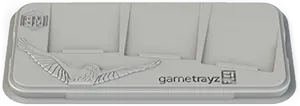 bird tray
bird tray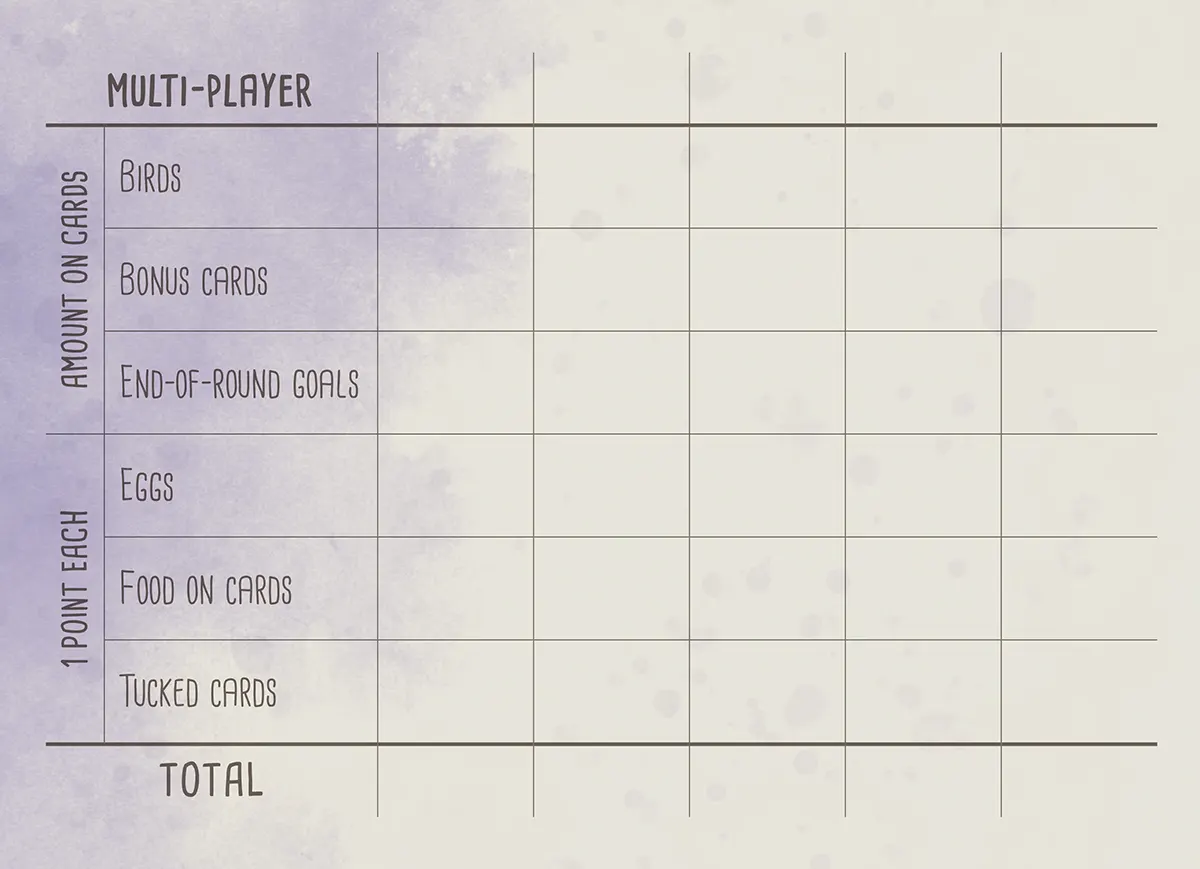
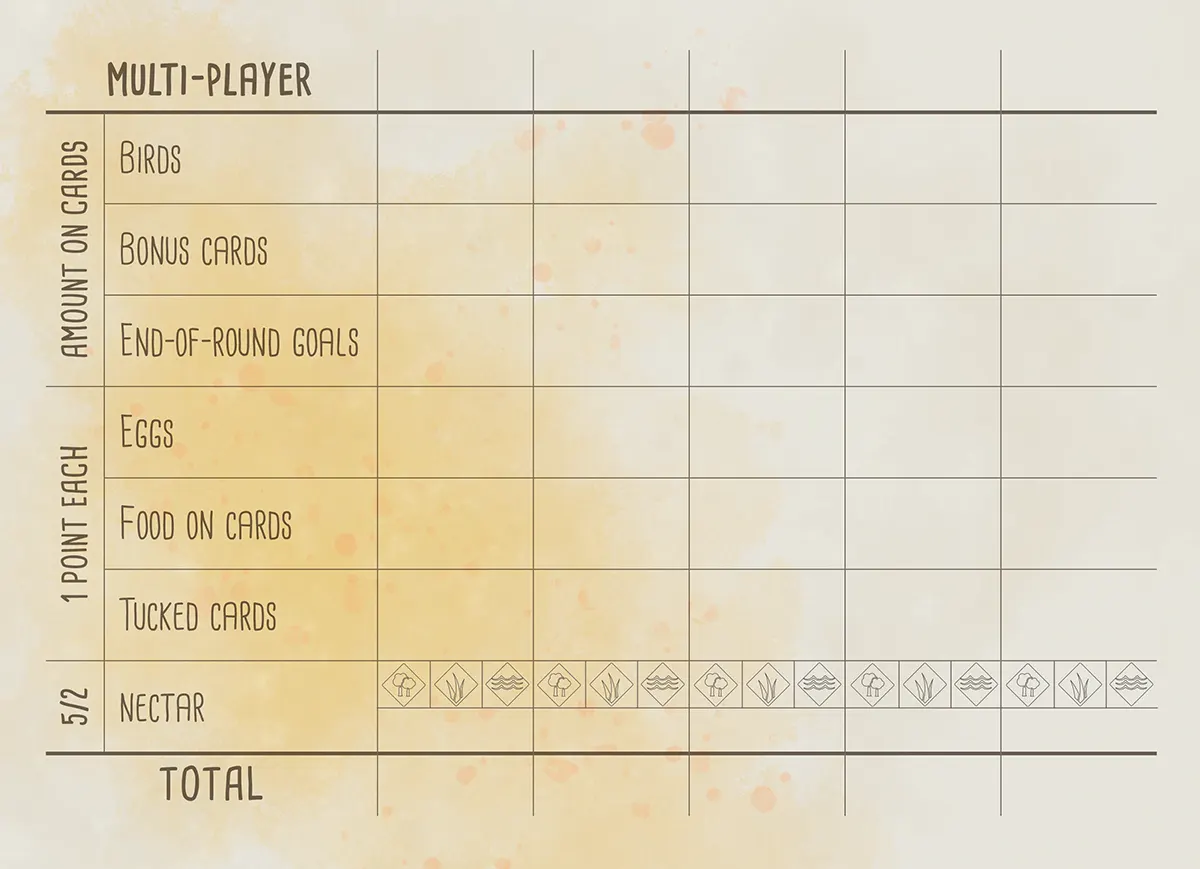 scorepad
scorepad
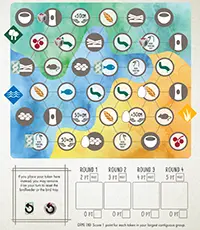 Duet map
Duet map

